

Catamaran Or Monohull? 27 Important Facts (Explained)
Catamarans and monohull boats are two very different kinds of vessels. Each craft offers distinct advantages and disadvantages that you’ll want to consider before choosing between the two.
In this post, we’ll go over some of the important things to consider when choosing between catamarans and monohull boats:
Table of Contents
Cost & Availability
Both catamarans and monohull boats come in small recreational sailing versions, larger motorboat versions, and larger sailing models. In all cases, the catamarans will cost more and will be harder to find.
The reason catamarans are harder to find because there are not as many of them, and they’re mostly made overseas.
Also, there aren’t as many catamaran manufacturers, so sailors have fewer options when buying them.
On top of this, catamarans have only recently become popular in the United States and other areas of the developed world. This means the used market for boats doesn’t have as many catamarans on it. You might find that you have fewer options when making a used catamaran purchase, which could bring costs up to a premium.
Two Times The Fun with Catamarans

Another reason that catamarans are more expensive than monohulls is the fact that catamaran buyers have to purchase two hulls, two engines, and two of all of the components that help make an engine work.
Traditional sailboats and large powerboats with one engine don’t have this cost issue.
On top of this, a catamaran is much wider than a monohull, and thus you have more space to build and equip.
On the other hand, once you’ve purchased the boat, you do get to enjoy the benefits of having two of everything. We’ll talk about the advantages of this further down in this post.
Maintenance Cost Makes A Difference
The maintenance on a catamaran is also more expensive than the maintenance on a monohull boat. This goes back to the fact that there is twice as much of everything to maintain.
Catamaran owners will need to do preventative maintenance on two different engines, and they’ll have two hulls and a large deck area to clean and maintain as well. If they’re getting the bottom of the boat treated, they’ll have to do this twice (once for each hull).
Even the interior components can usually be found twice.
Each cabin will usually have a head in it, so you’ll have at least two toilets and sinks to maintain, which obviously has its plusses and minuses.
One positive aspect of this is that catamaran owners do have the option of deferring some of their maintenance. For example, if one head is no longer functioning properly, you always have the second one that you can use.
It also adds a bit of safety as well.
This is because while the catamaran does have two engines to maintain, the owner does have power even if one of the engines happens to go down.
Some catamaran owners also like to point out that maintenance may not have to be done as frequently. This is because the engines don’t have to work quite as hard, and other items like additional bathrooms and sinks might only be used half as much.
How Much Space Do You Need?

A catamaran has more space than a monohull. This is because the boat is wider, and it has a much larger deck area. It also has twice as many hulls, so you have more overall space between the two of them.
The additional space is great for people looking to throw parties on their boats.
Most boat owners would agree that the catamaran is usually the party boat of choice at the docks.
Even if you aren’t into throwing parties, the extra space can still be nice for relaxing on the deck or getting a suntan. The wide-open space also makes it easy to use the boat as a fishing platform.
Additionally, you have more space for stuff like surfboards, rafts, and other items that can easily clutter up the deck of a monohull. Even fishing can be easier from a catamaran as the deck provides plenty of space between different anglers.
Catamaran owners also have additional space for carrying fresh water and adding generators and solar panels.
Interior space is generally more plentiful on a catamaran, and luxury catamarans have an easier time fitting large items like washers and dryers inside of them. You can have these on larger monohulls as well, but it will be harder to make them fit than it is in a catamaran.
On the other hand, all of the additional space means the catamaran owner has more space to maintain and clean. Also, all of the additional items that can be brought onto the boat will make it heavier. A heavier boat will use more fuel, and it will travel more slowly.
Living Quarters Vary Between The Two
The living quarters on a catamaran are much different than they are on a monohull. Most people would agree that the berths in a monohull are much more spacious than in a catamaran.
A monohull offers people the opportunity to have a large bed with space on either side to walk around it. This is great for couples who want to get out of bed without waking up their partner.
Catamarans, on the other hand, have the advantage of being able to offer large above-deck salon areas. The galleys, the dining areas, and the living areas can all be above-deck, while the two hulls can provide heads and berths.
Some boat owners say that living in a monohull is akin to living in a basement apartment . Other boat owners prefer the monohull because it brings them closer to the water and gives them the feeling of being at sea.
Privacy Can Be Prioritized On Catamarans
A catamaran offers up many different living areas that people can take advantage of. For example, each hull will typically have its own bathroom and bedroom.
This gives each sleeping area complete privacy from the other.
The living quarters are usually up on the deck, so early risers can wake up and move to these quarters without waking up the others.
The same holds for night owls. A night owl can stay up late without bothering the people who want to retire to their beds earlier.
With two hulls, large catamaran owners can hire a crew and give them their own hull to live in so that there is separation between the cruisers and the crew. This is a wonderful advantage for honeymooners looking to have their own space.
The downside to all of this, of course, is that sometimes a family may not want the additional privacy. For example, a family with small children might not want their children in a different hull than they are.
Additionally, the extra privacy can make it hard for people on the boat to communicate. This could become a big problem in the event of an emergency.
For this reason, it is often recommended that each hull have a radio in it so that the occupants can quickly communicate with each other. Remember, even in inland areas, cell phone reception may not be very good inside the boat hulls.
Recreation In a Monohull vs. a Catamaran
Most sailors agree that sailing a monohull boat is much more exhilarating than sailing a catamaran. Traditional sailboats heel, and sailors get instant feedback while they’re sailing. For the most part, catamarans stay stable, and you don’t get the same feeling with the movement of the wind and the water.
When it comes to monohull powerboats, you have the advantage of being able to pull water skiers, kneeboarders, and tubers with ease, as long as the boat has the power and a planing hull. A power catamaran usually doesn’t have the speed or maneuverability to pull off these recreational opportunities because they are displacement hull designs.
Catamarans excel in more leisurely recreational activities. A catamaran makes a great party deck as well as a great cruising deck. Catamaran owners can comfortably walk around a catamaran without having to worry that the boat might knock them over the next time it decides to heel. This allows boaters to sit and talk with one another comfortably.
A catamaran can also be used as a beaching vessel. This makes it a great platform for people looking to go swimming or fishing around sand bars and other shallow water areas. It also makes it a great boat for sailors looking to sail a larger boat on a river or lake known for having shallow areas.
Swimming and Diving
Swimming and diving off of a catamaran are usually much easier than doing the same from a monohull. The wide stance of the two hulls offers boat designers the option to put in staircases at the back of both hulls.
In between these staircases, some boats will have an additional diving platform and/or a dedicated frame for pieces of equipment and dinghy storage. This makes catamarans great for swimmers, snorkelers, and divers.
On the other hand, modern monohull sailboats can also have good transom stairs for easy access to the dinghy and swimming. Both types of boats can easily travel far out to sea, giving boaters the option of diving in areas that can’t be accessed from beaches and developed areas.
Boat Draft In Shallow Waters
For the uninitiated, the boat’s draft refers to how deep the boat’s hull sits within the water.
A monohull typically sits deep within the water, while a catamaran sits much higher on the water. This is why we stated that a catamaran is good for shallow waters.
The advantage of having a boat that can go into shallow waters isn’t restricted to just recreational activities like swimming and fishing. A boat that can go into shallow water is safer to operate in areas where a boat with a deeper draft might become damaged.
Additionally, a catamaran has more stability on calm waters. This helps make a catamaran more comfortable to relax or sleep on while at anchor or the dock.
The deeper draft of a monohull boat has its advantages as well. A deeper draft provides more stability in rough waters and allows a boat to go further into the sea.
For this reason, many coastal cruisers will prefer catamarans, while many ocean voyagers will prefer monohull boats. In fact, some areas of the Caribbean and the Florida Keys can be off-limits to boats with deep drafts as it simply isn’t safe for the boat to navigate these waters.
This isn’t to say that you can’t navigate these waters in a monohull boat, but you will have to be cautious depending on how deep your monohull’s boat draft is. You wouldn’t have this issue in a catamaran.
Stability On The Sea

A catamaran offers a lot more stability in shallow waters, in calm waters, at the dock, and anchorage. This makes the boat great for cruising and for relaxing in port.
A monohull offers a lot more stability in rough waters.
This makes this boat great for heading out to sea and for navigating vast distances.
Safety Issues To Consider
Both catamarans and monohulls can be built to navigate the waters they were made for safely. This will be determined more by the boat’s category designation rather than the type of boat.
However, each boat deals with unsafe situations in different ways. For instance, a monohull boat is likely to right itself if it is capsized.
This means that even in rough seas, you’re unlikely to find yourself permanently capsized.
The downside to this is that should you become completely swamped from a capsize in a monohull boat, you are much more likely to sink. In fact, if there is a hull breach on a monohull boat, your boat could sink.
Catamarans are said to be unsinkable. This isn’t completely true, but it is very unlikely that a catamaran will sink. Even if a hull is breached, you still have a second hull to keep the catamaran afloat.
However, a catamaran can’t right itself. If you capsize your catamaran, it will stay capsized.
One other safety concern to consider is that a monohull sailboat will heel while a catamaran will not. This increases the chances that someone could fall off the boat or onto the deck in a monohull boat.
Catamarans Are Faster Than Monohull Boats
A catamaran is faster than the average monohull boat.
This is because they face less water resistance, and their narrow hulls don’t have to deal with their own bow waves as a monohull does.
Of course, catamarans aren’t always faster. Old cruising catamarans may not go faster than 8 knots, and modern monohulls can exceed 10 knots.
Monohull boats tend to sail downwind and in choppy seas better than catamarans. This gives them a speed advantage during ocean voyages.
We have a separate post with complete average speeds per type of catemaran . It’s a must read if you are at all concerned about speed!
Fuel Consumption Considerations
Catamarans have two engines to burn fuel, which can drive up fuel costs.
However, a catamaran is lighter on the water, so it usually takes less energy to move a catamaran. This means you’ll end up using less fuel in a catamaran than you would in a monohull.
On top of this, catamarans can decide to use just one engine in low wind areas. This further decreases the amount of fuel that a catamaran consumes.
These rules only apply to calm waters.
A monohull navigates waters with high waves and strong winds much more efficiently than a catamaran. In this case, you’ll use less fuel in a monohull than you would in a catamaran.
Sailing Differences To Notice
Sailing a monohull boat can be exhilarating. These boats can glide through choppy waters, and you get to feel the motion of the boat as the sea rushes by the cockpit and the wind causes you to heel.
This type of sailing also provides instant feedback as you’ll know what you need to do with the sails as you’ll feel what is going on through the boat’s motion.
Sailors all over the world have been using monohull sailboats for years, and you’ll find plenty of outlets for recreational sailing with a monohull sailboat.
Sailing catamarans do not heel like a monohull sailboat.
These boats, therefore, do not provide the sailor with instant feedback. Also, if you incorrectly sail a catamaran, you do risk capsizing the boat more easily.
Training Can Be Quite Hard
Sailing a catamaran and sailing a monohull boat are two different experiences. People looking to sail either should probably get professional training.
Obtaining this training will always be easier with a monohull boat.
This is because monohulls are more popular, so you’ll have more instructors available to you.
Do You (Or Your Friends) Get Seasick?
People who are prone to getting seasick easily might want to consider a catamaran. A catamaran provides much more stability in calm waters, and you get a lot less movement.
On the other hand, people who are not prone to getting seasick might prefer a monohull in choppy waters.
This is because a monohull will deal with deep and choppy waters with high waves much better than a catamaran will.
As a result, a catamarans movement can seem extreme under these types of conditions. People who have never gotten seasick before can end up sick under these conditions.
Here’s a separate article we wrote with everything you should know about seasickness on Catamarans . There are some things you can do and some things you should know!
Docking Is (Usually) Easier With A Monohull Boat
Docking a catamaran can be a difficult endeavor.
This is because catamarans are often too wide to be docked within the slips located in central areas of a marina.
Because of this, they need to be docked at the end of the dock. This leaves them with fewer spots to dock. It also makes docking more expensive.
Catamaran owners traveling through areas that are unlikely to have many catamarans in them may find it difficult to find a dock at all. This is true in areas of the northern Atlantic where monohulls are much more popular than catamarans.
Storage Issues To Consider
Even storing a catamaran can be more difficult. This is because storage facilities often do not have the equipment to get a catamaran out of the water.
The wide width of these boats requires special lifts, and not all boat marinas will have them.
Storage facilities that do get the catamaran out of the water will often charge more money for it. They’ll charge additional fees for taking the catamaran out of the water, and they’ll charge additional fees for the actual storage of the boat as well.
Redundancy And Backup Equipment
We touched upon this earlier, but it is worth repeating that catamarans have many redundancy built into them. This can be a big advantage when it comes to safety.
For example, if one rudder becomes inoperable, the boat can still be steered with the other one. If one engine becomes inoperable, the boat can still be driven with the other one.
In extreme cases, a hull could become damaged, and you could still stay afloat because the other hull will keep the boat safely above water. These safety advantages can save lives and keep people from becoming stranded out at sea.
The primary downside is the maintenance issue that we mentioned earlier. All of these redundant components will need to be maintained. As a result, maintenance costs will be close to twice as expensive in a catamaran.
Cooking Is Easier On Catamarans

Cooking on a catamaran is usually easier than it is on a monohull. The main reason for this is that a catamaran doesn’t heel like a monohull, so you don’t have to worry as much about things falling over.
This not only makes cooking easier, but it makes cooking safer as well.
Additionally, catamaran galleys tend to have more space in them to move around. Also, they are often up on the deck, so you don’t have to climb in and out of the hull with your dinner in hand.
Dinghy Storage
Monohulls and catamarans can both hold dinghies. The larger the boat, the larger the dinghy can be.
However, catamarans have a wide area at the rear of the boat that is perfect for holding dinghies.
This makes getting in and out of the dinghy easier. Also, people can often have larger dinghies on their catamarans because the boat’s stern is so accommodating.
Power Generation Is Easy On A Catamaran
A catamaran has a lot of space for solar panels and wind turbines. Rigid panels can be placed in areas that won’t be walked on, like overtop of the bimini, and flexible panels can be placed in areas where the panels might end up getting stepped on.
The width of a catamaran even gives them more opportunities to put hydro generators into the water.
This means catamarans can generate more power than the average monohull boat can generate.
On the other hand, a monohull usually has less powered items to worry about. Monohulls need less power to operate at full capacity, so you may not need all of the additional space for generating power.
Ventilation Issues To Think About
Some people feel that monohull boats don’t offer enough ventilation. This is especially true in warmer areas of the world.
Catamarans also lack ventilation within their hulls, but fortunately for them, much of the living space is located up on deck. This gives catamarans an edge when it comes to cruising in warm weather.
On the other hand, monohull owners aren’t exposed to the cold winds that you might find up on deck in harsher climates.
This lack of airflow may actually be of benefit in this instance.
Some people find monohulls to be better looking than catamarans and vice versa.
This all comes down to personal preference, so you’ll have to decide for yourself which type of boat has the advantage in this case.
Some people think catamarans are the most elegant thing in the world while others prefer monohull boats as they look more classic.
Resale Value Is An Important Factor
If you read our extensive guide to boat depreciation per boat type , you know that no matter what boat you buy, it will always go down in value. This is just a sad fact of boat ownership that people need to consider before buying a boat.
Many factors go into how much you’ll be able to get for your boat when you resell it. These factors are the condition of the boat, the age of the boat, and the economy in general. For example, people are less likely to want to buy boats during a recession. This is especially true when it comes to smaller boats.
However, one additional factor that catamaran owners need to consider when thinking about resale value is the value of the dollar.
People from the United States don’t have many American catamarans to choose from and will usually need to buy these overseas.
This means that a catamaran will be less expensive to buy when the dollar is strong compared to the Euro and more expensive to buy when the dollar is weaker in comparison. This will affect the used market as well because higher values on new catamarans can help to bring up the value on the used market.
With a monohull boat, you may not have to consider situations like this as there are makers of monohull boats all over the world.
Don’t Let The Length Trick You!
One thought to keep in mind when comparing monohull boats and catamarans is that their different shapes account for different space advantages.
For example, a 40-foot long catamaran will have much more cubic space than a 40-foot long monohull.
Because of this, when comparing boats, you should look at the cubic space rather than the length. In this case, you may be comparing a 48-foot long monohull with a 40-foot long catamaran.
When you compare the two types of boats in this manner, the price differences aren’t quite as large, and the comparison is fairer. It also may make the operating and maintenance costs more similar.
This is an important distinction to make because the length of the boats can trick you!
Consider Trying Both (Before Buying)
Boats can be an expensive purchase, so it makes sense to try them out before you decide to make your purchase.
Rent each type of boat and use it on the types of waters that you intend to cruise on the most.
Try the boat out in different weather conditions as well, and don’t be afraid to do multiple rentals before you make your final choice. The time and money invested into making sure you get the boat you really want will be more than worth it in the end.
Click to share...
- Marine Supplies
- Maintenance & Boating Guides
Catamaran vs Monohull: Pros, Cons & Main Differences
By: B.J. Porter Editor

The choice of catamaran vs monohull ultimately comes down to preference. What’s critical for one buyer may mean little to another. If your partner refuses to set foot on a boat which heels, that’s a deal-breaker for a monohull. But if you’re passionate about classic looks and styling, your quest for beauty may override other considerations and rule out catamarans.
We can’t tell you whether a catamaran or a monohull is right for you. But we can help you with the pros and cons of each for your search.
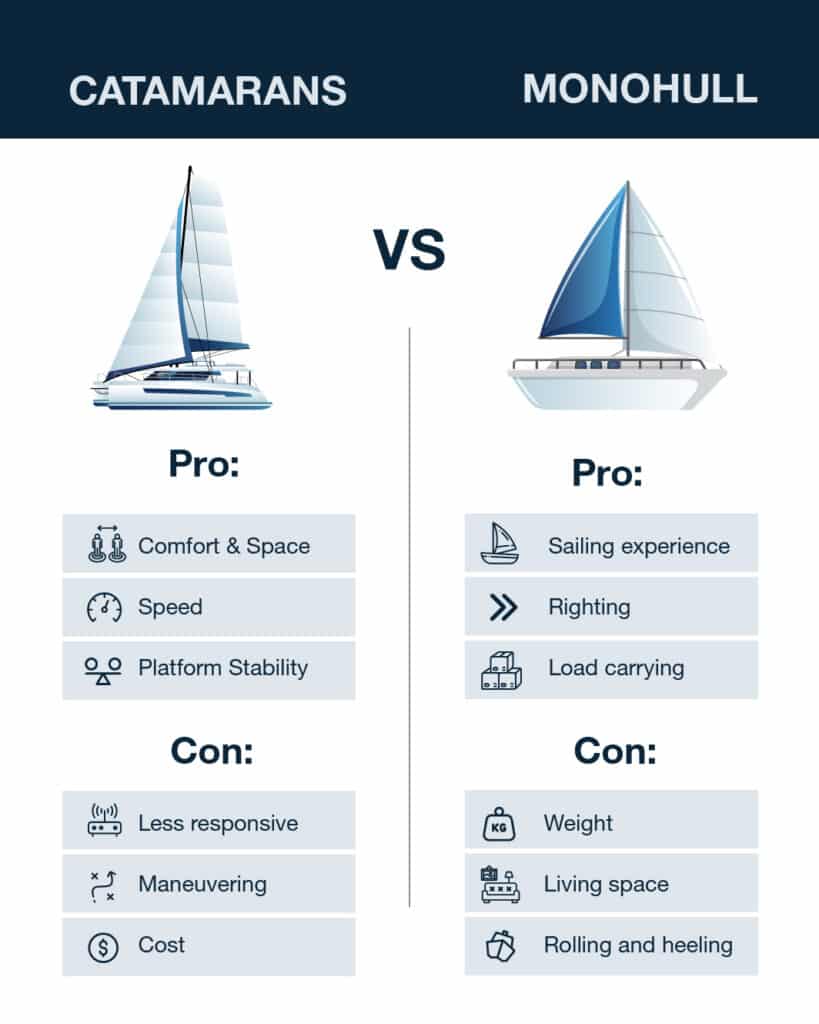
The Strengths and Pros
No matter your choice of monohull or catamaran, there are safe, comfortable, and excellent sailing boats of both types. Neither has an exclusive lock on any strength, and both sail safely and comfortably. But there’s a different emphasis on how they do it. No matter what you are trying to do – sail fast, cruise the world, or just host a crowd at the dock, there are monohulls and catamarans that can work for any requirement.
Catamaran advantages
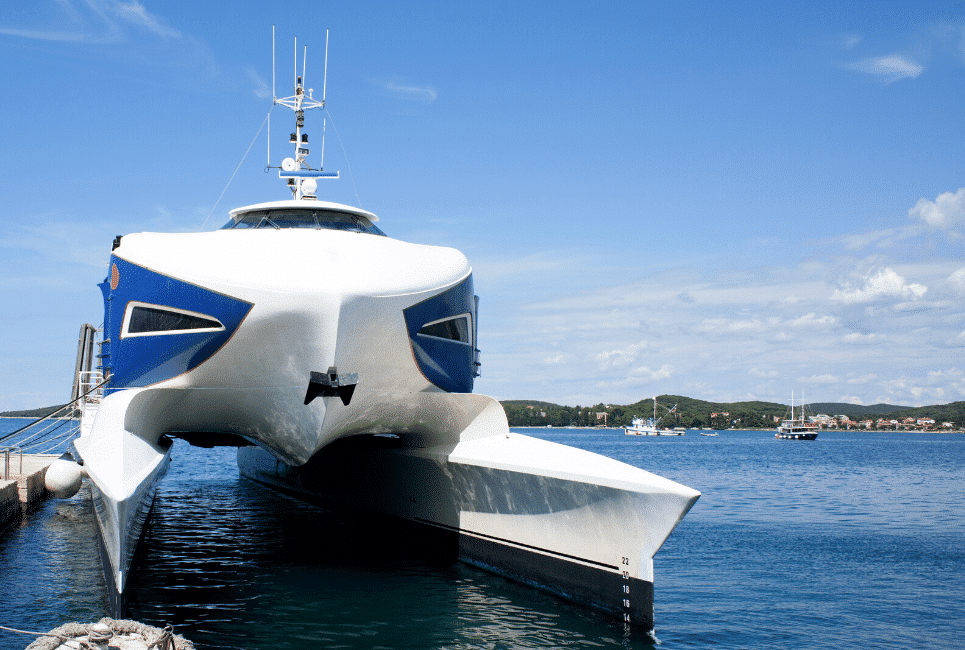
Space and comfort: Two hulls and a wide beam make a very stable platform with lots of volume in the saloon and cockpit. Most living space is above the waterline, with wonderful light and airflow. Cabins in the hulls offer better privacy and isolation, usually with standing headroom.
Straight line speed: Most catamarans are faster in straight-line sailing speed (1) that similar sized or even longer monohulls. Without a lead keel, they’re lighter, so more driving force from the sails converts to speed, and narrower hull forms may have less drag than wide hulls with deep keels. Some heavier cruising catamarans may not be faster, especially if they keep rig size small for ease of handling.
Stability : The beam of two hulls with a bridge deck leads to much higher stability and resistance to roll (2). Waves in an anchorage that induce violent roll in a monohull may make a catamaran bounce or bob. Under sail, catamarans do not heel appreciably even when powered up.
Twin engines. : With one engine in forward and balanced in reverse, most catamarans can spin in a circle in place and make sharp adjustments to the boat’s direction. If you have an engine failure, you also have a second engine, giving a safety edge when you can’t sail.
Monohull advantages

Upwind sailing performance: While catamarans have the edge at straight-line speed, monohulls sail closer to the wind. When you’re racing or you have to sail upwind to get to the next island, this can get you there faster.
Sailing feel and responsiveness : The “feel” of sailing a monohull is much better. With a single hull, you’ll feel wind pressure and trim adjustments immediately for a more responsive helm and a better ability to sail to the wind.
Maneuvering under sail: Monohulls are quite nimble tacking and turning under sail, and there’s less risk of slow or missed tacks.
Righting Moment: The primary offshore safety argument for monohulls is their ability to right when capsized. The heavy keel keeps the boat deck up when sailing, and most monohulls will come back upright even after a complete capsize.
Cargo and Loading: A higher displacement boat with thousands of pounds of lead hung from the bottom isn’t going to be as affected by loading as a relatively light multihull.
Aesthetics: This is subjective, as many catamaran enthusiasts love how they look. Classic sailboat styling, with swept sleek looks, springy sheer lines, and all the “right” proportions are more common on monohulls.
Also read: The 5 Best Electric Anchor Winches
Weaknesses and Cons
Like strengths, weaknesses are relative; just because one class has a strength doesn’t mean the other doesn’t. There are spacious monohulls and beautiful catamarans, just like there are cramped catamarans and unattractive monohulls. The differences have to be highlighted relative to each other, and the weaknesses of one are most apparent compared to the strengths of the other.
Catamaran Cons
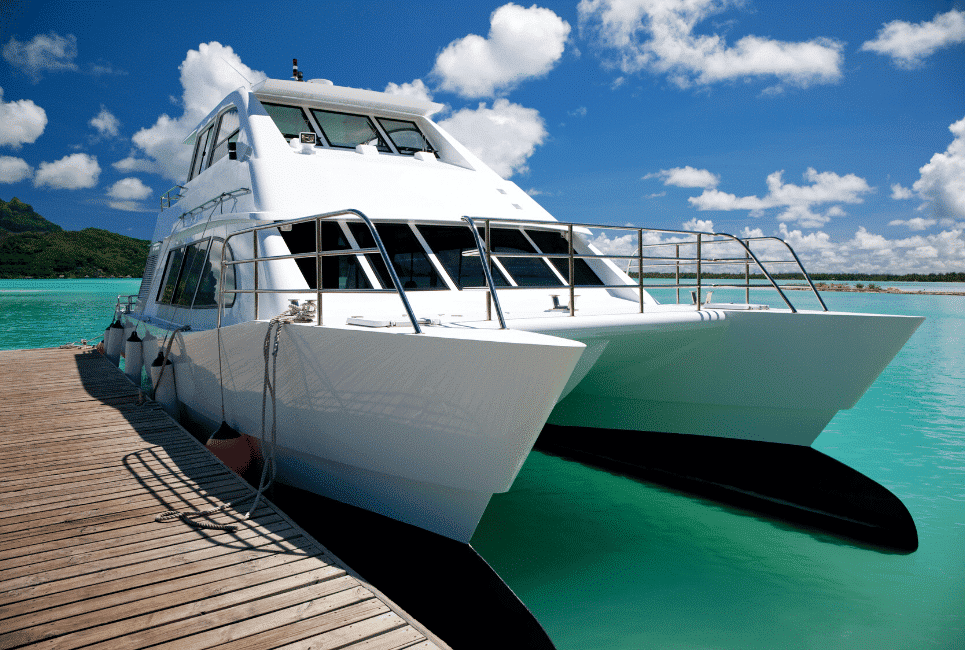
Upwind performance: Cats don’t sail as close to the wind, but they make up for it by sailing faster off the wind. You’ll sail a less direct course upwind. Even if you get in at the same time, you’ll have to sail farther.
Less responsive sailing: Two hulls with two rudders and a very broad platform reduce the helm feel when sailing, cutting responsiveness sailing in shifting wind and wave conditions. It also makes tacking slower.
No-flip zone: It is very difficult, but not impossible, to flip a large catamaran (3). But if a catamaran capsizes, it will not flip back over by itself.
Large in marina/close quarters: You have two problems in marinas. Beamy cats are tough to maneuver in tight spaces because they’re big and visibility is tough over the hulls. And many marinas charge extra because the wide beam extends into the next slip. The good news is that twin engines make tight maneuvering easier.
Price point: Catamarans are more difficult to build and need more materials. This is directly reflected in the cost of the boats.
Monohull Cons
They are heavier: Every large monohull needs a keel for stability (4). They can not sail or stay upright without thousands of pounds of ballast, and this makes them heavier and slows them down. Tiny monohulls can use a centerboard or daggerboard for stability, but most boats big enough to sleep on need ballast.
Darker interiors : Most monohull living space is lower in the boat, where you can’t put enormous windows for light and circulation. It’s very hard to get space as bright and airy as catamaran saloons.
Less living space: With one hull and no bridge deck saloon, most monohulls feel cramped compared to spacious catamarans.
More prone to rolling motions : Only one hull makes monohulls susceptible to rolling in waves, and the movement can be quite uncomfortable.
Heeling: Tipping is just part of sailing monohulls upwind and is unavoidable. It can be reduced on some other points of sail, but not eliminated. Many people, especially non-sailors and new sailors, find this movement uncomfortable or distressing.
You might also be interested in: How to Buff a Boat | A Detailed Guide by a Boating Expert

Troubleshooting Pontoon Boat Battery
Pontoon boats are a great way to enjoy the water and spend quality time with family and friends. But just like any other boat, they rely on a battery to power various systems, including navigation lights, trolling motors, and other…
Boat Accessories

Best Ice Fishing Fish Finders in 2023
In search of the best ice fishing fish finders in 2023? Not all fish finders are created equal, particularly when it comes to ice fishing. Specialized features are crucial to ensure successful outings in harsh winter conditions. You require a…

Best Side Imaging Fish Finders in 2023
Navigating the world of angling equipment can be challenging. That's especially true when it comes to side imaging fish finders, given the extensive range of options available in 2023. This post makes it easy for you to narrow down your…

How to Choose a Fishfinder for Your Boat: A Comprehensive Guide
Today, we embark on a journey to unravel the secrets of choosing the perfect fish finder for your boat. As we navigate through an ocean of options, we'll explore different types of fish finders, delve into their key features, and…
Accessories
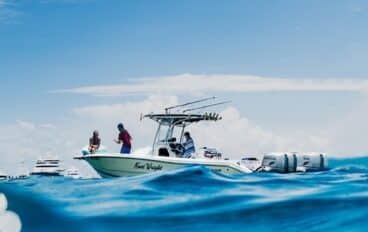
5 Best Portable Fish Finder in 2023
Looking for a portable fish finder for kayaking, ice fishing, or other activities? The good news is that there are a lot of solid products out there. The year 2023 has ushered in an array of advanced models, each brimming…
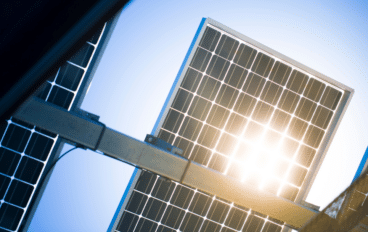
Charging Your Trolling Motor Battery with a Solar Panel
Charging your trolling motor battery with a solar panel is not just the right thing to do for the environment, it is extremely convenient. When you’re out on the boat, with any luck, you’ll have access to a good amount…
Don't miss out

Catamaran vs Monohull - 6 Points To Consider Before Choosing Your Boat
Multihull or monohull? It’s an age-old (and ongoing) debate, and each option certainly comes with its own set of pros and cons. Whether you’re thinking of investing in a boat of your own, or planning on chartering one for a sailing holiday, one thing’s for sure: the type of vessel you select will have an impact on your cruising experience. Ultimately, what you intend to use it for will determine which type of boat would be best suited for the job. In this article, we considered the aspects of space & design; safety; stability; speed; manoeuvrability and cost, so do read on for our comparison of the multihull catamaran vs the monohull sailboat.
THE CATAMARAN VS THE MONOHULL – A COMPARISON
1. stability . which is more stable, a catamaran or a monohull.
Fact – by virtue of having two hulls, both under sail and at anchor, catamarans are more stable than monohull boats. If you are sailing with young children, seniors – or anyone who’s not all-too steady on their feet – a catamaran will provide you with a much smoother and stable cruising experience than a monohull. Being multihulled, catamarans are not nearly as susceptible to the action of the ocean’s waves. This prevents them from heeling as much as monohull vessels would under the same conditions. As anyone who suffers from seasickness will tell you, this can be an enormous bonus. What’s more, a cat’s multihull stability will also be highly appreciated by anyone prepping food in its galley (two hulls make for a somewhat more pleasant dining experience, too). Lastly, because of its superior stability, walking around the deck (and moving around the interior) of a catamaran is much easier than it would be on a monohull. The verdict? Catamarans are more stable than monohulls.
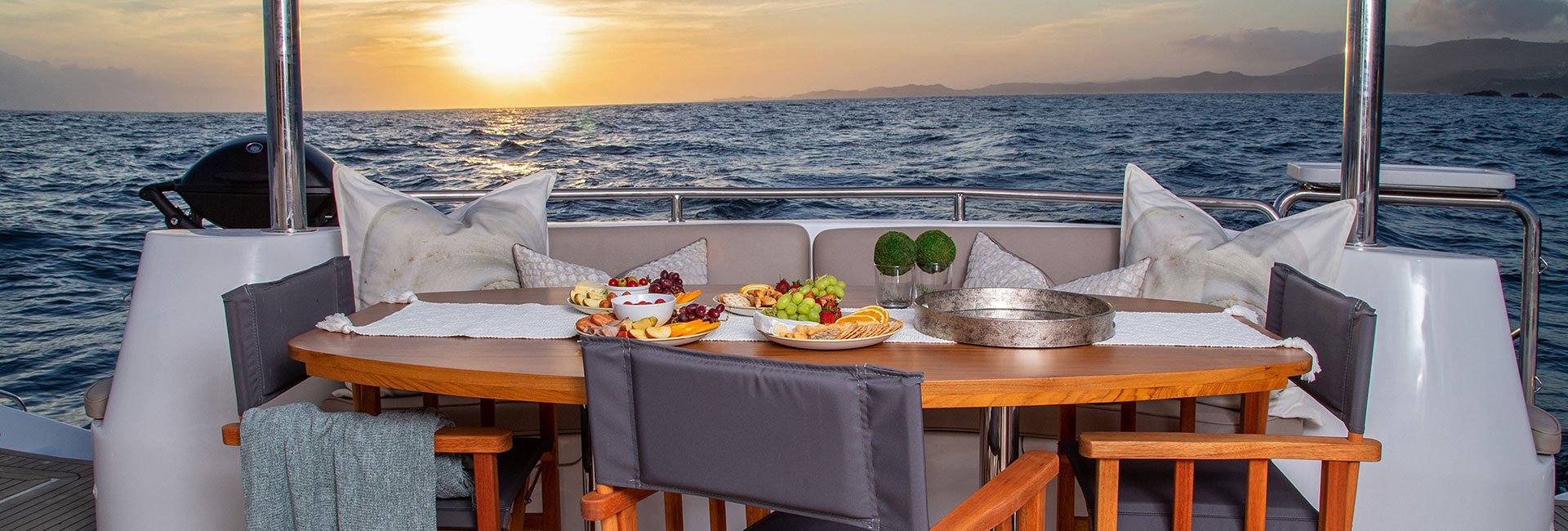
2. SAFETY . WHICH IS SAFER – A CATAMARAN OR A MONOHULL?
The inherent stability and natural buoyancy of a catamaran automatically increase its safety while out at sea. As catamarans don’t have heavy, lead-loaded keels, they will remain afloat, even when (heaven forbid) they are holed. This is because most modern catamarans have such a large amount of buoyancy built into them that they are almost unsinkable, making them much safer than monohull sailboats in this regard. Sure, catamarans can capsize, but being rescued from an upside-down, still-floating multihull is definitely preferable to sinking to the bottom in a monohull! The verdict? Contemporary catamarans are incredibly buoyant and virtually unsinkable, making them safer than monohull sailboats.
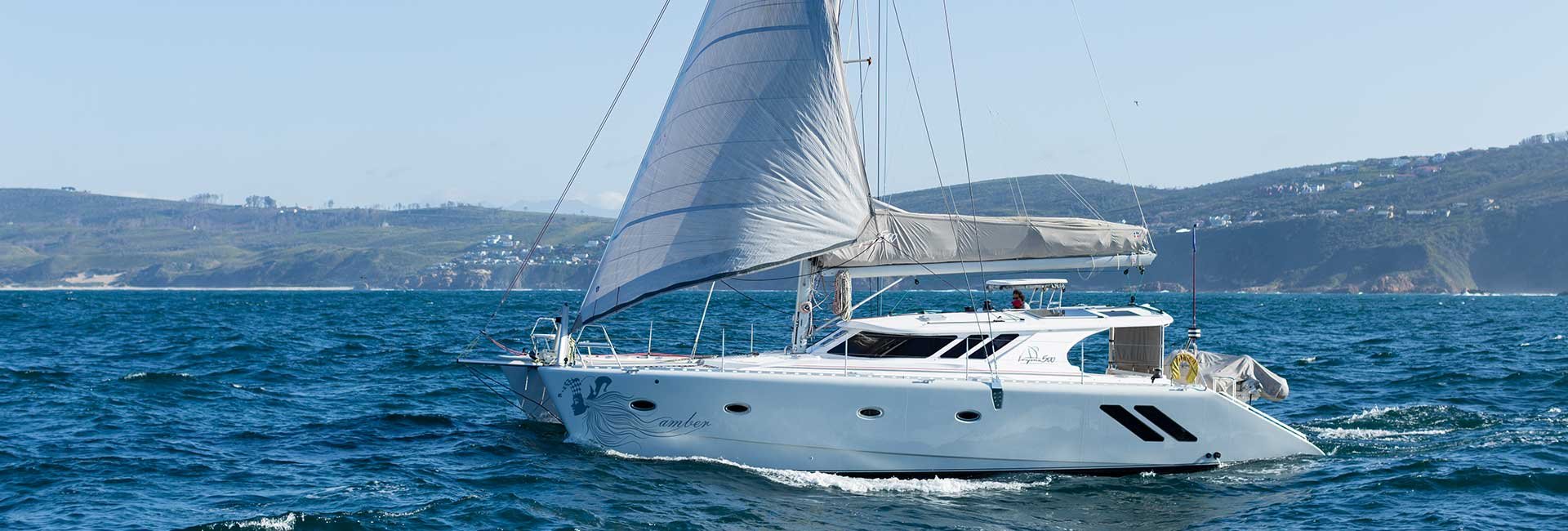
3. SPACE & DESIGN . WHICH IS MORE SPACIOUS AND PRACTICAL – A CATAMARAN OR A MONOHULL?
Due to the boat's shape (and the amount of usable space each design allows), when compared square-foot-for-square-foot, every area of a monohull vessel is usually smaller than its catamaran counterpart. Generally, catamarans offer more room to move in its galley, cockpit and saloon areas than similarly priced monohull boats. Often, catamaran cabins are more spacious too, with cabins of even the smallest cat offering stand-up headroom. Catamarans are also generally more private than monohulls, and more straightforward when it comes to separating living spaces. This can be a significant advantage when you are cruising with children or guests. As most of a cat’s living spaces are above the waterline (on a monohull, only the cockpit is above the waterline), you’ll also enjoy superior airflow through ventilation on a catamaran. If you’re a scuba-diving enthusiast, carrying all of your diving equipment will be easier on a cat. What’s more, catamarans have trampolines, which make them perfect for onboard sunbathing as well as stargazing in the moonlight – a big, romantic plus for sure! Catamarans also have shallower drafts, allowing you to drop anchor closer to the beach than a monohull would. The verdict? Compared square-foot-for-square-foot, catamarans are more spacious than their monohull counterparts. In terms of design, a catamaran is perfect for onboard sunbathing and stargazing and will allow you to anchor closer to shore.
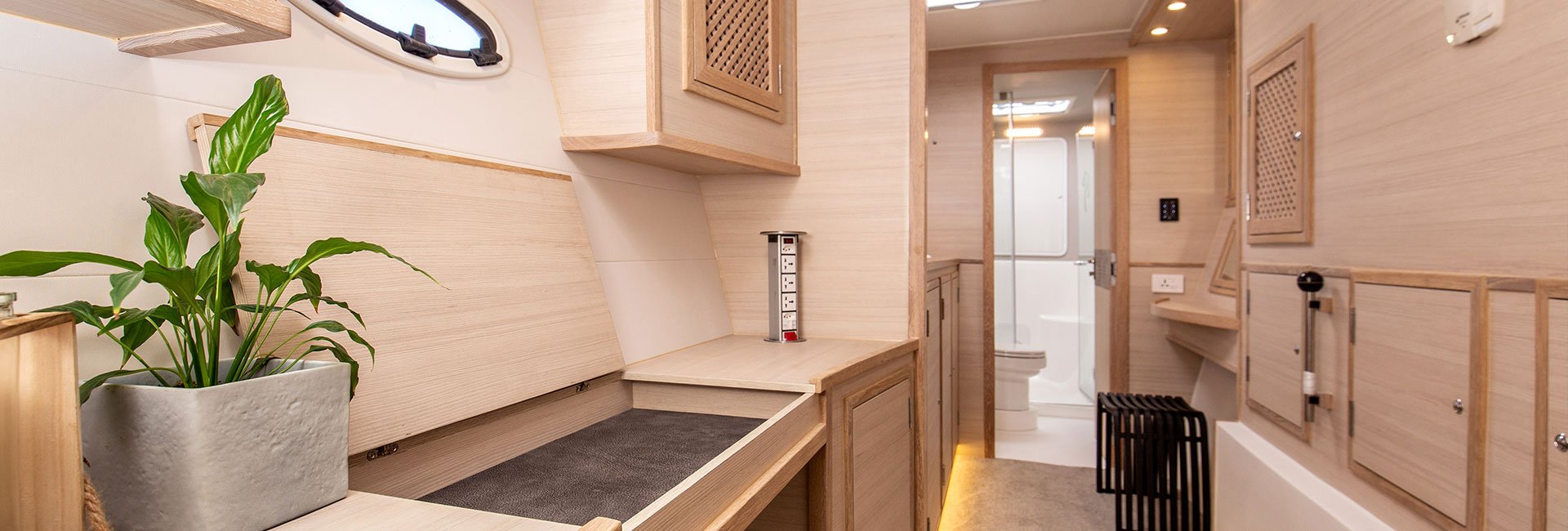
4. MANOEUVRABILITY . WHICH IS EASIER TO STEER, A CATAMARAN OR A MONOHULL?
Most catamarans can turn 360 degrees within their own length, something very few monohulls are capable of doing. However, generally speaking, monohulls are quick to tack, more manoeuvrable, and quicker to respond to the helm than catamarans. At the helm of a catamaran, you’ll get less feedback from the wheel than you would from a monohull. This will require you to be vigilant in rough conditions, and you’ll also have to know when to reduce sail. Compared square-foot-for-square-foot, catamarans are much lighter than monohulls, which means they also slow down a lot quicker. For the most part, catamarans are easier to dock than monohulls, as they have two motors and two rudders which simplify things a lot. This also does away with the need for a bow thruster. The verdict? We’re calling it a tie. Although monohulls are generally more manoeuvrable than catamarans, thanks to their two motors and two rudders, cats are easier to steer than monohulls.
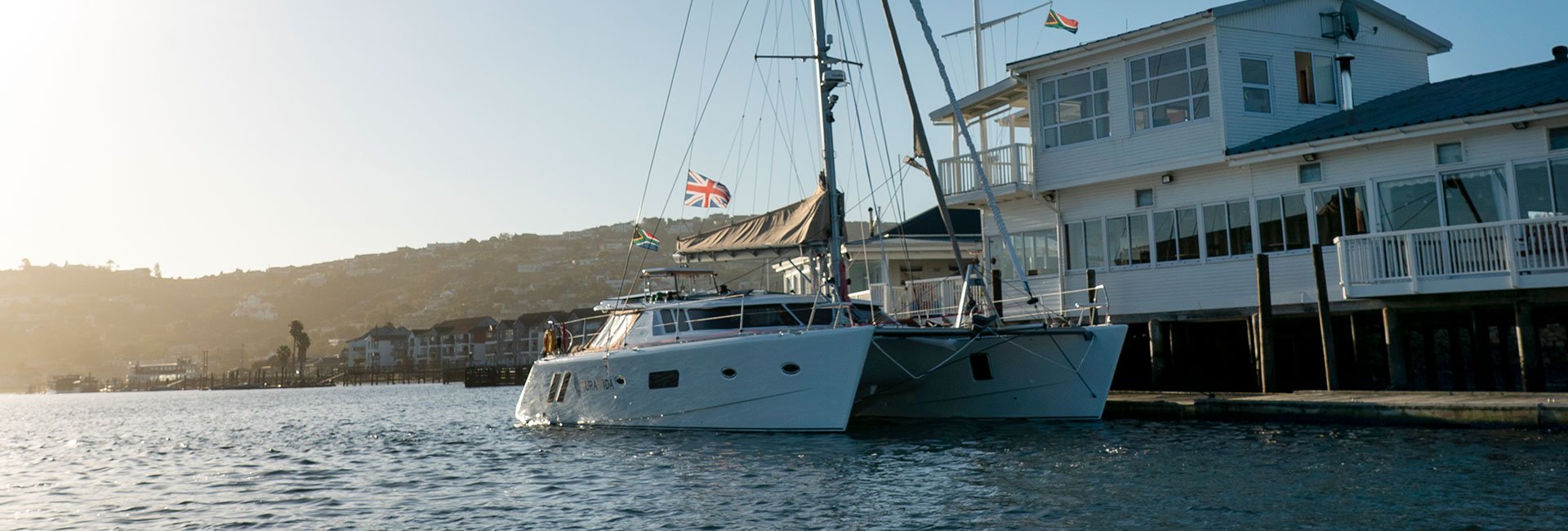
5. SPEED . WHICH IS FASTER, A CATAMARAN OR A MONOHULL?
Although catamarans cannot sail as close to the wind as monohull sailboats, most cats do sail faster than a monohull on a reach. On downwind runs, reaches, and broad reaches, in particular, catamarans usually beat monohulls when it comes to speed, going about 20% faster than a monohull (even outrunning bad weather when necessary!). Another plus is that sailing a catamaran requires less physical exertion than sailing a monohull. The verdict? Even if they don’t point as high into the wind, catamarans are faster than their monohull counterparts.
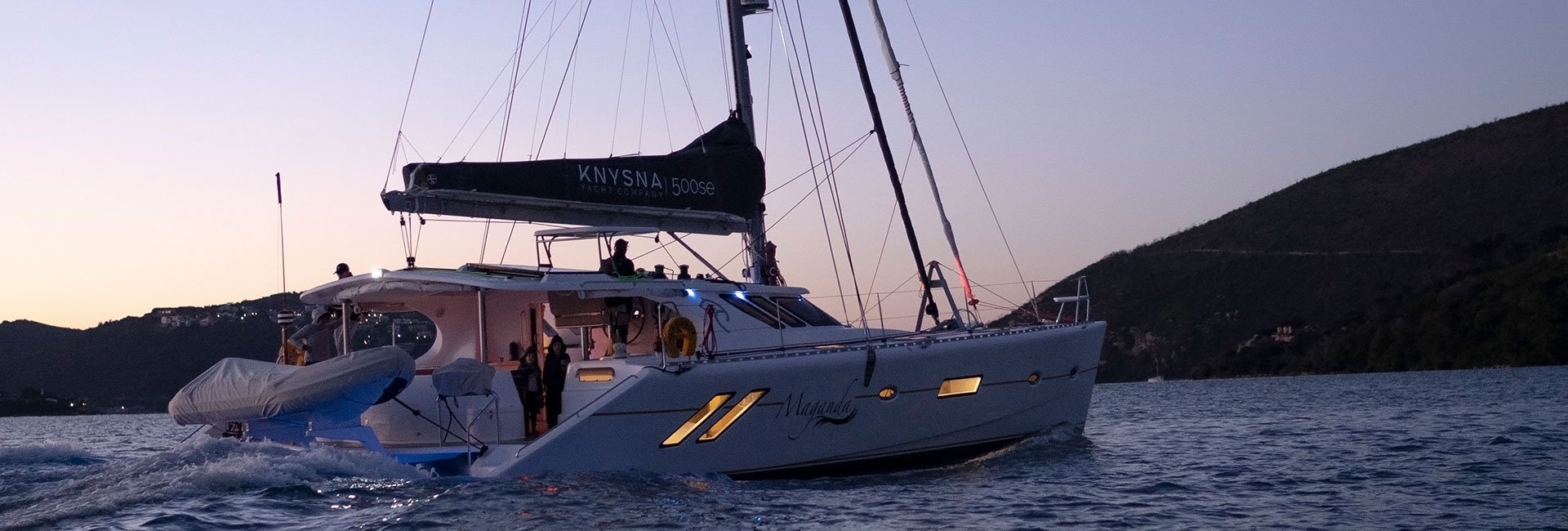
6. COST . WHICH IS MORE EXPENSIVE, A CATAMARAN OR A MONOHULL?
Generally speaking, catamarans with similar sleeping capacity and equipment are more costly than their monohull counterparts (both to own or to charter). Just keep in mind that catamarans typically hold their value better and longer (and tend to be in higher demand) than monohulls. Comparatively, previously owned monohulls are cheaper to purchase than cats, as supply tends to outweigh demand by a large margin. The verdict? Catamarans are more costly than monohull sailboats. However, a read-through of Points 1 to 5 might convince you that they are worth the extra expense.

CATAMARAN OR MONOHULL? – YOUR NEEDS WILL DETERMINE YOUR CHOICE
Looking at the list of pros and cons above, it would seem that the catamaran comes out the clear winner – at least when judged on aspects of safety, space & design, speed and stability. However, your budget, the requirements of the people in your sailing group, as well as your own needs and preferences will all play a significant role in the boat you end up choosing. Both catamarans and monohulls offer unique advantages, and whichever choice you go with, we wish you many happy ocean voyages and an abundance of adventure! Ps. If you’re still unsure which option is the right one for you, why not check out the verdict from ocean adventurers who have lived aboard two monohulls and four catamarans over the past 25 years?
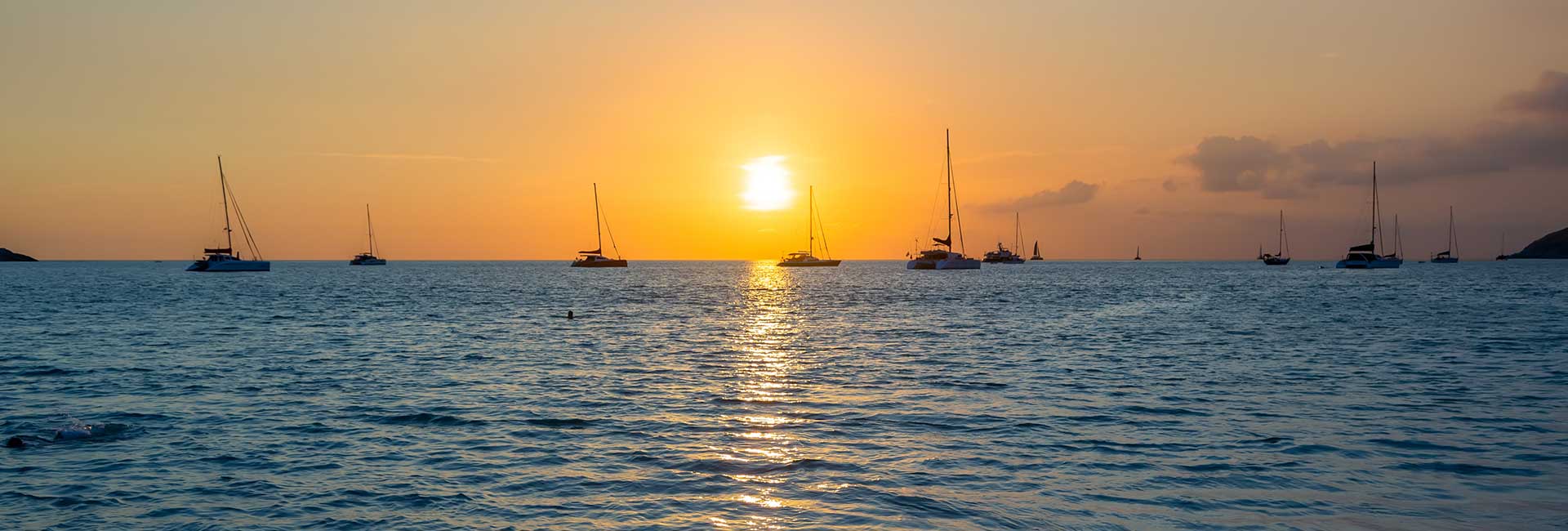
Yacht Maintenance - Top Tips for Protecting Your Investment
Essential things to know about boat insurance, top things to know about yacht solar power, building a yacht: top things to know about the yacht-building process, get all the latest to your inbox, discovery awaits.


Catamaran vs. Monohull: We Changed, Should You?

There are two schools of thought when it comes to monohull versus catamaran . We have done extensive cruising and lived aboard two monohulls and four catamarans over the past 25+ years . We experienced the good and the bad for both single hull and multihulls first hand. Quite honestly, the pluses for catamarans far outweigh the minuses. There are multiple benefits of catamarans. They are faster, more stable and spacious, and have shallower drafts allowing safer anchorage closer to shore. Being on a stable platform with no heeling cuts down on crew fatigue and seasickness leaving the crew more alert and in control of the vessel. Even novice sailors feel more confident on catamarans.
When we built our monohull Royal Salute in the early 90s, catamarans were not established and were looked upon with extreme suspicion by most cruisers, including ourselves. “Safety and the capsize” issue were always the first things to come up against sailing catamarans. It is a fact that monohulls can get rolled in heavy seas but will right themselves because of the heavy lead keel, and while crew and vessel will be battered, the roll is survivable.

However a catamaran once capsized, will remain upside down (jokingly referring to this state of the catamaran as “reaching its most stable position when upside down”). The inability of a catamaran to self-right was and still is a major bone of contention. However, what is not often discussed is that a monohull has about a 5,000 pound keel of lead that is constantly trying to drag the boat to the bottom of the ocean versus a catamaran that has no ballast and is in most cases with modern catamarans, unsinkable.
So the options are to either sail the world on a boat that, if it springs a leak, will sink like a stone or a vessel that cannot self-right in the event of a capsize but will not sink no matter what. So from a practical point of view, here are our observations over the last 25+ years of living aboard, on the advantages and disadvantages of a catamaran.
ADVANTAGES OF A CATAMARAN
1. speed equals safety.
The speed of a catamaran makes it possible to outrun bad weather. While catamarans do not point as high into the wind as a monohull (or if it does, it makes more leeway or slides sideways), it is about 20% faster than a monohull. This means that even if you sail upwind at a slightly wider angle to the wind than a monohull and have to cover more distance, you will still arrive at your destination long before a monohull.
A modern performance catamaran with daggerboards and good quality sails will point as high as a similar sized monohull. It will point the same as a comparable monohull and sail much faster and therefore arrive at an upwind position much sooner than a the monohull. It is important to note that most of the production catamarans on the market are under-powered and are equipped with standard smaller sails. In lighter breezes many of these designs perform poorly unless fitted with bigger headsails, a Code Zero and a square-top mainsail.
While we believe that more comfortable and safer in rough weather , we have to concede that when the weather gets really bad (60 knots of wind or more) we would personally prefer to be on a monohull from the standpoint of surviving. I would say that a monohull is preferable for serious offshore single-handed sailing because you can more easily hove-to in a monohull. We have been in some extreme weather on a number of catamarans and never really felt that we were in danger, although it takes some nifty seamanship.
A monohull could capsize in extreme weather or even roll in a storm, but they generally come back upright. A catamaran on the other hand, will not right itself. But the cat will generally stay afloat, offering a good place to survive while you wait out the storm or until help comes along. Well-designed modern catamarans are very hard to capsize though.
Having said all that, most catamarans can do 200 to 250 miles a day and with modern technology allowing one to pull down weather at will, there is no good reason why you should get caught in extreme weather. A faster boat is a safer boat as it will in many cases be able to outrun bad weather. With good weather routing information a catamaran can avoid most serious weather and, at worst, place itself in the most favorable position to avoid the brunt of a storm.
2. A Catamaran is a Stable, Safe Platform Underway
Catamarans have no ballast in the keels like monohulls do and therefor it relies on beam and buoyancy for stability. Typically cruising catamarans will have a beam to length ratio of roughly 50%, although many designs nowadays exceed the 50% rule of thumb. So, a 45-ft long catamaran will be about 22-ft wide, providing a very stable platform when sailing. Unlike catamarans, monohulls cannot overcome the rolling and pitching with their narrow beam and the lead ballast for stability.
This rolling and pitching makes the deck on a monohull very unsafe whereas on walking around on the deck of a catamaran while underway is far easier since the boat is much more stable, and it doesn’t heel. This makes sail changes and reefing much easier and a lot safer for the crew. Without the rolling and pitching motion, the danger of falling overboard on a catamaran is considerably less than on a monohull.
3. Crew Fatigue Reduces on a Catamaran
Because a catamaran does not heel over like a monohull, it offers far more comfort underway because the motion is mostly fore and aft pitching and very little beam-to-beam rolling. On all points of sail, a catamaran tracks upright and significantly reduces crew fatigue and seasickness. Seasickness is usually caused by things like anxiety, fatigue, hunger and cold, which all add to a sense of disorientation. This leads the crew to making bad decisions and seamanship errors that could be fatal to the crew and vessel. The more stable platform of the catamaran will hugely keep those issues at bay, making the crew more alert and energized.
Every action and chore including cooking is much easier on a catamaran when underway. It is much more pleasant to be on the deck level looking out rather than being stuck “down below.” It is also much nicer to sleep on a boat that doesn’t heel. I remember nights at sea in our monohull when I was rolling around in my bunk unless I was properly wedge in a little corner. That is simply not the case on catamarans.
All these factors ensure that your crew will not expend unnecessary energy to simply try and stay upright, onboard and safe on a long passage. Your crew on a catamaran will be well rested and alert and will be able to function well if a stressful situation arises.
4. Comfort at Anchor
Catamarans provide a wide platform and therefore offer lovely spaces to relax at anchor without the rolling motion that monohulls have a tendency to do in a swell. During our 15 years of cruising on a monohull, we have often had to leave anchorages that we really were not finished exploring because of a rolly, uncomfortable anchorage. Big rollers or swells coming into an anchorage can make conditions in an anchorage very uncomfortable and unsafe.
We were anchored off Funchal on the island of Madeira in our monohull Royal Salute once, when we were forced to leave our anchorage. The rolling became so bad, we were rolling from gunnel to gunnel. The anchorage became untenable to remain anchored, forcing us to go out to sea in foul weather in the middle of the night. This is an extreme case but believe me, we have left many an idyllic anchorage because of a rolling swell into the anchorage. Catamarans, on the other hand, do not roll from like monohulls have a tendency to do and are far more comfortable at anchor.
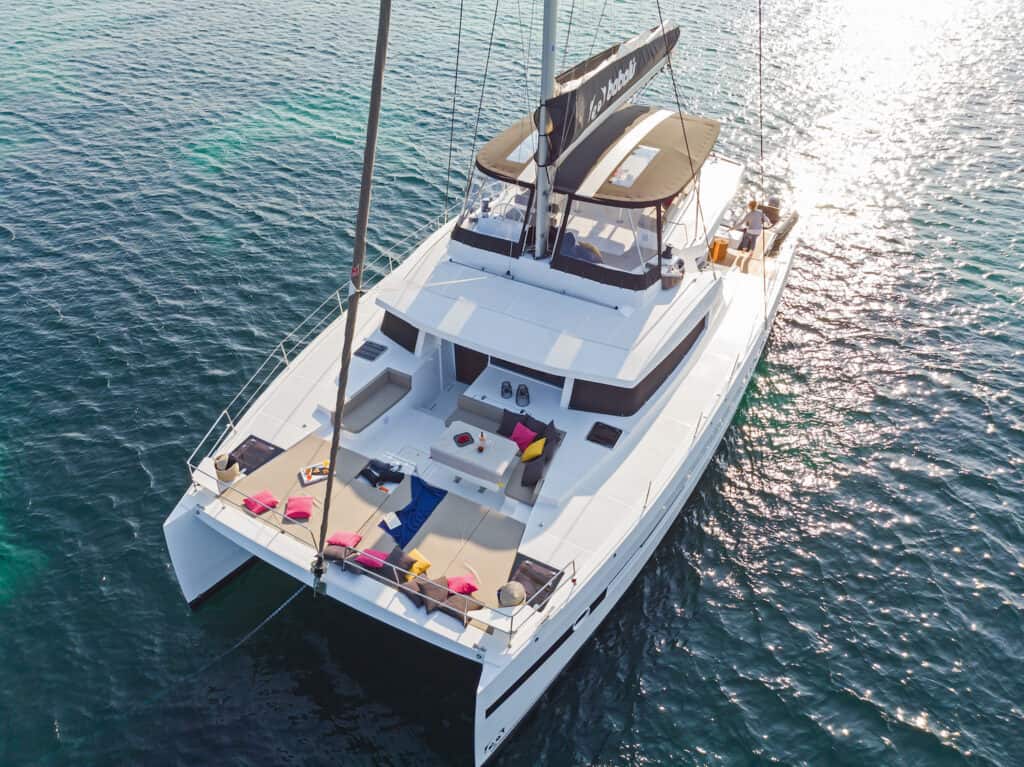
5. Anchor Bridal Setup

Catamarans are fitted with a bridle, attached to both bows and down to the anchor chain, resulting in a very stable position at anchor. What we found with our monohull was that because the bow acts as a sail (because of the high freeboard), the boat tended to sail at anchor in high winds. It sailed in one direction until the chain snatched and tacked over and sailed in the other direction, feeling like it might dislodge the anchor altogether. The catamaran on the other hand sits at anchor a lot more stable and doesn’t sail around as much.
6. Ease of Boarding on a Catamaran
Thank goodness we were much younger and more agile during our monohull days. Royal Salute and most monohulls of her generation or older, have high free-boards, making it quite a feat to get onto the boat from the dinghy. It was one of the most challenging things to do because unlike the more modern monohulls that have a scoop at the back, we had to climb up on the side of the boat to get on and off. We, of course rigged steps, etc. but it was always a hassle compared to the ease of getting on and off a catamaran from a dingy or from the water.
7. Shallow Draft Equals Better Anchorages
Catamarans have significantly shallower drafts than monohulls, allowing for safer anchorages closer to shore. Most catamarans in the 40-ft to 50-ft range draw between 3-ft to 4.5-ft, so they can anchor in places that a monohulls can not even consider. In the shallow waters of the Bahamas for example, the catamarans have a big advantage. We often anchor our own catamaran just a few feet away from a beach. It definitely allows one to be able to explore areas where the water is shallow without the fear of running aground.
The shallow draft also allows for emergency repairs in shallow water and even doing the bottom job when the tide goes out as we have done in places like Mtwapa Creek in Kenya, East Africa. The catamaran easily rests on her keels on the sand without help making it a breeze to do the “annual haul out” even in remote locations.
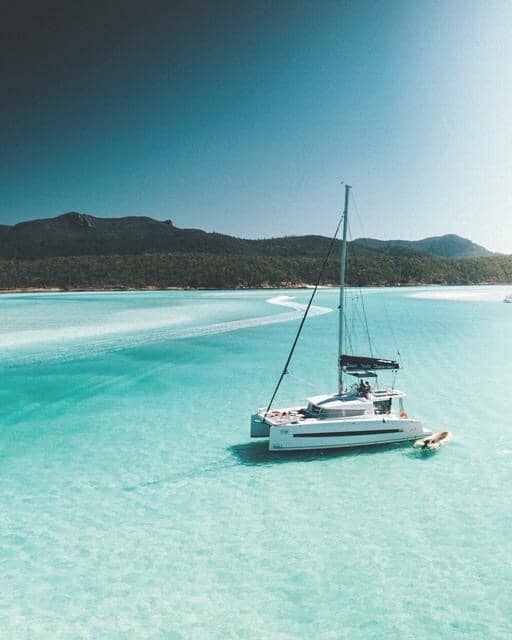
8. Dinghy Davits & Dinghy Size
All catamarans have a set of davits that make it very easy to raise and lower the dingy. Our monohull and most cruising monohulls do not have an efficient or easily accessible set of davits. This makes raising and lowering the dingy an elaborate production. Catamarans on the other hand, has davits systems easily accessible and some even have platforms to rest the dinghy on.
The lack of beam and difficulty of lifting the dinghy also limits the size and type of dingy that one can reasonably carry on a monohull. As we all know, the dingy is your transport to and from shore and diving or fishing spots, so the bigger and faster the dingy, the better off you are. A catamaran can carry both a heavier and bigger dinghy which makes the popular center consul dinghy so much more possible.

9. Interior Space and Comfort on a Catamaran
We sailed 32,000 NM on our 45-ft monohull, happy as clams, not realizing that sailing does not have to be done lying on your ear 24/7 while on passage or sitting knee-to-knee in the cockpit at anchor with your two other guests at the dinner table! One can liken sitting in a monohull cockpit to sitting in an empty Jacuzzi, you are always nice and close to the other folks.
Now that we are on our fourth catamaran, there are a few things that have become more evident to us than the incredible space and comfort of a catamaran, not only at anchor but also underway. The cockpit and living space in general are huge compared to a monohull, making for very comfortable and spacious living conditions. It feels more like you are at home, rather than just on a camping trip.
Knowing that one spends at least 90% of one’s cruising life at anchor, it’s important to have good open living space, which most modern cats nowadays offer. A lot of cats have walk around beds, lots of storage, every modern appliance including washer/dryer, etc. However, one has to fight the urge to fill the space if you want to keep the cat light and fast.

Sailing with guests onboard for extended periods of time, in close quarters can become claustrophobic but on a catamaran people are spread out and separated. With guests sleeping in one hull and the owners in another, catamarans offer much more privacy and separation. Some cats even have privacy doors that will close off the entire hull and has a separate entrance onto the deck, which really separates you from the guests completely.
There is very little heeling on a catamaran, so there is no need for hand grips and safety harnesses inside the boat. There is nothing better (and safer) than being able to walk from the cockpit into the living room (saloon) on one level or one step down at most. In a monohull, when heeling at a severe angle, you would have to claw your way from the companionway steps down to the living area, while fighting to stay upright, significantly tapping your energy.
Unless you hit extreme conditions, everything stays put on a catamaran reducing the anxiety before doing passages of having to stow and secure everything. This very issue makes a lot of cruisers reluctant to weigh anchor and explore more often. It is just too much effort to pack away all your stuff once comfortable in an anchorage!
One thing you will notice is that the stove on catamarans are not gimbaled like it is on monohulls and this should tell the story in itself. The stability and comfort on a catamaran is far superior. Cooking is easy and safer. I often open a nice cold beer, put it down to do something and forget about it only to find a warm beer later in the same place I left it. This is not something that happens on a monohull.
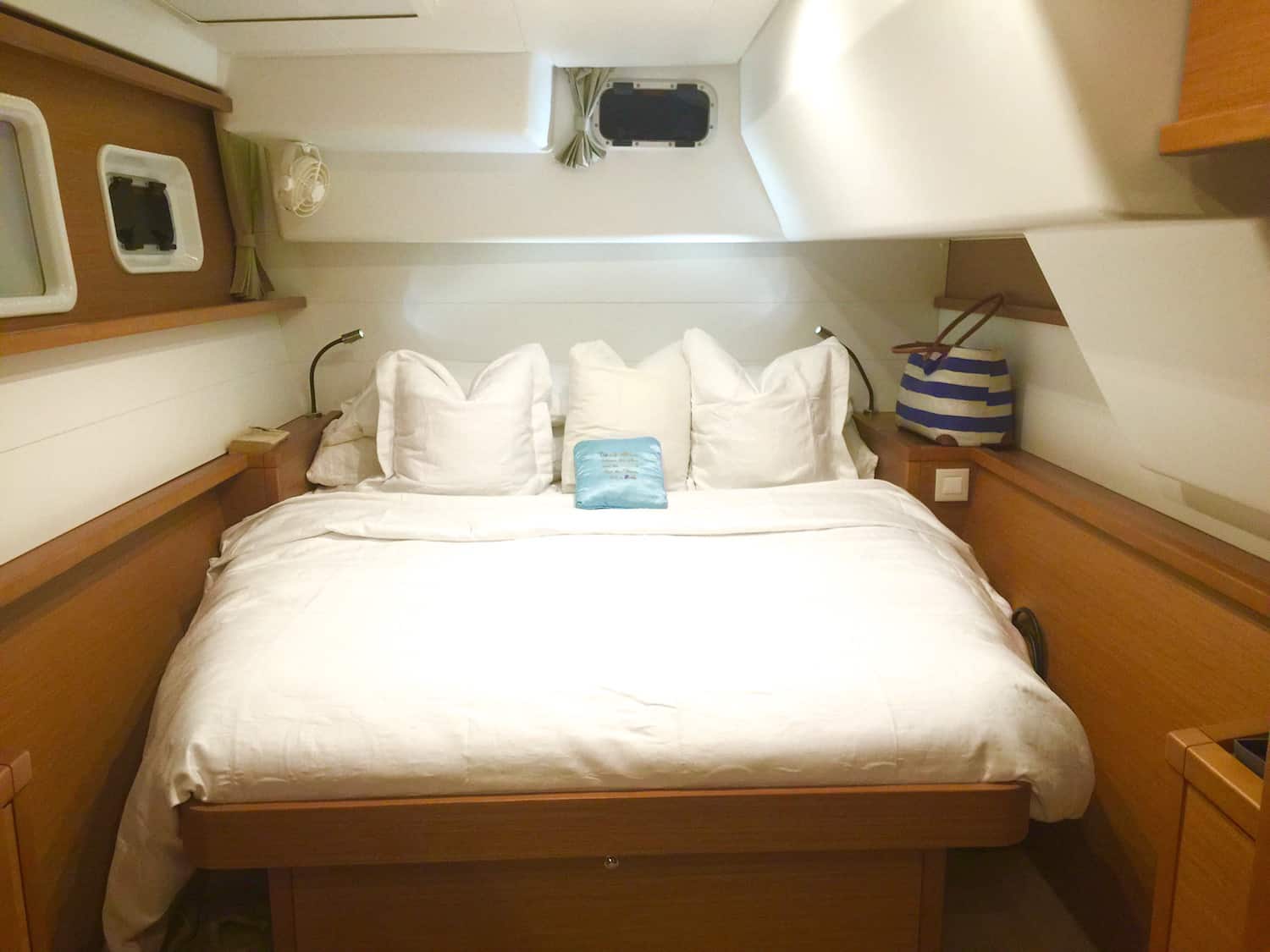
10. Redundancy on a Catamaran
Unlike monohulls, catamarans have a lot of critical redundancies. That of course means two hulls to clean and anti-foul, double the engine maintenance, etc. but having two of the critical equipment like engines for instance, outweighs the downside.
With two engines, if one fails you still have adequate propulsion to go anywhere. If by some fluke the second engine also fails, you have a full set of spares to fix at least one of them. Our friends once hit a sleeping whale off Tanzania, and when it dove, it hit the prop, bending it. They limped into the narrow channel on the one engine but at least they could make it to a safe harbor where we surveyed and repaired their damage.
We often only use one engine when motoring while making passage in order to conserve our fuel. The one engine is totally capable of moving the boat along at a good speed unless you are in heavy seas and you may need more power. Other than that we only use two engines to dock or maneuver the boat in close quarters.
Because there are two engines there are also two independent charging systems via the alternator on each engine. If one alternator goes out, there is still another complete charging system. There are two rudders and if one fails or falls off (as has happened to our friends on a monohull off Columbia, where they almost lost their boat) you have a second rudder that is completely capable of steering the boat by itself indefinitely. That holds true for several things on a catamaran!
11. Maneuverability
The engines are spaced far apart on a catamaran and it makes maneuvering much easier and more precise than monohulls, unless the monohull has a bow thruster. We did not have a bow thruster (not many monohulls do) and had to rely on prop-walk and using prop wash on the rudder. A modern catamaran can do a 360 turn on her own axis. A monohull cannot do this and have a bigger turning circle. However, a monohull under sail is much more maneuverable and certainly will tack a lot faster than a catamaran. The ease in maneuverability under engine on a catamaran in close quarters specifically, is vastly superior comparatively.
12. Rigging
Because of the beam on a catamaran the spinnaker pole has become unnecessary equipment. Hallelujah, I say. That pole on our monohull was a pain the behind and I always hated having to use it. On a catamaran, one can fly an asymmetrical cruising chute or spinnaker, using the bows to tack the clew or run a guy through a block so it is very much simplified, easier and safer.We also sail wing-on-wing with twin headsails when we sail downwind. We use our furling jib and furling Code Zero. It is as easy as one, two, three.
DISADVANTAGES OF A CATAMARAN
1. bridgedeck slamming.
One advantage most monohulls do have when underway is that they don’t slam. Catamarans with a low bridgedeck clearance can experience significant slamming in confused seas sailing upwind. This slamming can be quite disconcerting when you first experience it as we did on a Shuttleworth 44 design, our first ever catamaran experience, 20+ years ago. At times, it felt as though the boat was falling apart. Of course the boat was fine but nevertheless, the stress on the crew from the constant noise and discomfort was significant.
Monohulls don’t have a bridgedeck which means no slamming and are therefore a bit more comfortable than l ow bridgedeck catamarans when beating into severe confused conditions or “washing machine” conditions as we call it. Modern catamarans mostly have better bridgedeck clearance and the slamming is significantly less. However, not all cats have a good clear tunnel under the bridgedeck. Some manufacturers build beds into the bridge deck in order to make more space in the chest of the catamaran where the slamming occurs. These protuberances into the bridgedeck tunnel will likely increase slamming. So be mindful of that when selecting a catamaran. We currently own a Bali 5.4 and the bridgedeck clearance on this boat is more than adequate and the tunnel is clear. We therefor experience very little slamming compared to our Prout 45 that we previously owned (picture of sister ship below) with a much lower bridgedeck.
We Explain Bridgedeck Clearance
In the pictures below, the Bali 5.4 has very good clearance from the water to the bridgedeck and has a nice clean tunnel versus the very low bridgedeck of the Sunreef 50.

2. Sailing Downwind
Monohull spreaders are set at 90 degrees to the mast whereas a catamaran has to have backswept spreaders. The reason is that, on a monohull, there is a backstay and using this, plus the intermediates you can get a nice pre-bend in the mast (the pre-bend is to flatten out the main sail and allow for better performance).
On a catamaran with no back stay, you need to use the back swept spreaders and the diamonds to pre-bend the mast. The reason I point this out is because on a catamaran, if you want to broad reach or run, the mainsail cannot be let out all the way because the backswept spreader tips could punch holes in the fabric.
On a monohull, the spreaders are at 90 degrees so you can let the main and the boom out much further which is, of course, much more effective. This is one of the reasons it is better to broad reach and tack downwind on a catamaran.
Whether a monohull or multihull, sailing dead downwind doesn’t usually make great VMG. Therefor a regular cruising cat, much like a monohull, needs a lot of sail area and has to sail deep downwind if it is to achieve a decent speed made good (VMG). This video demonstrates how we achieve this by sailing wing-on-wing downwind.

It is more difficult to find a dock either as a transient or a permanent slip for a catamaran in general because of the wide beam. But this is changing fast and will soon not be too much of an issue. In the USA dockage is charged by the length of the boat in feet, so there is no disadvantage there but, in some places, (the Mediterranean for example), dockage is charged at length times one and a half because of the additional beam.
Since the catamaran is stable at anchor, we mostly anchor out. We have more privacy, a better breeze and usually a stunning view.We have a nice dinghy with a good outboard engine and is big and comfortable enough to get to shore fast and together with the modern conveniences like the generator, watermaker and washer/dryer, docking becomes a non-issue.
It is definitely more difficult to find a travel lift with enough beam for a catamaran for a haulout, while, for a monohull, there are absolutely no problems anywhere. The wide beam of cats also greatly limits the number of shipyards that can haul them out. Most catamarans over 40-ft must be hauled out with a 50-ton travel lift. This not only increases the cost of the haulout, but greatly limits the choice of the shipyards for repairs and maintenance. With limited choice, prices are high for shipyard services.
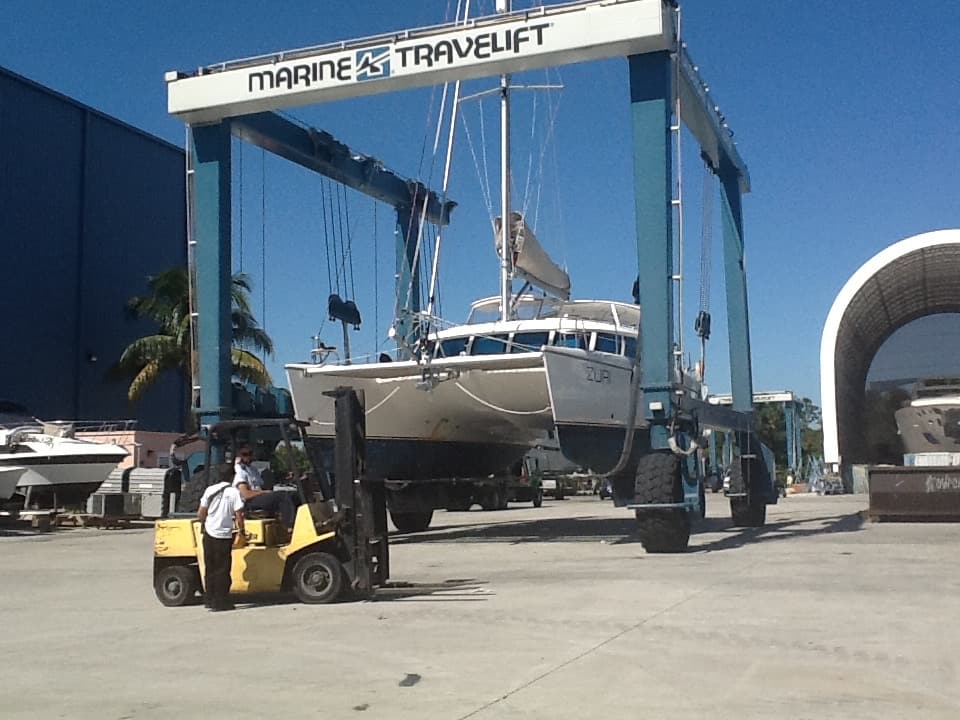
Catamarans do tend to have a lot more windage than monohulls. This can be an issue especially when maneuvering in close quarters with a strong wind. But I have found that, provided the engines are powerful enough for the size of catamaran, that twin engines negate this problem. Also, many modern large catamarans now have a bow thruster fitted. It is super easy to dock.
The cost of getting into a catamaran is much higher than that of monohulls. That could put a serious dent in your cruising kitty or require you to put your dream on hold a little longer. Pre-owned monohulls on the other hand are very cheap to buy comparatively, because the supply presently far outweighs the demand.
Catamarans are in high demand and they typically hold their value much better and longer and the trend is now heavily in favor of the catamaran market. When prospective buyers contact us for catamarans under $250,000 the choices are very limited and catamarans under $100,000 is near impossible to buy. In this case, your best bet is to go with a monohull unless you go with much older boats like the Prouts or the less expensive Geminis.
Our Own Catamarans & Monohulls
FYI: Royal Salute , a Bruce Roberts 45 monohull, was the first boat we owned and sailed approx. 30,000NM on. Mythral, a Seafarer 30, was our “toy boat” while we were waiting for our catamaran to be built. Even though this classic little monohull sailed around the world, it didn’t have much in modern conveniences like running water. Siyaya was an Island Spirit 40 catamaran that we sailed from Cape Town to Florida on and then taught live-aboard sailing classes for several years. Zuri I was a Prout 45, a beautifully crafted catamaran but by today’s standards is considered old technology. Our Lagoon 450 SporTop ( Zuri II ) is a fantastic live-aboard catamaran. We lived and taught aboard her for three years but sold her last year and we currently own a Bali 5.4 ( Zuri III or Z3 as we call her now). Read about our various boats .

CONCLUSION: CATAMARAN vs MONOHULL
We were dyed in the wool monohull sailors for 15+ years. We loved the pretty lines of monohulls, the sailing ability and what we believed at the time to be much safer vessels. However, now that we have been avid catamaran enthusiasts, we simply can never go back to monohulls. Catamarans have come of age and with modern technology have overcome most objections that sailors of old had against them. They are well designed and built, are safe, and we simply love that they sail fast and upright. There is not a whole lot to dislike about a catamaran when you live aboard. We have weighed all the pros and cons of catamarans and found that the pros far exceed the cons. We made the change to a catamaran and do not regret it one bit!
We hope that this article will clear things up for all the prospective catamaran owners out there.
Contact us if you have any questions regarding catamarans, Fractional Yacht Ownership or our Charter Management Programs .
Estelle Cockcroft
Join our community.
Get the latest on catamaran news, sailing events, buying and selling tips, community happenings, webinars & seminars, and much more!
4 thoughts on “Catamaran vs. Monohull: We Changed, Should You?”
I read that the engineering on the catamarans were improved over the years. Whats the oldest year would you recommend designwise?
Scott, my apologies for the late reply. We’ve been traveling in Africa. Anyway, catamarans have come a long way and improvements in technology is happening at lightning speed. I reckon that even the older model catamarans are good. It depends on what your needs are. If you want something a little better performance wise, I would go for something no older than 15 years.
After buying a catamaran what is the difference in expense of a catamaran vs a monohull. Many articles state that not only the initial cost of a catamaran is more it the operating cost as well.
Hi Todd, it is more expensive. The annual dockage and haul out as well as maintenance will be more expensive. You obviously have two engines to maintain and various other pieces of equipment to service in both hulls. While there is more equipment there is also more redundancy and of course you have the comfort factor. So, depending on your situation, it’s probably worth it.
Leave a Comment Cancel Reply
Your email address will not be published. Required fields are marked *
Save my name, email, and website in this browser for the next time I comment.
Recent Posts

Top 10 Reasons to Sell (and Sail) Your Catamaran in Annapolis, MD
We have a new home in Annapolis! The office is located in Annapolis, Maryland
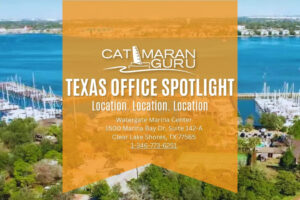
Top 10 Reasons to Sell (and Sail) Your Catamaran in Texas
Our Texas Office is located in the Watergate Marina Center in Clear Lake Shores,
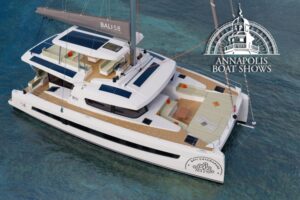
Annapolis Boat Show 2024
Meet with our team! Want to learn more about the Bali and Catana

Exploring the Catana OC 50 Catamaran: A Comprehensive Overview
The Catana OC 50 Catamaran, the latest addition to the Catana Ocean Class series,

For more than 30 years, we have been a part of the catamaran community and created Catamaran Guru™ to encourage and educate all the aspiring sailing out there. We understand the dream of traveling the world by catamaran and created a one-stop-shop to make that dream a reality for you.

- Stephen & Estelle
- Testimonials
Get Started
- Yacht Sales
- Used Yachts
- Charter Management
- Boat as Business Programs
- Seminars & Events
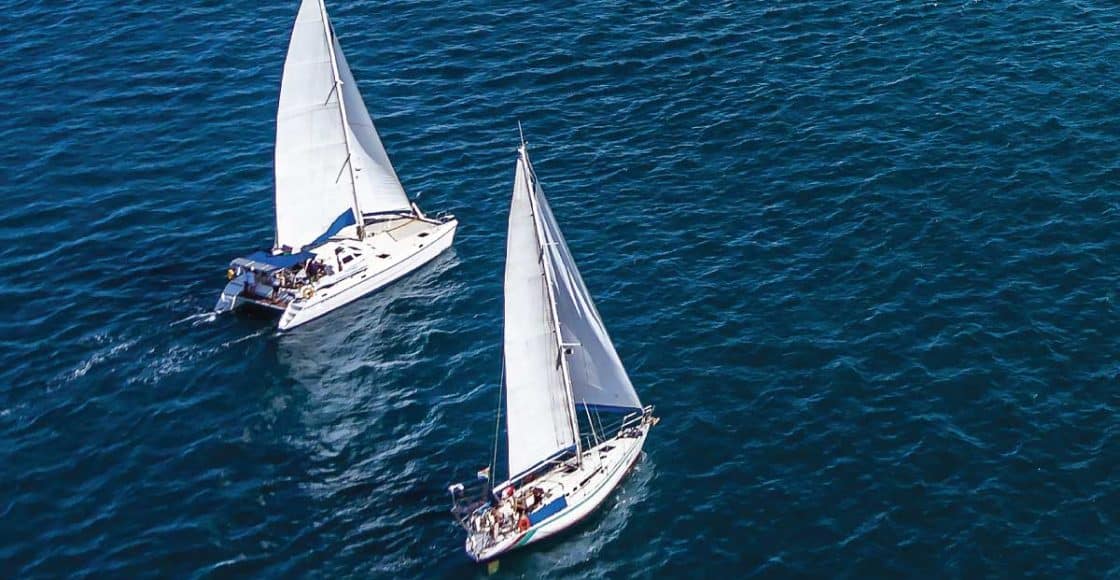
Catamaran vs. Monohull: Which Is Better?

Table of Contents
Last Updated on September 1, 2023 by Boatsetter Team
It used to be that sailors and powerboaters (blowboaters and stinkpotters, respectively) used to hold the loudest arguments about which was better– sailboats or powerboats. Today, the debate is centered around catamarans and monohulls— how many hulls are best? Is there a best?
Let’s look at what each boat offers— and continue to read for all Pro Boatsetter Tips .
Got a boat? Put it to work
The benefits of catamarans
Spacious for large crews, easier on your body, shallow drafts, safety system in case of emergencies.
Pro Boatsetter Tip: Did you know catamarans have seen a great surge in popularity over the last decade?
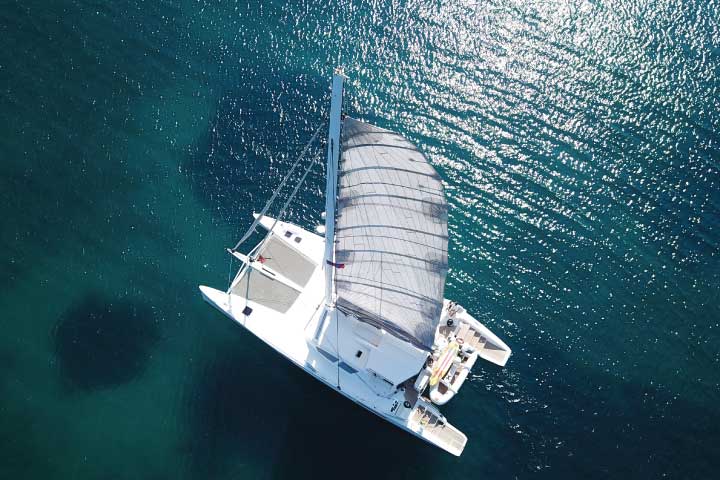
If you’ve got a large crew or plan on throwing parties aboard, you’ll probably benefit from the catamaran’s (also known as “cats”) roominess. Cats offer separation on deck with the aft cockpit , forward lounge or trampoline, and maybe even a flybridge .
Inside, cats have cabins and multiple heads for convenience. A cat of a given length (let’s say 40 feet) has 1.25 x the space of the same length monohull. In other words, it feels the same as a 50-foot monohull. It’s also usually laid out in a more user-friendly manner.
Cats have two hulls, making walking easier for kids, older folks, and pets! Because of its steadiness, you and your crew are less likely to be fatigued by the end of your boat trip. Maybe stay out longer to catch more fish.
Best of all, you’re less likely to feel seasickness because they don’t feel “on their ear” even when sailing in high winds and rough conditions. Not to mention, they’re much easier to sleep on.
Most sailing catamarans have a shallow draft perfect for skinny water cruising like the Chesapeake Bay and Florida. They can venture into areas previously off-limits to deep-draft monohull sailboats.
Most cats have double the systems, including bilge pumps, freshwater pumps, showers, heads, engines, etc. This means if one system fails, you’ve got a backup!
Twin screws also offer easier docking and increased maneuverability. It’s much easier to drive a large sailing cat than a single-engine monohull, especially in a cross-breeze and when docking, backing, or maneuvering in tight quarters.
The benefits of monohulls
- Performance
- Easy cruising
- Familiarity
- Availability & expense
Pro Boat Type Tip: Operating a monohull can be challenging! If this is your first time sailing on a monohull , make sure to rent with one of our pro captains.
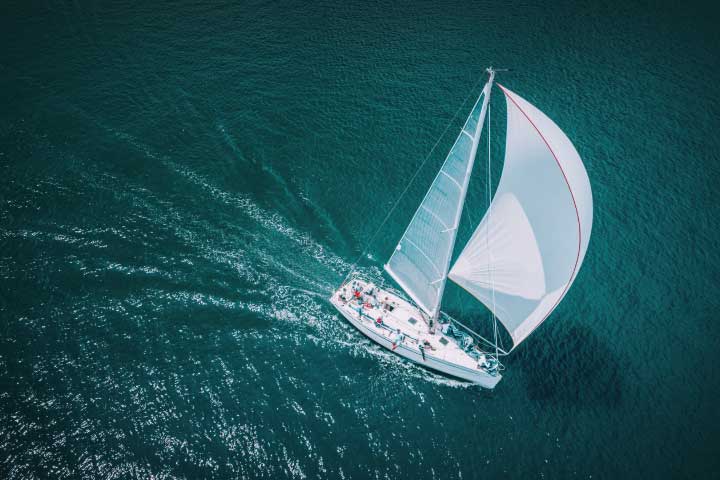
Competitive performer
If you want to win a sailboat race, use a monohull. This boat’s design makes it a favorable contender even when weather conditions are working against you.
Let’s add a caveat here for cruising under power– cats tend to be more fuel efficient because they’re lighter and they’re not dragging a heavy keel through the water.
Easier motion
Monohull sailboats have their own groove. This motion is predictable and distinguishable by pro sailors. Cats, on the other hand, depend on the body of water’s condition state. Also, cats pound when going upwind into big seas if their bridge deck is pummeled by waves, while monohulls tend to slice through the waves.
Familiar handling
Monohulls have been around for centuries, and chances are that you learned to sail or powerboat on one, so their handling is more familiar. A cat’s dimensions may seem intimidating at first, especially if you are short-handed.
Availability & cost
Monohulls are more available, especially for rent. There are simply more of them. They’re also usually less expensive to rent and less expensive to moor in a marina.
The good news about catamarans and monohulls
There’s no right or wrong choice. It all depends on your budget but, above all, your boating lifestyle. So the better question is: what will you use your sailboat to do?
Party at hidden coves with your crew. Take the kids out for a fun sailing excursion. Sunset cruises with your partner. Enter a regatta; win! Rent it out for an extra income.
Learn more about boating types, gear, and fun water toys at Boating Resources .
Boatsetter is a unique boat-sharing platform that gives everyone — whether you own a boat or you’re just renting — the chance to experience life on the water. You can list a boat , book a boat , or make money as a captain .
List, rent, earn — Only at Boatsetter.

Zuzana Prochazka is an award-winning freelance journalist and photographer with regular contributions to more than a dozen sailing and powerboating magazines and online publications including Southern Boating, SEA, Latitudes & Attitudes and SAIL. She is SAIL magazines Charter Editor and the Executive Director of Boating Writers International. Zuzana serves as judge for SAIL’s Best Boats awards and for Europe’s Best of Boats in Berlin.
A USCG 100 Ton Master, Zuzana founded and manages a flotilla charter organization called Zescapes that takes guests adventure sailing at destinations worldwide.
Zuzana has lived in Europe, Africa and the United States and has traveled extensively in South America, the islands of the South Pacific and Mexico.

Browse by experience

Explore articles
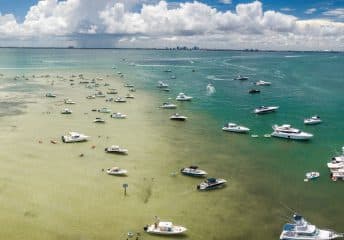
9 Best Sandbars in Florida
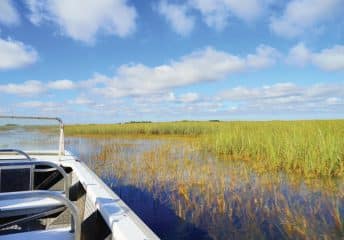
How to Navigate a Boat in Marine Protected Areas
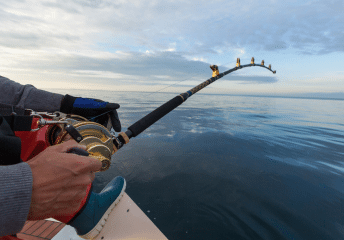
A Fishing Excursion You Don’t Want to Miss

Introducing the Mind Your Wake Stewards Grant

- YACHTS OVER 60 FT
- YACHTS BELOW 60 FT
- LUXURY YACHTS
- Sell Your Yacht
- Finance Quote Wizard
- Boat Loan Application
- Engine Loan Application
- Trailer Loan Application
- Products/Service Loan Application
- Get Insurance Quote
- Retrieve Application Status
- Merchandise
- View All Products
- Anchoring & Docking
- Marine Safety
- Electronics & Navigation
- Communication
- Boat Outfitting
- Entertainment
- Marine Hardware
- Plumbing & Pumps
- Check Order Status
- Client Reviews
- 3D Virtual Tours
- Boats and Shipyards
- Financing Specialists
- Detailers, Boat Washers and Fiberglass
- Insurance Specialists
- Electrician
- Dealer / Mechanics
- Yacht Management
- Surveyors and Mechanical Surveyors
- Maritime Attorneys and Documentation Companies
- Bottom Cleaning & Diving
Powered Catamarans Vs. Monohull Motor Yachts
Two hulls or one? It’s a debate that’s existed since the Polynesians first started exploring the Pacific Ocean in catamarans. Nowadays, our catamarans are much more refined. They can be powered both by sails or by diesel, but in this article we’ll only be comparing motor cats to other monohulled motor yachts, as sailing a catamaran is a completely different game.
First, the obvious difference is in the shape. A catamaran is wider and boxier than a monohull yacht, and this difference comes with tradeoffs and benefits. The catamaran’s double hull design gives it greater stability both underway and while docked or moored. A catamaran is also much more fuel efficient on average than a monohull, due to the decreased amount of drag on it’s much slimmer hulls. However, monohull yachts are capable of handling larger, more powerful engines, and thus usually have a considerably higher top and cruising speed than catamarans.
As for living space, it depends on which areas of the boat are most important to you. The wider catamaran allows for a more spacious salon, galley, and flybridge than all but the largest of monohull yachts. However, the cabins in a catamaran are located in the hulls, which are slim. This usually results in the overwhelming majority of the space in the cabins being taken up by the berth, leaving little room for in-cabin storage. In a monohull yacht, there are many more possible layouts for the V-berth, aft cabin, or guest cabins, and they are usually much more roomy.
Finally, it’s necessary to consider where you’ll be keeping your yacht, catamaran or not. With a monohull, you can fit into many more slips in many more marinas. With a catamaran, especially a larger one, you’ll probably want to search out and end or side tie slip. These, of course, are less common than a normal slip.
There is a different definition of “the best boat” for everyone. It’s impossible to say definitively whether or not a motor cat or a deep-V monohulled yacht is better, but it’s easy to decide which one best fits your needs when you have a list of their major differences at hand. We hope this article cleared up these differences, and, as always, happy yachting!
Recent Posts

- 2024 BOAT BUYERS GUIDE
- Email Newsletters
- Boat of the Year
- 2024 Freshwater Boat and Gear Buyers Guide
- 2024 Boat Buyers Guide
- 2024 Water Sports Boat Buyers Guide
- 2024 Pontoon Boat Buyers Guide
- Cruising Boats
- Pontoon Boats
- Fishing Boats
- Personal Watercraft
- Water Sports
- Boat Walkthroughs
- What To Look For
- Watersports Favorites Spring 2022
- Boating Lab
- Boating Safety
- Ultimate Boating Giveaway

Catamaran Versus Deep-V Monohull
- By Chris Caswell
- Updated: February 26, 2018
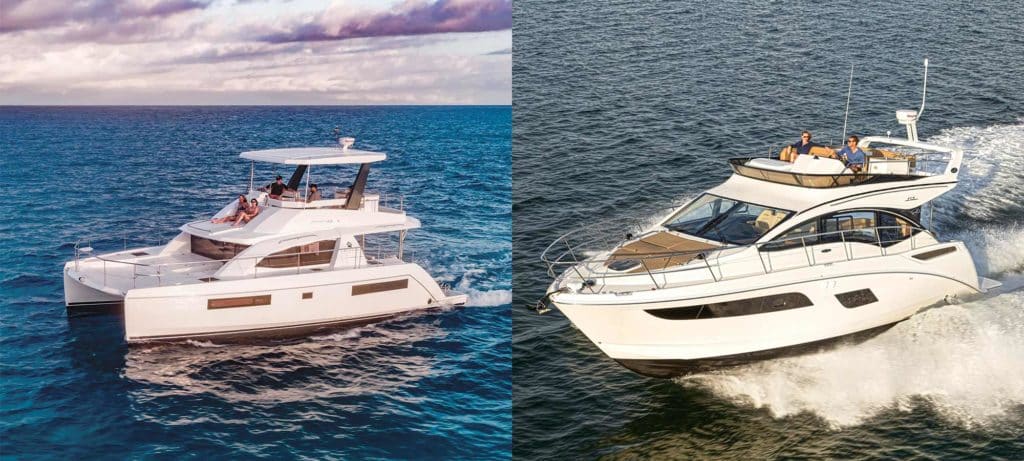
Ever since the Polynesians started crossing oceans on catamarans when much of the “civilized” world was still afraid of the sea, the idea of the twin hull has ebbed and flowed in popularity. For centuries in the Western world, the monohull ruled the seas. At least until 1876, when Nathanael Herreshoff designed a sailing catamaran that was so fast, cats were actually banned from racing for years. Yes, cats are cool. But how do they really stack up against the classic, tried-and-true deep-V monohull?
Let’s look at the strengths and weaknesses of catamaran and monohull boats. We picked two boats of similar length: the Sea Ray Fly 400 (43 feet 6 inches) and the Leopard 43 Power Cat (42 feet 8 inches). The Sea Ray displaces more (30,900 pounds versus 25,794 pounds), but the major difference is beam: The Leopard, carrying 22 feet 1 inch of beam, is nearly 9 feet wider than the Sea Ray (13 feet 6 inches). And that is where many differences between the two start.
Before we go on, we need to provide a disclaimer. We know we’re comparing apples to oranges to some degree, so don’t go sending us angry letters about an unfair comparison. Frankly, it’s sometimes good to compare the taste of oranges and apples. And here’s the thing: We like them both! Both boats ended up with good scores in some areas, lesser in others. We do believe that the concepts that surfaced as a result of comparing these two boats will help cruiser buyers make a more informed decision if the question of cat versus mono arises in their quest for a new boat. That said, let the comparison begin.
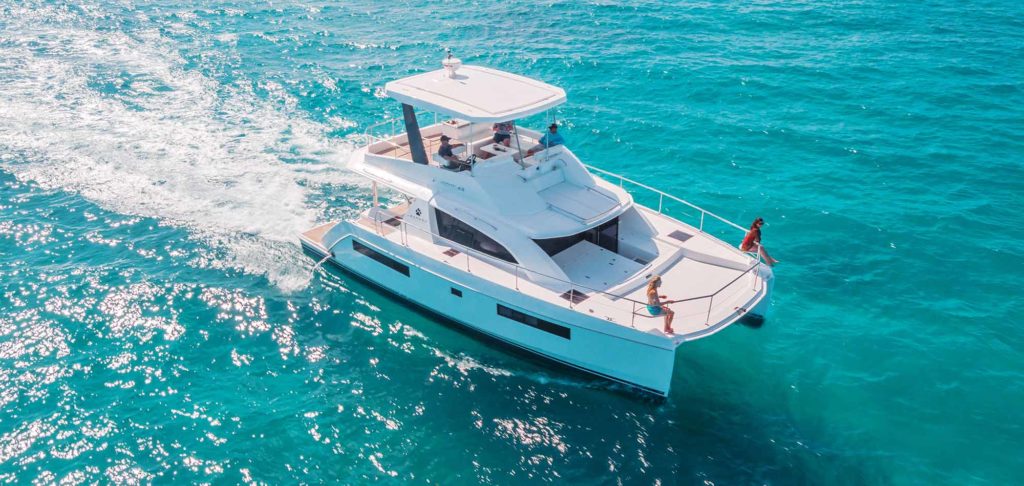
Fast Action: Speed Vs. Efficiency
With 960 hp from twin Cummins diesels, the Sea Ray easily wins in top speed at nearly 34.5 mph compared to the Leopard (27.6 mph), but at a serious cost in fuel. At 20 mph, the Leopard is using just 20 gph, for an even 1 mpg. At the same speed, the Sea Ray is using 32.6 gph, netting 0.5 mpg.
“A strength of the catamaran is that it has such low drag,” says Gino Morelli, the catamaran designer, whose credits range from America’s Cup contenders and Olympic-class cats through power cats for charter use up to a record-setting round-the-world 125-foot cat. “It’s just basic hydrodynamics: Two slim hulls have very low resistance. They push much less water than one wider hull and therefore require smaller engines for increased efficiency.”
The Sea Ray is faster; the Leopard is more efficient. It’s nice to have speed when you want to outrun an approaching squall or get to an anchorage first. On the other hand, you’ll probably spend most of your cruising time at the lower speed more comfortable to your guests.
Our take: Both are winners. It’s your choice.
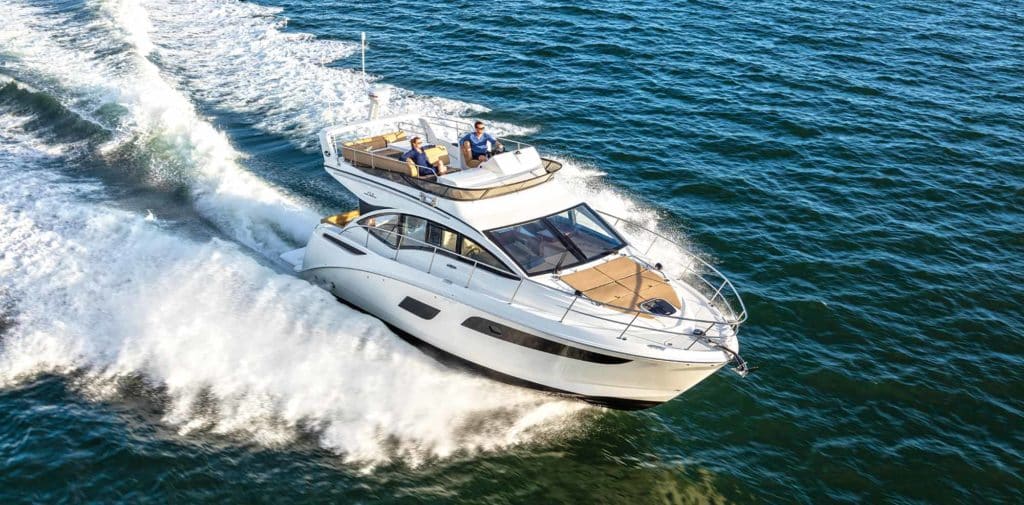
Pain and Gain: Ride Vs. Handling
“Two sharp hulls pound less in a seaway too,” says Morelli. Monohulls, especially cruising monohulls like the Sea Ray, tend to experience bow rise when accelerating, while catamarans remain flat throughout their speed range. It’s generally agreed that catamarans provide a softer ride in a seaway because their knifelike hulls slice the waves rather than crush them, and the motion of a catamaran in waves is more like a cantering horse, which some people like and others don’t. At low speeds in a beam sea, some power cats can have a sharp roll as swells pass under each hull separately, but monohulls also roll considerably, which is why gyrostabilizers and stabilizer fins have become popular aboard monohulls. But the roll moment is different for each, and you may or may not prefer one motion to the other.
In hard turns, catamarans remain flat or even lean outboard somewhat, which can intimidate inexperienced skippers more used to the inboard bank of a monohull. Handling is another factor to consider, and catamarans have both good and bad features. With the engines widely spaced in the two hulls, a catamaran is more maneuverable at slow speed and spins easily by using its engines. A monohull, with the two engines close together, requires more power and technique to spin.
The downside of handling a cat, of course, is the much wider beam: Turning a platform that is more than half as wide as it is long can take planning, especially in narrow channels. Some, but not all, catamarans also have some weird quirks, such as “sneezing” between the hulls when running in some conditons, which sends spray over the bow, and also pounding at times at idle speeds due to air pockets.
Draft is something to keep in mind too, especially if you want to explore shallow waters. The Leopard draws 3 feet 1 inch compared to the Sea Ray at 3 feet 7 inches. The Leopard also has skegs to protect its props, rudders and running gear if you decide to nose up to a beach.
That 22-foot beam has another downside: It doesn’t fit in many marina slips, which means the Leopard is likely to moor on end ties (with more wave motion) or on side ties along a seawall, while the Sea Ray will fit into most any marina slip. Catamaran slips are often more expensive too.
Our take: The catamaran wins for its soft ride in a seaway. The V-hull wins for fitting into a greater number of protected, less-expensive marina slips.
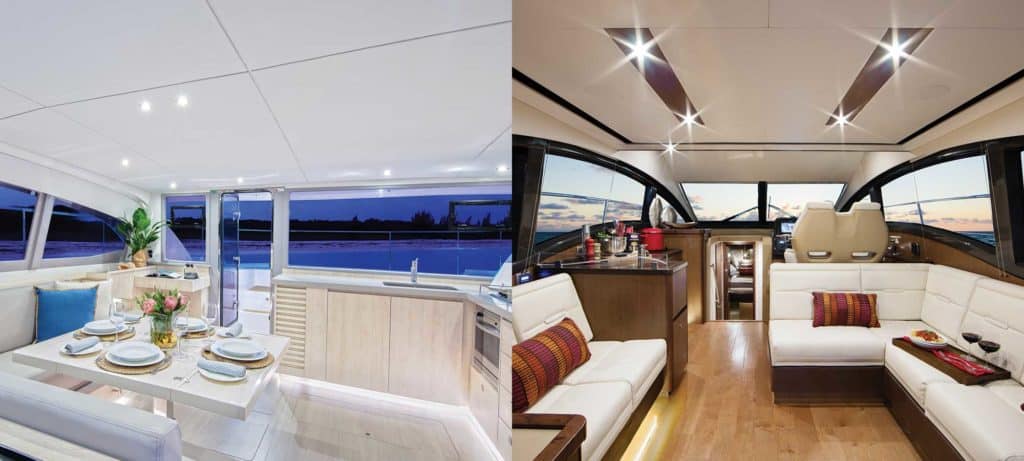
Interior Accommodations – Salon
There’s no getting away from the fact that a 22-foot-wide boat will have more space than one with a 13-foot beam, or so it should seem. But that isn’t quite true. Let’s start with the salon.
Having a 20-something-foot-wide living room is something you don’t find aboard monohulls until you pass the 100-foot length, and this is exactly why catamarans are proving popular with liveaboard owners. In the case of the Leopard, there is a large dinette, a single-seat lower helm station, and a spacious L-shaped galley with counter space measured in acres. Galley gear includes a three-burner gas cooktop with gas oven, and a two-drawer fridge.
The Sea Ray has a doublewide helm station, a pair of facing couches, and a galley aimed more at dining ashore, with limited counter space, a two-burner electric cooktop, microwave and fridge.
While the Leopard salon excels in sheer space (there is room to dance in the salon), it also has one popular feature: a front door. Both boats have sliding doors aft into the cockpit, of course, but the Leopard has an offset door that opens to the foredeck for anchoring or sunning.
Our take: The salon winner is the Leopard catamaran.
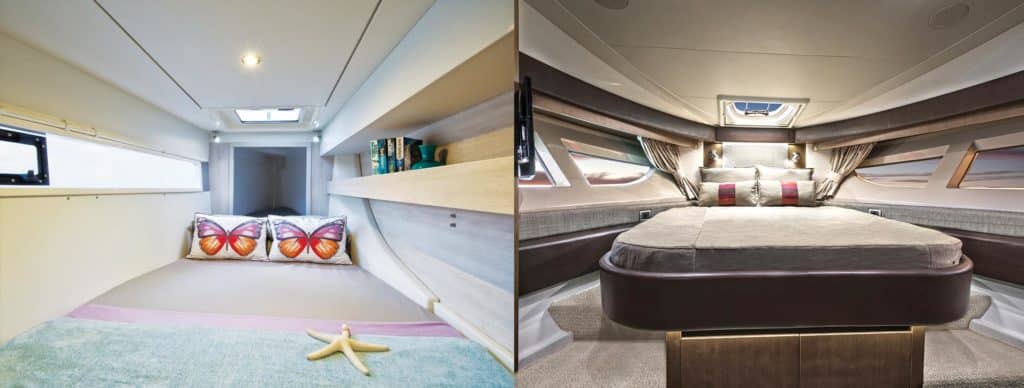
I said “so it should seem” about a wider beam on the Leopard equating to more space, which was true for the salon, but not so much for the staterooms. The Sea Ray has a conventional monohull layout for this length, with the master stateroom forward and a midship cabin under the salon with two berths that can slide together to become a double. The Sea Ray master cabin has a walk-around island queen-size berth, while the midship cabin has limited headroom, but a couch and a separate head are optional.
The Leopard, on the other hand, offers either a four-cabin or a three-cabin owner’s layout. The four-cabin is popular with chartering, placing two cabins in each hull, with a head and stall shower between, while the owner’s version fills the starboard hull with the berth aft and the bow becomes a large head with stall shower.
The shortcomings of the catamaran are the narrow hulls, which limit the width of the cabins. The berths literally fill each cabin, hullside to hullside, making these into less graceful crawl-in berths, and each cabin has limited floor space and stowage.
Our take: We’ll call this even, depending on whether you want more smaller cabins or fewer but more-spacious cabins.

Once again, sheer beam is the determining factor in flybridges. The Leopard has a wraparound dinette, doublewide helm seat, and outdoor galley with barbecue grill and fridge. The Leopard bridge still has ample space for deck chairs or kayaks. A walk-through next to the helm leads to a sun pad on the forward bridge for lounging.
The Sea Ray 400 Fly has a single helm chair and a double companion seat, as well as a dinette and mini galley, but no extra space.
Our take: The Catamaran’s extra width offers a more spacious flying bridge.
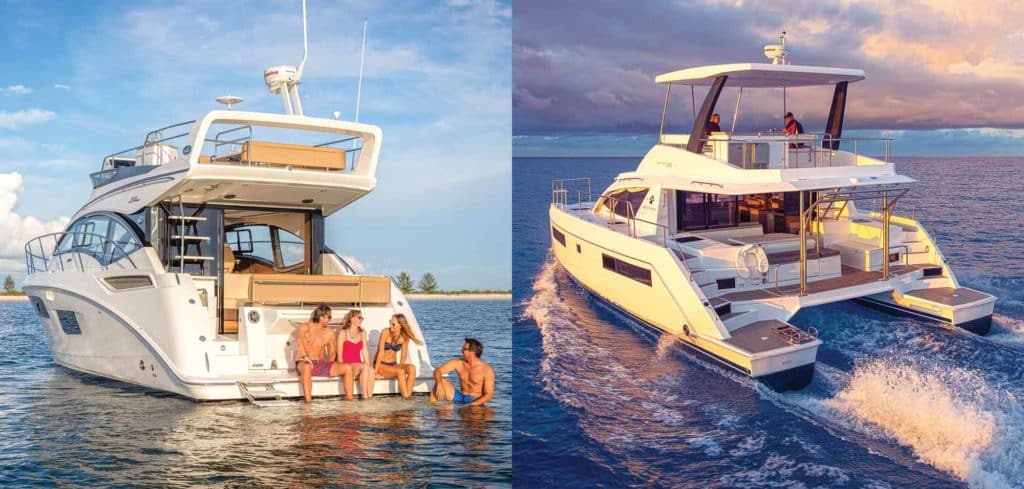
Transom Platform
The Leopard Power Cat has smaller transom platforms, but there are two of them. Leopard created a clever electric davit that can launch or retrieve a tender and provide secure stowage while underway, making tender operations easy. The Sea Ray offers a standard transom platform or an optional hydraulic platform, either of which serves as a terrific “beach” for your crew while at anchor. It can carry up to a 500-pound tender such as a Sea-Doo Spark PWC.
Our take: The monohull’s single wide swim platform is superior for tender handling, swimming and socializing
Fit and Finish
This last item is empirical, and the fact is the two boats are finished to different standards. The Leopard ($459,000 MSRP), like many catamarans, is designed for minimal maintenance for tough charter service, with expanses of fiberglass and Formica-like materials. The Sea Ray ($809,542 MSRP), on the other hand, uses fabrics and finishes that create a more opulent, yachtlike interior.
Engine access on the Sea Ray 400 Fly is good via a gas-lifted cockpit deck, while the Leopard engines are under the berths in the two aft cabins, which rise on gas lifts, but there is some upheaval of two cabins to check the oil. Again, a personal choice: one engine room or two.
Our take: Finish is not strictly a cat or mono attribute. Any boat can be finished to any level, depending upon the builder’s target market.
Catamaran or monohull? Both are right for certain owners and, just like apples and oranges, both taste good for different reasons. Boating ‘s position for decades has been and continues to be: There is no perfect boat, but there is probably a boat that is perfect for you.
- More: Boats , Cruising Boats , Leopard Catamarans , sea ray , versus
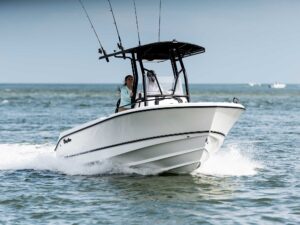
Boat Test: 2024 EdgeWater 208CC Watchman
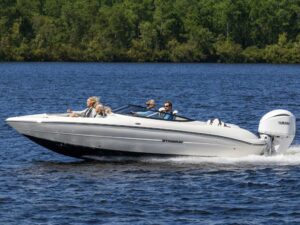
Boat Test: 2024 Stingray 23 OSX
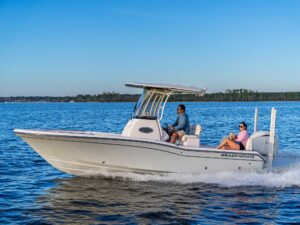
Boat Test: 2024 Grady-White 231 Coastal Explorer
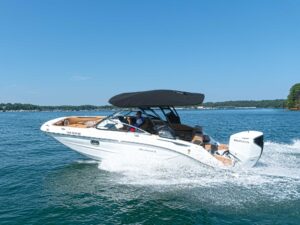
Boat Test: 2024 Hurricane SunDeck 2600 OB
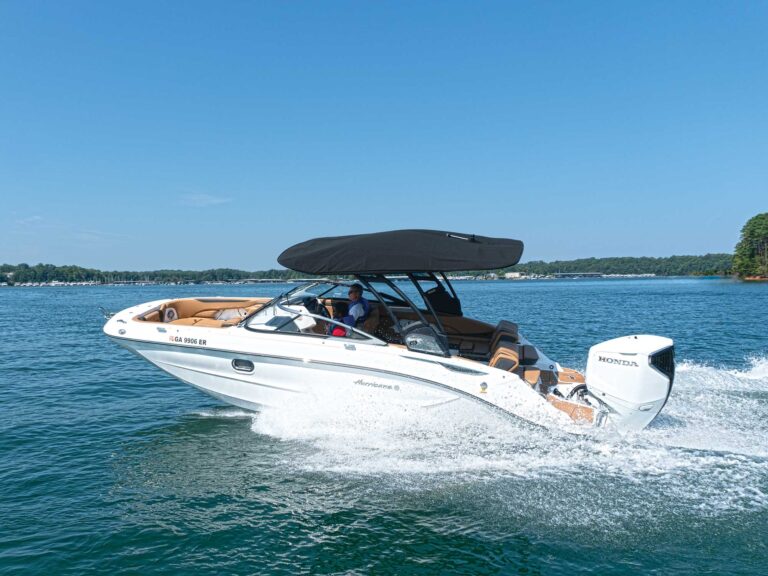
Boat Test: 2024 Brabus Shadow 1200 Sun-Top
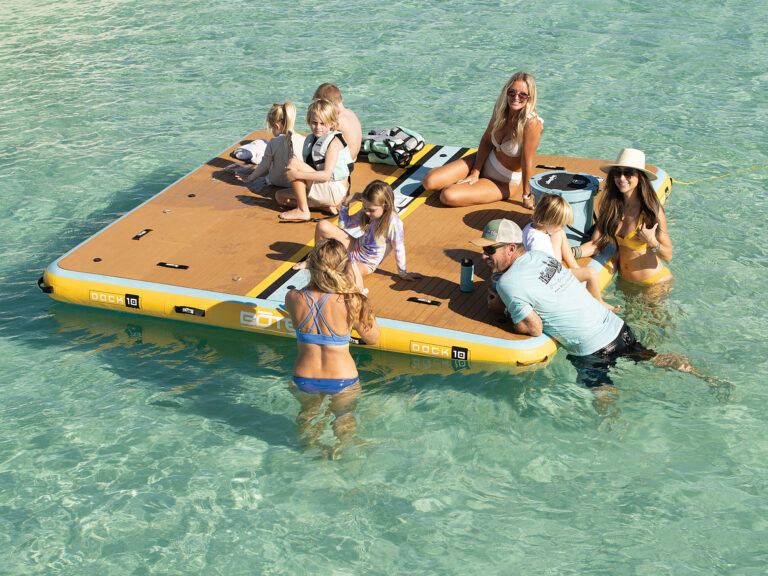
Inflatable Water Mats for Boaters
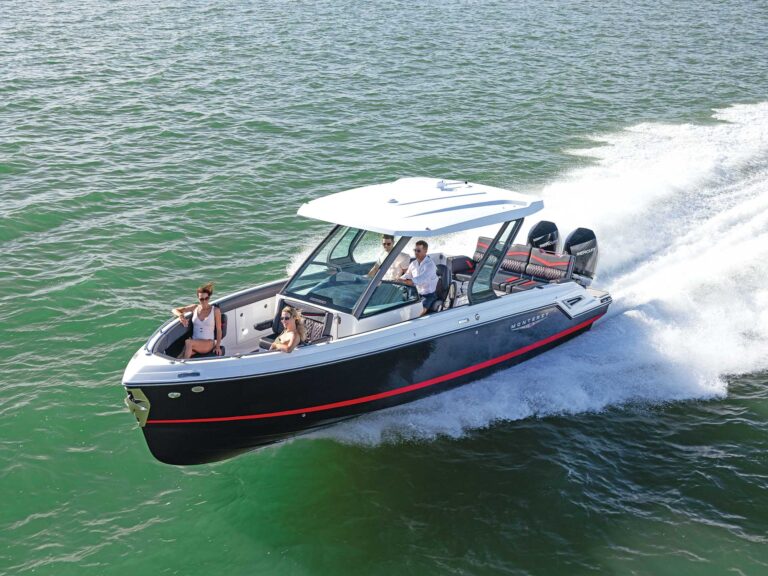
Boat Test: 2024 Monterey Elite 30

- Digital Edition
- Customer Service
- Privacy Policy
- Terms of Use
- Cruising World
- Sailing World
- Salt Water Sportsman
- Sport Fishing
- Wakeboarding
Many products featured on this site were editorially chosen. Boating may receive financial compensation for products purchased through this site.
Copyright © 2024 Boating Firecrown . All rights reserved. Reproduction in whole or in part without permission is prohibited.

Catamaran Vs. Monohull: Which Is Better?
When considering sailboats for cruising or liveaboard purposes, two primary options often come to mind: catamarans vs. monohulls. We know, because we’ve been there!
Having sailed full-time for four years on a monohull before swapping to a catamaran with the impending arrival of baby, we really understand the whole catamaran vs. monohull debate, and it isn’t clear cut.
Both types of vessels have their own unique characteristics, advantages, and considerations. Understanding the differences between catamarans and monohulls can help individuals make an informed decision based on their specific needs and preferences.
Catamarans are known for their spaciousness, stability, and comfort. With their twin-hull design and wide beam, catamarans offer generous living spaces, expansive decks, and increased privacy with separate hulls.
The stability provided by the twin hulls creates a smoother ride, reduced rolling motion, and enhanced comfort in a variety of sea conditions. Catamarans also tend to have better maneuverability, fuel efficiency, and shallow draft capabilities.
On the other hand, monohulls are characterized by their sailing performance and versatility. Their single-hull design, deep keel, and ballast provide excellent upwind performance and responsiveness.
Monohulls offer a traditional sailing experience with the sensation of heeling and a closer connection to the water.
They are often more cost-effective in terms of initial purchase price and maintenance expenses. Monohulls also provide more options for docking in marinas with narrower slips.
Choosing between a catamaran and a monohull ultimately depends on individual preferences, intended use, and priorities.
Factors to consider include space requirements, stability preferences, sailing performance, budget, cruising plans, and personal comfort levels. Spending time on both types of boats and seeking advice from experienced sailors can help in making a well-informed decision.
In the following sections, we will delve deeper into various aspects of catamarans and monohulls, exploring their advantages and considerations, including stability, speed, cost, maintenance, maneuverability, and more.
By examining these factors, individuals can gain a comprehensive understanding of which type of sailboat may be more suitable for their specific needs and aspirations.

As an Amazon Associate, we earn from qualifying purchases. We also earn from other affiliate programs. This means we may receive a small commission on products purchased through our links at no extra cost to you.
Table of Contents
Which is better catamaran vs. monohull, the advantages of catamarans, the advantages of monohulls, the disadvantages of catamarans, the disadvantages of monohulls, are monohulls safer than catamarans, maintenance, ability to maneuver.
- Fuel Efficiency
Which Is Better In Rough Seas?
- Which makes a better liveaboard Sailboat?

There are lots of advantages to both catamarans and monohulls. Both can be excellent sailing or power vessels and suit various different needs. There is always a big debate among sailors about which is actually better and honestly, we don’t have the answers!
There are so many plus and minus points for each that it’s hard to come to a logical conclusion without knowing a certain sailor’s needs first.
What advantages does one have over the other? Let’s explore that now to help you decide which one is right for your individual needs.

Catamarans offer several advantages that make them popular choices for various marine applications.
One key advantage is their superior stability. The two parallel hulls provide a wide base, which distributes the weight evenly and reduces the likelihood of tipping or rolling. This stability is especially beneficial in rough seas, making catamarans a preferred choice for cruising, offshore sailing, and passenger transportation.
Another advantage of catamarans is their speed performance. The twin hulls reduce drag and increase buoyancy, allowing them to achieve higher speeds with less power.
Catamarans are often faster than monohull boats of similar size, making them popular for racing, chartering, and personal use. The speed advantage of catamarans can be particularly appealing for those who enjoy thrilling water sports or need to reach their destinations quickly.
Catamarans are also known for their fuel efficiency. The design of catamarans minimizes drag and weight, enabling them to achieve higher speeds with less power and fuel consumption compared to monohull boats.
This advantage becomes especially significant during long-distance cruising, where fuel costs can be substantial. The fuel efficiency of catamarans not only saves money but also contributes to a more sustainable and environmentally friendly boating experience.
In addition to stability, speed, and fuel efficiency, catamarans offer other advantages as well. Their wide beam provides ample deck space, offering more room for socializing, entertaining, and enjoying outdoor activities.
Catamarans often feature spacious cabins, making them comfortable for extended periods on the water, whether for leisurely cruising or living aboard. The dual hulls also provide increased buoyancy, allowing for shallower drafts and access to more secluded anchorages and cruising grounds.
Furthermore, catamarans generally have shallower keels compared to monohulls, which allows them to navigate in shallower waters and access remote areas that might be inaccessible to deeper-draft vessels . This versatility opens up a broader range of exploration possibilities for catamaran owners.
Overall, the advantages of catamarans, including stability, speed, fuel efficiency, spaciousness, and versatility, make them attractive options for a variety of boating enthusiasts.
Whether for leisurely cruising, racing, chartering, or living aboard, catamarans offer a unique combination of features that enhance the boating experience.

Monohull boats offer several advantages that make them popular among sailors.
One of the key advantages is their excellent seaworthiness, particularly in challenging conditions. The deep, V-shaped hulls of monohulls provide stability and a smoother ride through waves and choppy waters.
This design allows monohulls to cut through the water efficiently, making them well-suited for offshore sailing and bluewater cruising.
When out in huge waves during an unexpected storm I found it hard to imagine how a catamaran would cope compared to our heavy bluewater monohull that just plowed through the waves as though they were butter.
Another advantage of monohulls is their superior upwind performance. The single hull design allows them to tack more effectively and maintain a higher pointing ability, making them ideal for sailors who frequently navigate against the wind. This advantage is particularly important for racing sailors and those who enjoy exploring areas where upwind sailing is common.
Monohull boats are typically more maneuverable than catamarans. The single hull allows for sharper turns and greater agility, which can be advantageous in tight spaces, marinas, or when docking.
The ability to maneuver easily makes monohulls more versatile in navigating narrow channels, entering small harbors, or handling in confined areas.
Additionally, monohulls offer a wide availability and variety of models, sizes, and configurations. They have been the traditional and widely available choice in the boating industry for a long time. This abundance of options allows boaters to select a monohull that suits their specific preferences, needs, and budget.
Monohull boats also often have a lower initial cost compared to catamarans of similar size and quality. The construction and design of a monohull are typically simpler, resulting in a more affordable purchase price.
This cost advantage can be significant for individuals or families entering the boating world on a limited budget.
Finally, monohull boats are generally easier to dock and berth in standard marina slips. Their single hull design allows for straightforward docking procedures and fitting into narrower slips designed for monohulls.
This advantage simplifies the process for boaters who frequently visit marinas or require regular docking facilities.
It’s important to note that the choice between a monohull and a catamaran ultimately depends on individual preferences, intended use, and specific requirements. Both types of vessels have their unique advantages and considerations, and it’s crucial to carefully evaluate these factors when selecting a boat that best suits your needs.

Catamarans, despite their advantages, also have some disadvantages that should be taken into consideration.
One notable disadvantage is the cost. Catamarans are generally more expensive than comparable monohull boats. The construction, materials, and design complexity of catamarans contribute to their higher price tag.
Additionally, maintenance, docking fees, and insurance costs can be higher due to the larger size and wider beam of catamarans. We’re only just starting to find out just how much more they cost, and it isn’t insignificant!
Another disadvantage of catamarans is the limited availability of berthing options. The wider beam of catamarans can pose challenges when it comes to finding suitable berths in marinas. Many marina slips are designed to accommodate monohull boats and may not have sufficient space for catamarans.
This limitation may require catamaran owners to seek specialized marinas or rely more frequently on anchoring.
The wider beam of catamarans can make maneuvering more challenging, especially in tight spaces, narrow channels, or crowded marinas. The increased width may require additional care and skill when docking or navigating in confined areas. Catamarans may also require specialized docking arrangements or wider slips to accommodate their size.
In heavy weather conditions, catamarans may experience some performance limitations. While they generally provide excellent stability, their wider beam can make them more susceptible to windage and slamming.
The larger surface area exposed to the wind can result in more resistance and difficulties maintaining course in strong winds. Skillful handling and careful sail management are necessary to optimize performance in challenging weather conditions.
Additionally, some sailors enjoy the heeling sensation experienced on monohulls when sailing close to the wind. Catamarans, with their stable platform, lack this sensation since they do not heel to the same degree.
This absence of heeling can be seen as a disadvantage for sailors who enjoy the dynamic experience of monohull sailing.

Monohull boats also have their own unique set of disadvantages.
One of the main disadvantages is their stability compared to catamarans. Monohulls typically have a narrower beam and a single hull, which can make them less stable in certain conditions, particularly in rough seas.
This may result in more rolling and pitching motions, which can be uncomfortable for some passengers.
Another disadvantage of monohulls is their potential for heeling. When sailing close to the wind, monohulls have a tendency to heel or lean to one side. While this is a characteristic appreciated by many sailors, it can be a disadvantage for those who prefer a more stable and level sailing experience.
Monohulls also tend to have limitations when it comes to living space and interior layout. The narrow beam of monohulls can result in smaller cabins and reduced interior space compared to catamarans. This can be a consideration for individuals or families looking for more spacious accommodations on their boat.
Additionally, monohull boats may have more limited access to shallow or restricted areas due to their deeper draft. The single keel design of monohulls often requires a deeper depth requirement, which can limit their ability to explore certain cruising grounds or navigate shallow waterways.
Lastly, monohull boats generally have a lower initial stability when at rest compared to catamarans. This means that while they may have better stability underway, monohulls can feel less stable and more susceptible to rolling when anchored or at the dock.
This may require additional measures such as stabilizers or careful weight distribution to enhance stability at rest.
Comparing Catamarans Vs. Monohulls

We’ve compared some of the most important factors to consider when choosing a boat.
Ultimately, I don’t think either a monohull or a catamaran is superior to the other, but simply superior to the individual sailors’ needs. Before you decide which is right for you it’s a good idea to spend some time on both and work out what your priorities are when it comes to choosing a vessel.
Hopefully these comparisons will help a little!
The safety of monohulls vs. catamarans is a topic that can vary depending on several factors. It is important to note that both types of vessels have their own safety considerations, and the overall safety can depend on various factors, including design, construction, maintenance, and the skill of the captain and crew.
One aspect to consider is stability. Catamarans generally offer better initial stability due to their wide beam and twin hulls.
This stability can provide a more stable platform for passengers and crew, reducing the likelihood of rolling or heeling in rough seas. However, it’s important to note that catamarans can still capsize if pushed beyond their design limits or operated improperly.
Monohulls, on the other hand, have a narrower beam and a single hull, which can result in a higher tendency to heel or roll. However, monohulls are designed to recover from heeling due to their deep keel and ballast system.
They generally have a higher risk of capsizing compared to catamarans but will right themselves if this happens. This is a big thing to consider. Do you want a boat that is less likely to capsize but will be far more catastrophic if it does, or a boat that is designed to capsize and then right itself again?
Seaworthiness is another consideration. Both monohulls and catamarans can be designed and built to be seaworthy.
The quality of construction, design integrity, and adherence to safety standards play a significant role in the seaworthiness of any vessel. A well-maintained and properly equipped boat, regardless of its type, can handle a wide range of sea conditions safely.
Another aspect to evaluate is motion comfort. This can be subjective and may vary depending on individual preferences.
Some people may find the gentle rocking motion of a monohull more comfortable, while others may prefer the stability and reduced motion of a catamaran. It’s essential to consider personal comfort levels and any potential motion-related concerns when choosing a boat.
Lastly, it’s important to emphasize that the safety of any vessel depends on factors beyond the boat itself, such as the skill and experience of the captain and crew, adherence to safety protocols, and proper maintenance.
Regular inspections, safety equipment, and knowledge of emergency procedures are crucial for ensuring safety on any type of vessel.
In conclusion, the safety of monohulls versus catamarans is not a straightforward comparison. Both types of boats can be safe when used appropriately and in accordance with good seamanship practices.
It’s essential to consider the specific design characteristics, maintenance standards, and individual preferences when assessing the safety of a particular vessel.

When comparing the stability of catamarans vs. monohulls, it’s important to consider their inherent design characteristics.
Catamarans, with their twin hulls and wide beam, generally offer better initial stability than monohulls. The separation of the hulls provides a larger base and increased resistance to rolling.
This stability advantage is particularly noticeable at rest and in calm or moderate sea conditions. Catamarans tend to have a more level sailing experience and minimal heeling, which can be appealing to those who prefer a stable platform.
On the other hand, monohulls have a single hull and a narrower beam. This design makes them more prone to heeling, especially when sailing close to the wind or in stronger gusts.
However, monohulls are designed with deep keels and ballast systems to provide stability and the ability to recover from heeling. The combination of their keel and ballast works to counterbalance the forces acting on the sails, enhancing stability and minimizing excessive rolling.
It’s important to note that the stability of both catamarans and monohulls can be influenced by factors such as weight distribution, sail plan, and sea conditions. Improper loading or sail handling can affect the stability of any vessel, regardless of its design.
In terms of overall stability, catamarans often provide a more initial stable platform due to their wider beam and twin hulls. However, monohulls can offer a different kind of stability through their ability to recover from heeling and their long-established track record of safe offshore passages.
We would advise you to experience both types of boats firsthand, if possible, to get a better sense of their stability characteristics and determine which suits your needs and preferences best.
Speed: Catamarans vs. Monohulls

When it comes to speed, catamarans and monohulls have distinct characteristics and performance capabilities.
Catamarans are generally known for their high-speed potential. The design of a catamaran, with its two hulls separated by a wide beam, offers reduced drag and increased stability, allowing them to sail at higher speeds.
The wide beam also provides a larger surface area for sail plans, enabling catamarans to harness more wind power.
Due to their lightweight construction and reduced resistance in the water, catamarans can often achieve faster speeds, especially in reaching and downwind conditions.
Monohulls, on the other hand, have a single hull and a narrower beam. Their design may result in increased drag and slower speeds compared to catamarans, particularly in light wind conditions.
However, monohulls are well-suited for upwind sailing, thanks to their ability to heel and make use of the lift generated by their sails. This characteristic allows monohulls to excel in close-hauled or beating angles, which can be advantageous when sailing against the wind.
It’s important to note that the specific design, size, and rigging of a catamaran or a monohull can greatly influence their speed potential.
Different models, materials, and sailing configurations will have varying performance characteristics. Additionally, the skill of the captain and crew in optimizing sail trim and harnessing the wind’s power also plays a significant role in achieving maximum speed.

The cost of catamarans and monohulls can vary significantly based on several factors, including the size, age, brand, construction materials, and overall condition of the vessel.
It is essential to consider both the initial purchase price and the ongoing costs associated with owning and maintaining the boat.
Catamarans, in general, tend to be more expensive than monohulls of similar size and condition. The construction, materials, and design complexity of catamarans often contribute to their higher price tag.
The wider beam, twin hulls, and larger deck spaces of catamarans require more materials and labor during the construction process, leading to increased costs. Additionally, the popularity and demand for catamarans can also impact their pricing.
Maintenance costs can be higher for catamarans compared to monohulls. Catamarans typically have more deck space, more systems and equipment, and two hulls to maintain, which can result in increased maintenance and repair expenses.
Furthermore, the cost of haul-outs, bottom paint, and other services may be higher for catamarans due to their wider beam and potentially larger size.
Docking fees in marinas can also be higher for catamarans. Many marinas charge slip fees based on the length overall (LOA) and beam of the vessel. Catamarans, with their wider beam, may require larger slips, resulting in higher docking fees compared to monohulls.
However, it’s worth noting that docking fees can vary between marinas and regions, so it’s important to research and compare the costs in the specific areas where you plan to moor your boat.
Insurance costs for catamarans are typically higher than for monohulls. Insurance premiums are influenced by various factors such as the value of the boat, its size, cruising area, and the owner’s experience.
Catamarans often have higher values, and their wider beam may result in higher insurance premiums compared to monohulls. It is crucial to obtain insurance quotes specific to the vessel you are considering to understand the potential costs involved.
It’s important to keep in mind that these cost considerations are general observations, and individual circumstances may vary. Factors such as age, condition, location, and market trends can all influence the actual costs of catamarans and monohulls.
You can definitely buy an older catamaran in bad condition for less than a newer, ready to sail monohull as we did! Or opt for a small catamaran for cruising instead of a larger monohull.
Conducting thorough research, consulting with experts, and obtaining specific quotes and estimates are advisable when evaluating the cost implications of owning either type of vessel.
In conclusion, while catamarans generally tend to be more expensive to purchase, maintain, and insure compared to monohulls, the actual costs can vary significantly based on individual factors.
It’s crucial to assess your budget, intended use, and long-term financial considerations when deciding between a catamaran vs. a monohull.

The maintenance requirements for catamarans and monohulls can vary based on factors such as size, age, construction materials, and the specific equipment and systems onboard.
Catamarans typically have more deck space and systems to maintain compared to monohulls. With two hulls, there are generally more areas to clean, inspect, and maintain.
This includes the hulls, decks, and various components such as trampolines, rigging, and bridge decks. The larger deck areas and additional systems, such as two engines, may require more time and effort for cleaning, maintenance, and routine checks.
The hulls of catamarans often require regular cleaning and antifouling to prevent the growth of marine organisms and maintain optimal performance. Due to their wider beam, catamarans may have a larger underwater surface area, which can result in increased costs for haul-outs, bottom paint, and related services.
Monohulls typically have a single hull and a more streamlined shape, which may make certain maintenance tasks more straightforward. The single-hull design can simplify tasks like hull cleaning, inspection, and maintenance.
However, monohulls may have deeper keels and other appendages that require attention and occasional maintenance, such as keel bolts, rudders, and through-hull fittings.
Both catamarans and monohulls have various onboard systems and equipment that require regular maintenance, such as engines, generators, plumbing, electrical systems, and navigation equipment.
The maintenance requirements for these systems can be similar regardless of the hull type, as they depend on the quality of the equipment, usage patterns, and adherence to recommended maintenance schedules. On a catamaran though, remember you’ll have double of most things!
It’s important to note that maintenance needs can also be influenced by the quality of construction, materials used, and overall condition of the vessel. A well-maintained and properly cared-for boat, whether a catamaran or a monohull, is likely to require less maintenance and be more reliable in the long run.
Regular inspections, maintenance checklists, and adherence to manufacturer guidelines and recommendations are crucial for ensuring the safety and longevity of any vessel.
In conclusion, while catamarans may have more deck space and systems to maintain, the specific maintenance requirements can vary depending on individual factors. Regular cleaning, inspection, and upkeep of hulls, systems, and equipment are essential for both catamarans and monohulls to ensure their safe and reliable operation.
When comparing the ability to maneuver, catamarans and monohulls have some differences based on their design characteristics.
Catamarans generally have better maneuverability in certain aspects. Due to their twin-hull design, catamarans typically have a smaller turning radius, allowing them to make tighter turns compared to monohulls. This can be advantageous when navigating in tight spaces, such as marinas or narrow channels.
The wide beam of catamarans provides inherent stability, which can contribute to a more predictable and controlled maneuvering experience. They have a reduced tendency to heel, allowing them to maintain a more level sailing platform while executing maneuvers. This stability can be particularly beneficial when sailing in challenging conditions or when performing quick maneuvers.
Monohulls, on the other hand, have different maneuvering characteristics. Their single-hull design allows them to tack more efficiently when sailing upwind, taking advantage of the lift generated by their sails. Monohulls can often point closer to the wind compared to catamarans, making them more effective in beating angles.
Monohulls with deep keels and rudders may have better tracking ability and may be more responsive to helm inputs compared to catamarans. This can make monohulls more agile and responsive during maneuvers such as jibing or changing course.
However, it’s important to note that the maneuverability of any boat depends not only on its design but also on factors such as size, weight, sail plan (how many sailboat masts ), rigging, and the skill of the captain and crew. The performance and maneuverability of a vessel can be influenced by the specific model, its handling characteristics, and the experience of those operating it.
Ultimately, the ability to maneuver a boat effectively depends on the individual’s familiarity with the vessel, understanding of sailing principles, and proficiency in handling various sailing maneuvers.
Practice, training, and experience are key factors in mastering the maneuvering capabilities of any sailboat, whether it’s a catamaran or a monohull.
It’s worth noting that modern catamarans and monohulls often incorporate advanced sail handling systems, such as electric winches and bow thrusters, which can enhance maneuverability and make handling the boat easier in certain situations.
In conclusion, catamarans and monohulls have their own maneuvering characteristics based on their design features. Catamarans generally offer tighter turning radius and better stability, while monohulls may excel in upwind sailing and responsiveness.
However, individual experience, skill, and familiarity with the vessel play significant roles in maximizing maneuverability for either type of boat. I’m terrified of docking the new catamaran considering how much bigger it is, but with practice you can get used to any vessel.
Fuel Efficiency: Catamarans vs. Monohulls

When comparing the fuel efficiency of catamarans vs. monohulls, there are several factors to consider that can impact their respective fuel consumption.
Catamarans, with their wide beam and twin-hull design, generally offer better fuel efficiency compared to monohulls of similar size.
The reduced hull drag and increased stability of catamarans contribute to improved fuel economy. The efficient hull shape and reduced resistance in the water allow catamarans to glide through the water more easily, requiring less power to maintain a given speed.
Monohulls, with their single hull and narrower beam, typically have higher hull drag and may require more power to maintain similar speeds compared to catamarans.
However, modern monohull designs incorporate advancements in hydrodynamics and sail technology, which can help optimize fuel efficiency. Efficient hull shapes, bulbous bows, and streamlined appendages can all contribute to improved fuel economy in monohulls.
The specific speed and conditions of sailing can significantly impact fuel efficiency for both catamarans and monohulls.
Generally, sailing at lower speeds or utilizing downwind conditions can improve fuel efficiency, as it reduces resistance and minimizes the need for engine power. On the other hand, pushing a vessel to its maximum speed or sailing against strong headwinds can increase fuel consumption.
Other factors that can influence fuel efficiency include the size and weight of the vessel, the engine type and power, the sail plan, and the cruising habits of the captain and crew.
Efficient propulsion systems, such as modern diesel engines or hybrid electric systems, can further enhance fuel efficiency for both catamarans and monohulls.
It’s important to note that the fuel efficiency of any boat is also influenced by factors such as maintenance, proper hull cleaning, and overall vessel condition. Fouled hulls, dirty propellers, and inefficient systems can increase drag and reduce fuel efficiency.
Ultimately, the fuel efficiency of a catamaran or a monohull can vary depending on multiple factors, and it’s challenging to make broad generalizations. When considering the fuel consumption of a particular vessel, it’s essential to evaluate the specific design, size, engine setup, and cruising habits to obtain a more accurate understanding of its fuel efficiency capabilities.
In conclusion, catamarans generally offer better fuel efficiency compared to monohulls of similar size, thanks to their reduced hull drag and increased stability.
However, advancements in monohull design and technology have narrowed the gap, and modern monohulls can also achieve respectable fuel efficiency. The specific vessel, its design, engine setup, and cruising habits will ultimately determine the fuel efficiency of a catamaran or a monohull.

When it comes to determining which is better in rough seas, whether a catamaran vs. a monohull, it depends on various factors and personal preferences.
Both types of vessels have their own strengths and considerations in rough conditions and it took us a lot of research to work out that really there isn’t a ‘better vessel’, just different preferences.
Catamarans, with their wide beam and twin-hull design, generally offer better stability and reduced rolling motion in rough seas. The separation of the hulls provides a larger base and increased resistance to rolling, resulting in a more stable platform.
This can contribute to a smoother and more comfortable ride, particularly in waves or when the sea state is challenging.
The inherent stability of catamarans can also be advantageous when sailing in rough seas, as it reduces the tendency to heel excessively and maintains a more level deck. This can enhance safety and comfort for crew and passengers, as well as provide better accessibility to onboard amenities and reduce the risk of items shifting or falling.
Adam and I have always found that the constant rolling on our monohull caused lots of opportunities for accidents, and even sometimes prevented us from checking things on deck because we felt too unsafe to move around up there in heavy seas.
On the other hand, monohulls are known for their ability to handle rough seas and heavy weather conditions effectively.
Their single hull design, with a deep keel and ballast, allows them to slice through waves and provide a more predictable motion in challenging sea states. The weight and ballasting of monohulls contribute to their ability to maintain course stability and resist being pushed around by waves and wind.
Monohulls also have a reputation for their ability to “self-right” in extreme situations, where their inherent stability helps them recover from a knockdown or capsize. This characteristic can provide added safety and reassurance in rough seas.
It’s worth noting that the specific design, size, construction, and condition of a vessel can significantly influence its performance in rough seas.
Heavy weather sailing often requires proper preparation, including reefing sails, securing loose items, and ensuring the boat is seaworthy and equipped with appropriate safety gear.
Additionally, the skill and experience of the captain and crew play a crucial role in handling a boat in rough seas. Understanding the vessel’s limitations, practicing good seamanship, and making sound decisions based on prevailing conditions are vital regardless of the type of boat.
Which Makes A Better Liveaboard Sailboat?
Determining which sailboat makes a better liveaboard depends on individual preferences, lifestyle, and specific needs. Both catamarans and monohulls can offer advantages and considerations for liveaboard sailing.
Catamarans are often preferred as liveaboard sailboats for several reasons:
- Space and Comfort: Catamarans generally offer more interior space and living area compared to monohulls of similar size. The wide beam allows for spacious cabins, larger saloons, and generous deck space , providing a more open and comfortable living environment.
- Stability: Catamarans’ twin-hull design provides inherent stability, minimizing rocking and rolling motion. This stability can contribute to a more comfortable living experience, especially for those prone to seasickness or families with young children.
- Privacy: Catamarans often have separate hulls with cabins located in each hull. This layout can provide increased privacy, making them suitable for couples, families, or individuals who value their own space.
- Accessibility: The level decks of catamarans make it easier to move around the boat, especially for those with mobility challenges or families with young children. The absence of heeling allows for a more stable and safer environment while underway or at anchor.
Monohulls also offer advantages for liveaboard sailing:
- Sailing Performance: Monohulls are known for their sailing performance, particularly upwind. They typically have better windward ability and can handle a wider range of sailing conditions. If sailing and performance are priorities, a monohull may be preferred.
- Cost: Monohulls generally have a lower purchase price and maintenance costs compared to catamarans of similar size and condition. This can be advantageous for those on a tighter budget or looking to minimize expenses.
- Traditional Experience: Many sailors appreciate the traditional experience of sailing a monohull. The heeling sensation and close connection to the water can provide a sense of adventure and immersion in the sailing lifestyle. We have to say, we loved the romance that living on board our monohull gave.
- Docking and Marinas: Monohulls generally require narrower slips, making them more suitable for certain marinas and docking situations where space may be limited. This can provide more flexibility in choosing berthing options (and cheaper too!)
Ultimately, the choice between a catamaran and a monohull as a liveaboard sailboat depends on individual preferences for space, comfort, stability, performance, budget, and intended use. Check out the best shallow draft liveaboard sailboats .
We would recommended you spend time on both types of boats, perhaps through charters or boat shows, to experience firsthand their layout, handling, and suitability for living aboard.
If you can’t do this, then we would suggest you buy a cheap boat to start with and spend six months living aboard to work out what you really want and need from a liveaboard boat.
Consulting with experienced liveaboard sailors can also provide valuable insights and perspectives based on their own experiences, and watching sailing YouTube channels can also help you form an idea of what you might need.
Conclusion: Catamaran Vs. Monohull

In conclusion, the choice between a catamaran and a monohull depends on various factors and personal preferences. Both types of sailboats offer distinct advantages and considerations.
Catamarans excel in areas such as spaciousness, stability, and comfort. Their wide beam provides ample living space, and their twin-hull design offers inherent stability, making them popular choices for liveaboard sailors seeking a comfortable and roomy living environment.
Catamarans also have advantages in terms of maneuverability, fuel efficiency, and shallow draft capabilities.
Monohulls, on the other hand, are known for their sailing performance, particularly upwind. They offer a traditional sailing experience with a heeling sensation and a closer connection to the water.
Monohulls generally have lower purchase and maintenance costs compared to catamarans, making them more budget-friendly options. They can also be advantageous in certain docking situations and marinas that have narrower slips.
It is important to consider factors such as space requirements, stability preferences, sailing performance, budget, and specific cruising plans. It is advisable to spend time on both types of boats to gain firsthand experience and insights into their handling, comfort, and suitability for specific needs.
Consulting with experienced sailors, attending boat shows, and seeking professional advice can also provide valuable guidance in making an informed decision.
Ultimately, selecting the right sailboat, whether a catamaran or a monohull, is about finding the vessel that aligns with your preferences, lifestyle, and goals for the sailing experience.
Similar Posts
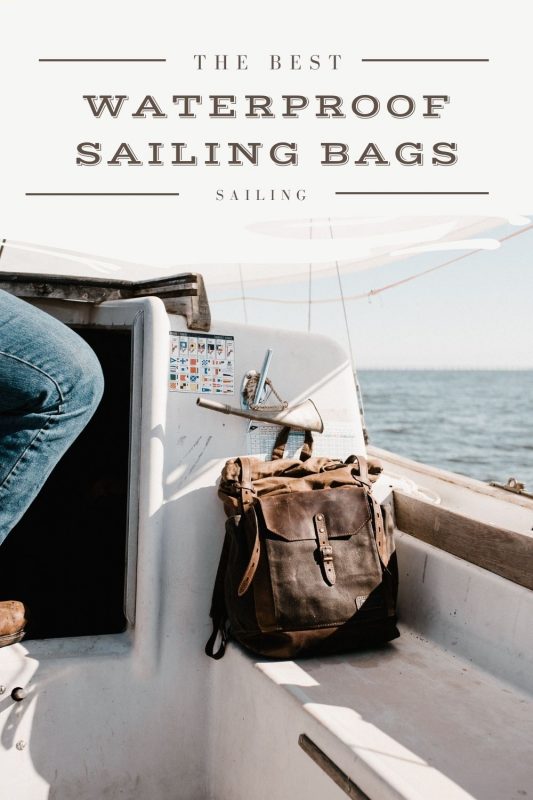
The 13 Best Sailing Bags 2024: Waterproof And Rugged Bags For Sailboats

Helly Hansen Hooded Crew 2.0 Ladies Jacket Review: Embrace The Elements With Style

What To Pack For A Sailing Trip

How To Make Cheap Fender Covers

Boat Tool Kit Essentials

14 Best Sailing Gloves 2024: Gill, Helly Hansen & More
Catamaran vs Monohull – Which is Better?
Which is better a catamaran or a monohull.
I’m often asked by my students why one would choose a sailing monohull or a sailing catamaran for their adventures. The simple answer is: There is no simple answer — it depends on a lot of things, perhaps the most important one is your preference. “Yeah, well, this is my first week sailing ever, so how do I have a preference?” Let’s explore the differences and discuss the ins and outs of sailing, chartering, performance, and living aboard either vessel.
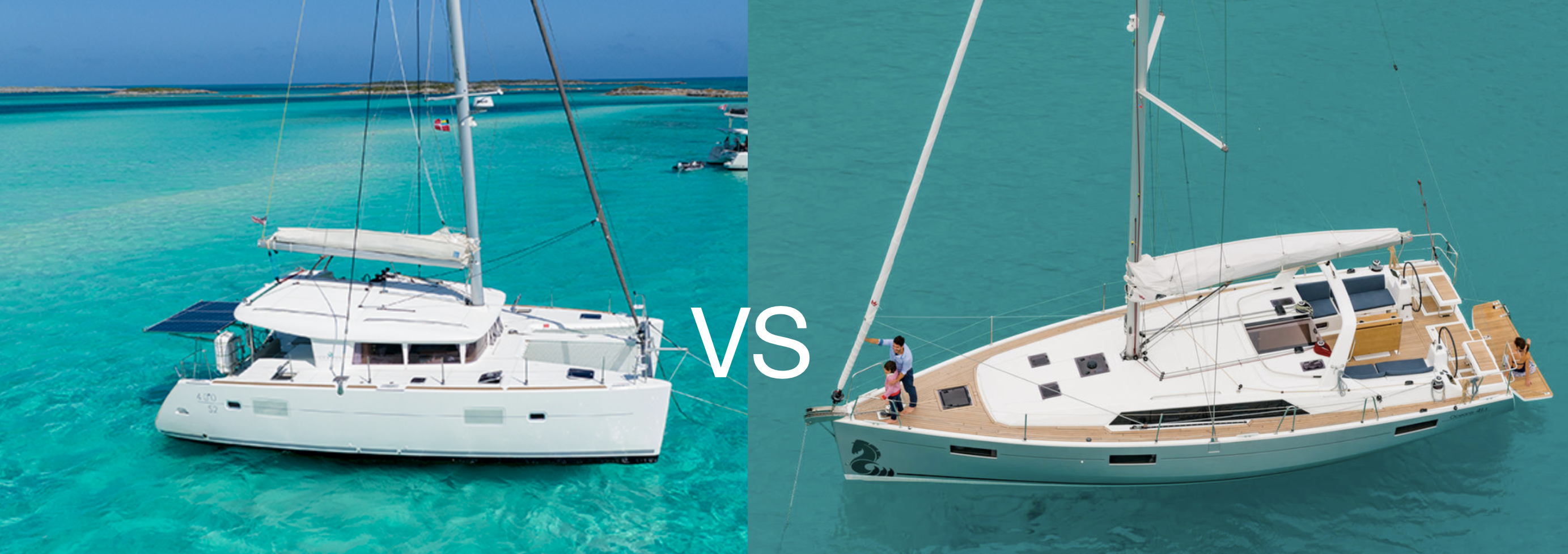
Notice that I don’t say “pros” and “cons” when considering the differences between the two vessels. To some, the gentle rocking of the monohull elicits nostalgia for a bygone youth spent sailing dinghies in the bay. To others, it represents sleepless nights, banging kitchenware, and angry spouses.
Short Summary – Catamaran vs Monohull
Generally, I describe my preference as follows: If I want to invite guests that are not frequently on the water, have less tolerance for “bumpy” nights, or expect a more “luxury” experience (you’ll see why I put it in quotes shortly) then I select a sailing catamaran. There is more room to spread out (vs the same length mono), rocking at anchor/mooring is minimized, and the kids love playing on the trampoline. Or perhaps phrased differently, “If you want to drink from beach to beach…”
DO NOT DRINK ALCOHOL WHILE OPERATING ANY VESSEL. EVER.
If, however, you want to put some miles down sailing from port to port in the Med (or wherever you have variable wind direction), then the mono is probably the better option. It has better upwind performance and costs less in marinas.
Let’s get into the details. We’re going to compare a suitable, common charter catamaran ( Lagoon, 40 ’) with a good, common charter monohull (Beneteau, 41’).
Sailing and Performance
The monohull total tacking angle is about 90-100 degrees apparent wind angle (AWA). This means that the closest close-haul sailing angle achievable is approximately 45-50 degrees off the wind. The comparable catamaran has a total tacking angle of about 110-120 degrees (55-60 degrees AWA off the wind). This loss is due to the extra leeway experienced in the catamaran. This is a significant difference when trying to beat to windward and can mean the difference between sailing the entire distance vs putting the sails up for show only. For those interested in math, the progress into the wind is determined by the cosine of the close haul sailing angle (angle of the wind) times the length of the leg on that tack.
windward distance = cosine(𝜶) x leg length
Where α is the close haul sailing of the vessel. Table 1 compares the windward distance achieved of 3 sailing angles over a leg length of 1 unit (nautical mile, km, etc). For example, if the leg length is 1 nm, and 7 legs are sailed, a total distance of 7 nm is covered. However, the progress to windward is not 7 nm, but
cosine(𝜶) x leg length = cos(45°) x 7 nm = 0.71 x 7 nm = 5.0nm
for a monohull sailing 45° to the wind, and 4.0 nm for a catamaran sailing 55° to the wind. The final difference after 7 tacks each is 1.0 nm, which would take the catamaran an additional 2 tacks (and just shy of 2 nm distance sailed) to make up the difference.
Table 1. Sailing Angle and Distance Comparison Sailing Angle (off the wind) Windward Distance Achieved % loss from 45°
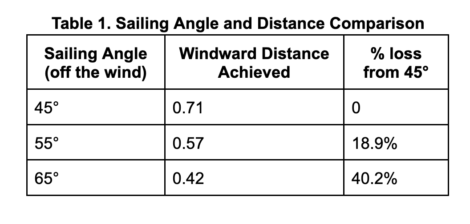
Figure 1. Sailing Angle Mono vs Cat
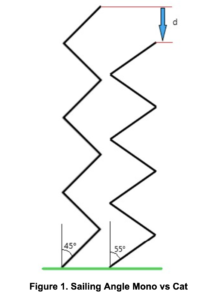
A real-life example
Sailing from Mallorca on a new Lagoon 40. We needed to sail directly upwind in about 20 knots of wind, 3 miles from Cala Mondragó to Cala D’Or. It took over 2 hours and we sailed over 7 nm. As you can see, the tacking angle is far from 90º typical to a monohull.
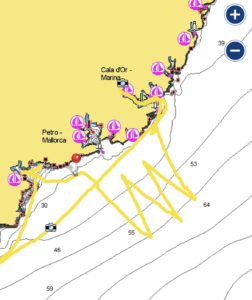
Additionally, the loss to each tack must be considered. Speed and headway is lost with each tack – the mono carries its momentum much better (minimal speed loss) through the tack and has minimal leeway loss compared to the catamaran. The cat loses a tremendous amount of its momentum and experiences significant leeway loss. And it has to take more tacks to make the same windward distance, rendering the loss greater than that just lost to having to sail a greater distance due to the tacking angle.
Daggerboards greatly reduce leeway and give catamarans excellent upwind performance on par with monohulls. There are reasons why all cats don’t just have daggerboards. Especially on charter boats, one mistake, leaving the boards down, in shallow water can destroy the boat.
Across the wind (most reaching situations), the catamaran is faster. Upwind, the mono makes better progress due to the tacking/sailing angle. Downwind is a competition.
Downwind is where catamarans really shine. The stability and smooth ride is no comparison to a monohull. We sailed Never Say Never, our Lagoon 400S2 from Hilton Head SC to Ft Lauderdale, we had a NE wind of 20-25 knots. For us to stay inshore of the Gulf Stream to avoid rough conditions, we were wing-on-wing for over 24 hours, surfing down gently at over 7 knots. We covered over 160 miles in 24 hours. Escorted by dolphins, this was one for the books —non-stop 3-day delivery.
Comfort & Stability
The catamaran doesn’t heel (well, it shouldn’t. I guess if that’s the case we’re having another conversation ). No heeling can mean easier walking about while underway: we’re all familiar with walking on level ground; walking with the ground at an angle is a less-common experience. However, there is an oft-missed discussion about the mono’s stability on a heel. Waves tend to roll under the mono’s hull. Once sea legs are found, the motion of the hull on the water is predictable and smooth.
The cat’s motion on waves tends to bounce between two “stable” states: one resting on the starboard hull, the other resting on the port hull. You get a slight, but sudden rock to starboard when the wave passes under the port pontoon, then a sudden return to port as the wave passes under the starboard hull. This tends to be a jarring motion all day. So while some argue that mono heeling is tiring, others will argue that this cat phenomenon is tiring. A sarcastic captain often says:
“One benefit of a cat, you get each wave twice!”
Each vessel has its own quirks for sail trim, so that is a wash. I can read a mono’s sails much easier than a cat’s, but I sailed monos for 20+ years before trying cats so I may be biased.
Catamaran vs Monohull Safety
The mono gives lots of feedback about being overpowered long before it becomes a problem: heel angle and weather helm are the loudest. The cat is much more subtle: mast and boom groans, light windward pontoon, lack of steerability. Experiment with the main traveller position and reefing on a schedule per the owners manual to find the optimum sail configuration on a cat.
When the seas pick up, catamarans do much better downwind. Monohulls tend to roll, yaw and wallow in the troughs and round up on the face of the waves. Catamaran’s tend to surf straight down the waves. A force 7-8 blow can be enjoyable. Stow your main and run with just the jib downwind on a cat and you’ll see the beauty and ease to steer this configuration.
“When the seas pick up, catamarans do much better downwind. Monohull’s tend to roll, yaw and wallow in the troughs”
Chartering and Living Aboard Considerations
Charter cost – cats are 30-60% more expensive than the equivalent mono.
In marinas, the cat rate is usually 50% greater than the mono rate. And, unless you get a reservation long in advance, they might not have room for you.
On moorings, depending on the bow cleat location, the mooring lines can run over or along portions of the hull of the cat. This leads to line stretch-and-relaxation noise all night long. For anyone in the forward cabins, this is a nightmare. Or worse since you can’t even get to sleep to have a nightmare.
Cats tend to have shallower draft and therefore can anchor closer to the beach. If wind and swell are from the same direction, cats tend to weather it better at anchor. Due to the bridle, cats do not swing on anchor. Older monos used to swing a lot, modern designs have reduced this swing tremendously.
There is lots more room on a cat to house the luxury amenities like A/C, water makers, and generators. Though, modern design is allowing for clever locations for these items in the mono, so there will probably be more monos becoming available with these options.
Cats tend to carry more potable water than the mono. They also carry more fuel. And burn more. Our weekly mono fuel bill ranges from $80-150 USD. Our weekly cat fuel bill ranges from $180-300 USD. (1.) Though you pay more for a catamaran, most systems are redundant. Two engines are better than one.
Catamaran vs Monohull Maneuverability
Cats are far easier to maneuver under power due to the two engines being separated by such a great distance. This makes picking up moorings, dropping and weighing anchor, and docking a breeze.
I would argue that monos are easier to manoeuvre under sail due to large rudders and heavy keels. The heavy keel maintains its momentum through manoeuvres much better than the cat. The large rudder means a small helm adjustment is quickly experienced in the respective heading. This large rudder also reduces steerage way to about 0.75-1.0 kts, whereas the cat is about 2.5 kts. While I doubt we’ll see cheaters , I mean bow thrusters, on 40’ monos, I have seen them on 44’ monos before. This added amenity makes up for greatly increased manoeuvrability while docking or weighing anchor.
Dinghy Storage
Storing the dinghy on the davits is a wonderful location for passages of any length. The reduced drag from not towing it is immediately seen in increased sailing speed. Monos must carry theirs on the bow or tow it astern. And you have to take the engine off too. Usually by hand, so you are not going to see a 20HP electric start engine on a dinghy for a 40’ mono. Not that you’d see that size for a 40’ cat either, but a 9.9 – 15 HP isn’t out of the question.
Ultimately, it boils down to what your preferences are. Do you like the extra space and amenities the cat provides? Do you like the sailing performance of the mono? Again, I choose a cat to sail from island to island in the Caribbean, where having a water maker or A/C is nice, fairly flat water is expected at all times, and anchoring close to the beach is a cool experience for everyone on board. I choose a mono to sail greater distances, go offshore, or hop from one marina to another in the Med.
1. This article was written in the spring of 2022, just before the crazy increase in fuel prices. As of publication date, these numbers need to be adjusted higher by about 50-100%

Ben Martin is a long-standing instructor at Nautilus Sailing. ASA 201, 203, 204, 205, 214 Certified Instructor, RYA Yachmaster Offshore, USCG 100 Ton Captain. Ben grew up in Northern Maine sailing dinghies on a lake. He graduated from University of Maine with a Master’s in Electrical Engineering. After working for the US Navy for a few years, he decided to pursue his passion on the water and worked as a charter yacht captain for several years in the Caribbean and the Mediterranean. Eventually, his career led to sailing instruction and he hasn’t looked back since.
- ← Prev Post
- Next Post →
HOW IT WORKS
Connect With Us
Plan Your Trip
START YOUR SAILING JOURNEY NOW
As featured in.

EXCLUSIVE EVENTS
The only way to join our tribe is to learn to sail with Nautilus.
We’re really careful to make sure that we know and trust anyone coming on one of our special trips.
Join us on flotillas, offshore deliveries, free webinars and unforgettable sailing adventures around the world. Join the Tribe.
- TERMS OF USE
- Privacy Policy
- Catamaran vs. Monohull: What Type of Boat is Right for You?
- Sailing Hub
- Sailing Dilemmas
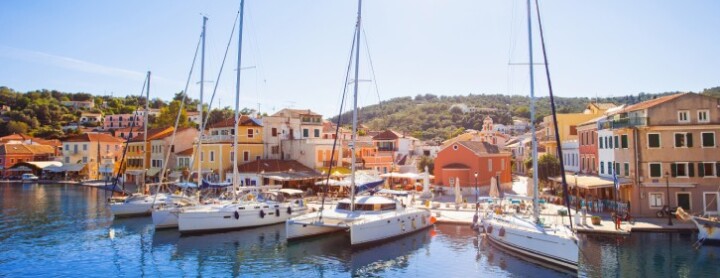
- Catamaran vs. Monohull - which one should you choose?
When you are planning a sailing holiday, you’ll be faced with a choice; catamaran vs. monohull. Each type has many benefits, but it’s important to think about what your needs are because that will tell you just which one to pick!
Let's dive right in!
Ease of sailing
Maneuverability, space/layout, holiday vibe.
You may also like: Sailing holiday destinations for your next boat trip
One of the top considerations you should have is what type of sailor you are because catamaran vs monohulls offer a distinctly different sailing experience. If you are a first time sailor and just want something incredibly easy to handle, then a catamaran will probably win out.
Catamarans have great control when it comes to maneuvering in tight places. Since they have twin engines and rudders, you get a lot of control and can turn pretty much 360 degrees with ease.
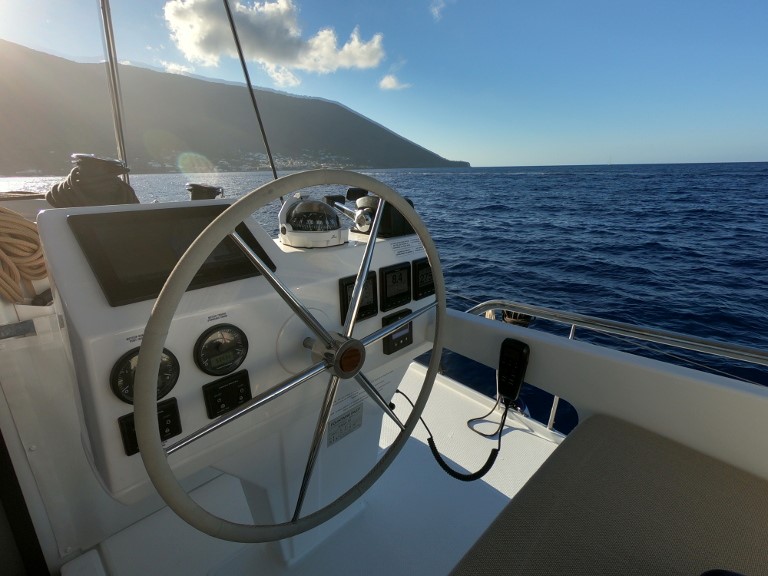
Catamarans also have a shallow draft, which will allow you to explore much closer to the shoreline than a monohull would be able to venture.
In the catamaran vs monohull speed debate, it might be more of a draw. Catamarans are typically 25-30% faster than a comparable monohull, but some argue that it comes at a price. When catamarans are sailing full speed you might experience a lot of slapping from the waves. Monohulls are designed to cut through the water. Also note that catamarans can be inefficient upwind and tack slowly.
When considering sailing conditions , a catamaran vs monohull in rough seas will perform very differently.
During rough sailing, you must be more vigilant when on a catamaran. The feedback from the wheel of a cat is not as obvious as that from a monohull. In high winds, you’ll need to know when to reduce sail.
However, monohulls tend to roll more in stormy weather, while catamarans stay pretty level even in rough seas.
When thinking about catamaran vs monohull stability, the stability that catamarans offer is a huge draw for many. Since cats bounce with the waves less, it is easier to walk around and enjoy the yacht while in motion. The increased stability is also great for children, or seniors, or anyone who might be prone to seasickness. When it comes to catamaran vs monohull seasickness, catamarans come out on top.
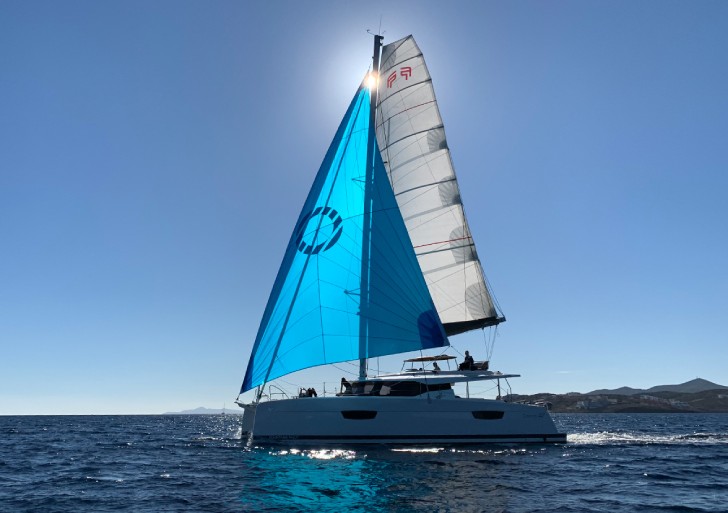
Although it is worth noting that monohulls swing less than catamarans if placed side by side in an anchorage.
If you’re deciding on a catamaran vs. monohull, you’ll have to think about what type of group you have. For family sailing holidays , maybe a catamaran is the best choice. Catamarans are very spacious, offering a large living space, and many cabin/head options. This makes them optimal for parties that want to spread out. Whether you’re a family, a big group of friends, or even couples looking for a 5 star, luxury experience who appreciate the extra space and comfort even if it’s not needed, a catamaran can fit your needs.
If thinking about catamaran vs monohull liveaboard readiness, the catamaran is a top contender. With far more living space and a much more spacious kitchen, Catamarans are great for people and groups that want to focus on entertainment and lounging.
Catamarans also typically have more spacious cabins and more privacy due to the layout with the cabins separate from the living area. This way you can send the kids to bed, and still enjoy the kitchen, dining, and living area.
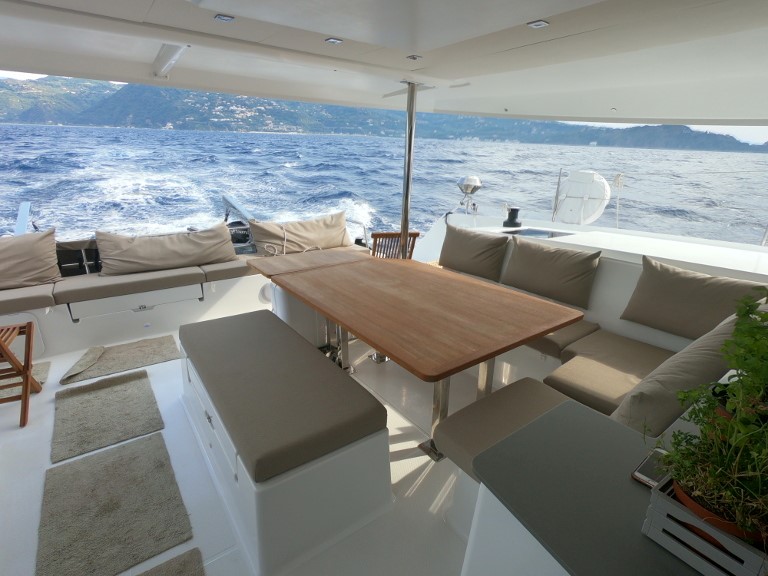
While catamarans are often touted for being roomy and luxurious, it’s worth nothing that monohull yachts can also be large and luxe. The Oceanis 62 and the Jeanneau 64 are top choices for those who want to live in the lap of luxury during their sailing holidays , while still getting that real sailing yacht experience.
In terms of catamarans vs monohull price , a monohull will definitely win. Charter prices for a catamaran can be 50-100% higher than that of a comparable sailing yacht. But that can be boiled down to the fact that you’re getting more space and more equipment with a catamaran!
A monohull, will only have one of everything - like it’s name suggests. It has one hull, one engine, one rudder, whereas a catamaran has twice the equipment and twice the living space of a monohull of the same length.
Another catamaran vs monohull cost to consider is the mooring costs. A catamaran, due to its twin hulls, might use two spots. Monohulls take less space to moor, and will be less expensive in that regard.
The cost of fuel should also be a consideration and in the question of catamaran vs monohull fuel efficiency, catamarans are the winner. With easy to drive hulls, and super light weight, they have great fuel efficiency.
Lastly, there is an abundant supply of monohull charters yachts, so the charter costs tend to be less to match the demand.
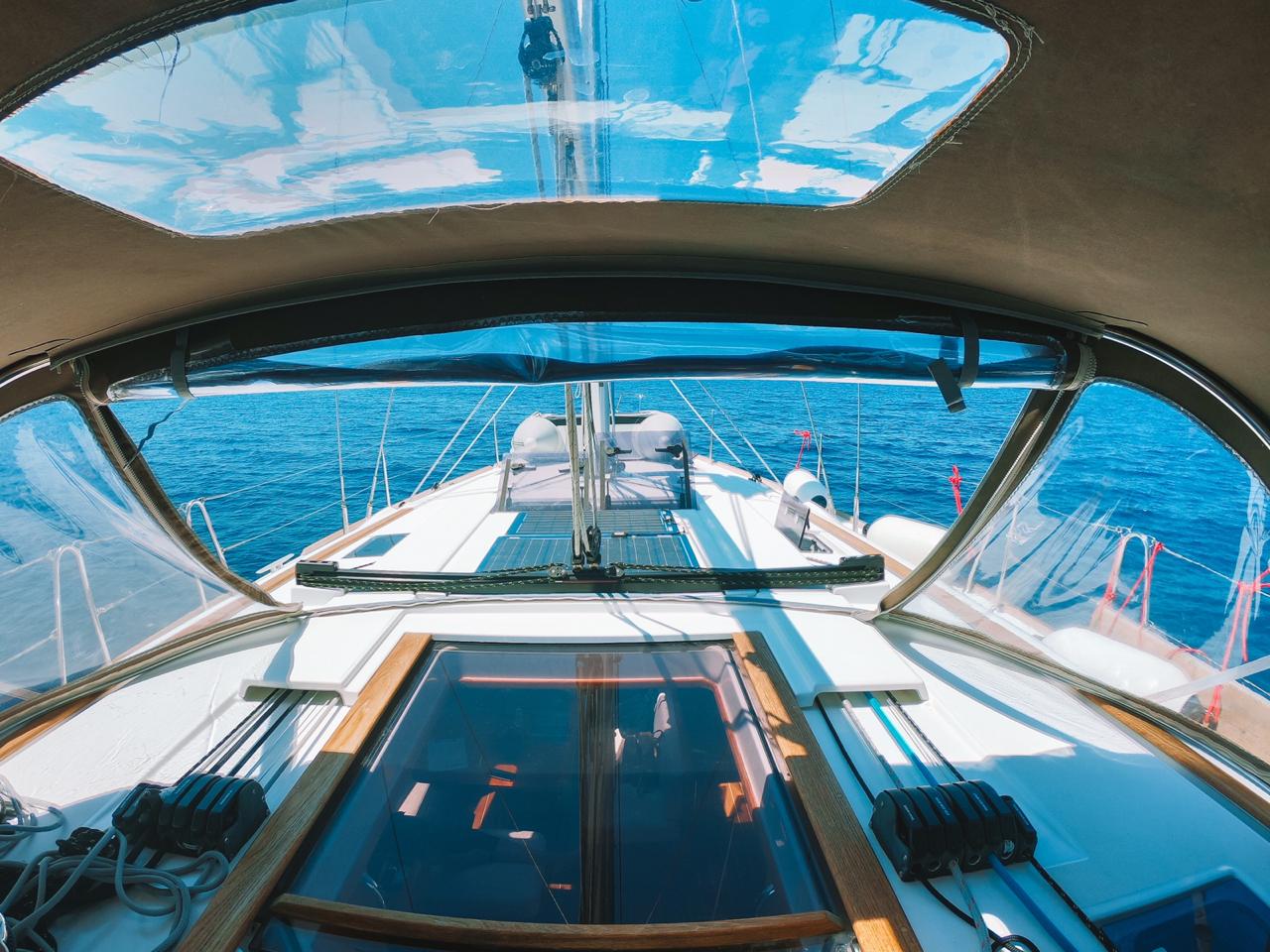
In the end, what it all comes down to is preference. In terms of performance, price, and comfort, catamarans and monohulls both have a lot going for them. You just need to decide what kind of holiday vibe you’re looking for, and Yacht4Less can help you with the rest!
At Yacht4Less we recommend fully crewed catamaran charters if you’re looking for top-of-the-line luxury and a super relaxing holiday where you don’t have to lift a finger. These boats will offer the space and comfort you’d expect from a 5-star hotel.
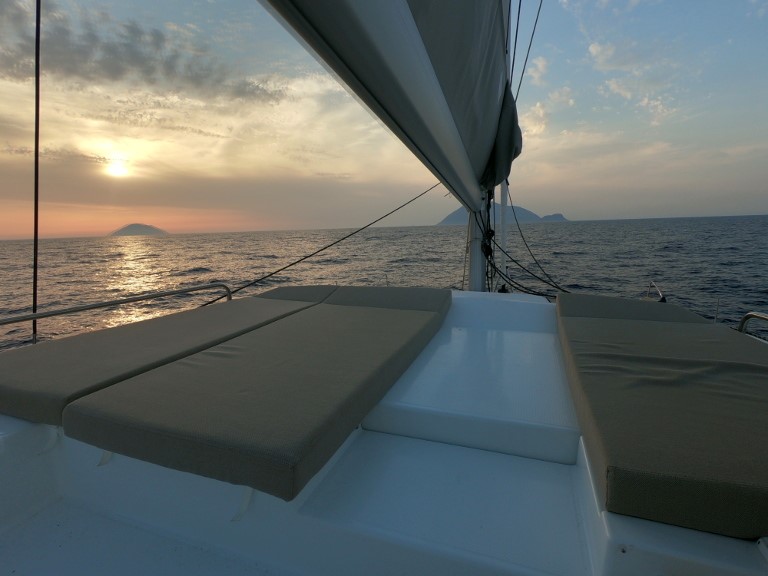
If you’re looking for a hands-on sailing adventure holiday, you might want to do a skippered charter with a monohull.. Your captain can show the ropes and help you learn how to sail. Or if you’re already an experienced sailor, go for a bareboat monohull charter . The exhilarating feeling of sailing a monohull is unmatched. It’s the classic romantic sailing experience, and makes for a thrilling holiday.
For those looking for a sailing experience somewhere in between extravagant luxury and exciting escapades, Yacht4Less is here to help you find the perfect boat for your needs. More sailing holiday dilemmas? We got you covered! Sailing Holidays vs. Land-Based Holidays » Party Sailing vs. Natural Wonders »
Get a free & non-binding quote

My Cruiser Life Magazine
Monohulls or Catamarans – Which is Best for the Cruising Sailor?
The debate between catamarans vs monohulls still rages, and most boaters are firmly on one side or the other. The truth is, either a catamaran or a monohull can provide a wonderful way to enjoy sailing, traveling, and being on the water.
Both have advantages and disadvantages, and both have large and loud fan clubs. The choice between a catamaran and a monohull depends on your budget, lifestyle, and personal preferences.
My wife and I have owned both types of vessels over the years. After five years of cruising on a Lagoon catamaran, we decided to go old school and bought our current boat—a heavy, full-keel monohull. The catamaran was fun, for sure—but it wasn’t for us in the end. Here’s a look at all of the differences we learned about during our journey.
Table of Contents
Life at anchor, life at a dock, life underway, living space, storage space, ride comfort and motion at sea, maintenance time and costs, docking and maneuvering, capsize risk, hull breach scenarios.
- Rigging Safety
Rigging Strength and Configuration
Monohull vs catamaran speed, thoughts on catamaran vs monohull for circumnavigation, deciding monohull vs catamaran, faqs – catamarans vs monohulls.
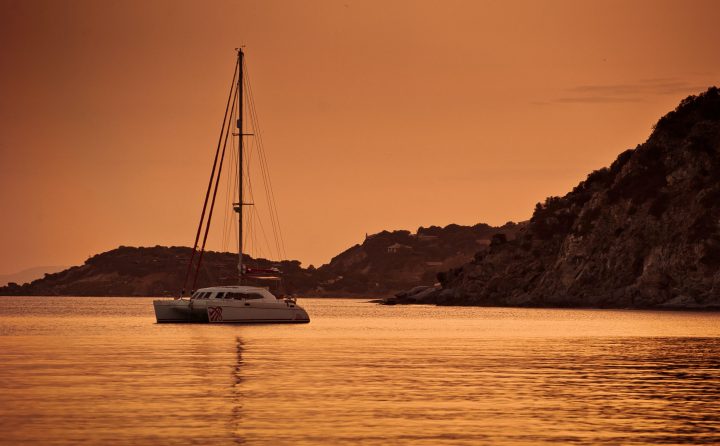
Life on Sailing Catamarans vs Life on a Monohull Vessel
At anchor, a catamaran provides superb comfort and living space. The “upstairs” cockpit and salon mean that boaters can enjoy non-stop wrap-around views. Monohull boaters are stuck in their caves and must peek out of their small portlights or climb into their cockpits to view the world.
A modern catamaran will also have swim steps that make it easy to get on and off the boat and provide easy access to dinghies and water toys.
If there’s an uncomfortable roll or swell in the anchorage, the catamaran’s stability will make the roll a bit less noticeable. Monohull boaters are more likely to be adversely impacted in a rolly anchorage. This does not mean that the cat owners are getting a perfect night’s sleep every evening, however. Catamarans just have a different motion in rocky anchorages, not a lack of motion.
Life at a dock gets a little more tricky for catamarans. Most marinas were built long before the catamaran trend and feature traditional slip sizes meant for monohulls. Marinas have to put catamarans on t-heads or make other accommodations. Therefore, it can be harder and more expensive to find a catamaran-friendly dock.
Once at a dock, the massive space of a catamaran can be harder to heat and cool efficiently. Catamarans usually need several air conditioners or heaters installed, whereas a monohull can get by with only one or two. That also means that cats might need more power (50 or 100 amp service instead of 30 amp) than some marinas can provide.
Monohulls will have fewer issues finding marinas that can accommodate them, and they pay standard rates.
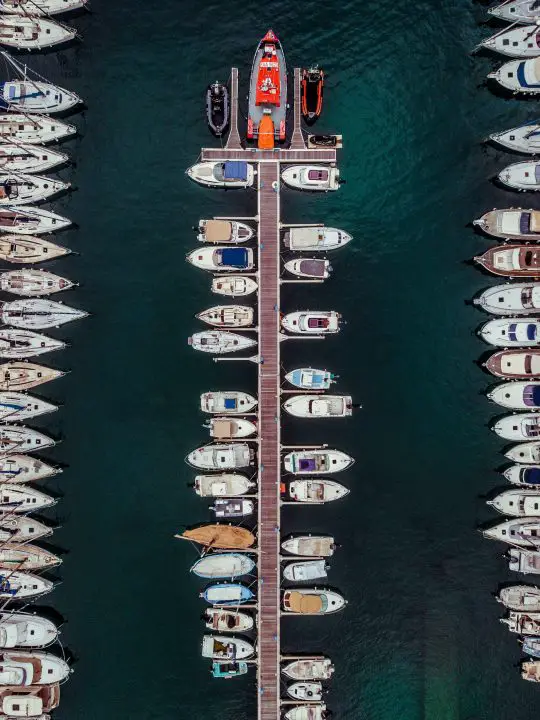
When sailing in protected waters, catamarans usually speed past their monohull friends. A catamaran provides a flat ride and sailors can move around their boats easily to make sail changes as needed. Walking on a catamaran’s deck is undemanding.
Catamaran sailors also have many options to rest comfortably underway. Because catamarans don’t heel over, catamaran sailors can sleep in their usual cabins. They can move about the interior of the boat with ease. Cooking in the galley doesn’t usually look any different underway.
In similar conditions, a monohull will heel over. Some sailors love the feeling of being heeled over and feeling the wind in their hair. Some don’t. It can be more challenging to walk the decks and work sails on a monohull vs a catamaran. While in the cockpit, monohull sailors will want to sit on one side and may even need to brace themselves to stay comfortable. For long trips, there is no doubt that living while heeled over for days at a time is exhausting.
Moving around the interior of a monohull boat at sea is also more challenging. Monohull sailors usually sleep in sea-berths with lee cloths instead of their usual quarters. It would be very uncomfortable to sleep in a v-berth underway, as the bow may be continuously pitching in seas. The lee-cloth in the sea-berth helps keep a resting sailor in their berth instead of falling onto the floor.
Monohull boats have gimbaled stoves. Even while the boat is heeled over, the galley stove will remain level. However, cooking in a monohull while underway is still more challenging than cooking in a catamaran since the cook needs to constantly brace themselves against the heel and rolling motion.
At the same time, none of this is to say that catamaran sailors have it easier at sea. In reality, catamarans may be more level, but they feel every wave in the ocean twice. The result is a choppy, bumpy ride with no rhythm. It can be just as tiring as being heeled over in a monohull.
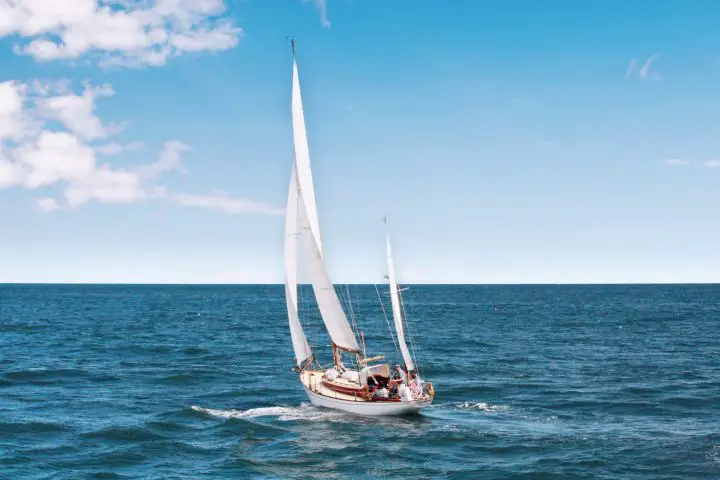
Catamaran vs Monohull Sailing Compared
Here are just a few ways that catamarans differentiate themselves from monohulls as platforms for living aboard.
- Living space—quantity and quality
- Storage space and weight
- Budget—purchase and routine maintenance
- Maintenance
- Catamaran vs Monohull for Circumnavigation
- Docking and close-quarters maneuvering
Catamarans have significantly larger and often more attractive living spaces. On the other hand, the living space on a monohull is usually small and can be dark due to small windows.
A monohull’s cockpit tends to be small and focused on safety. Families are more likely to feel in each other’s way, and moving around while others are seated can be awkward. On a catamaran, the cockpit is likely to be large and social. Catamaran cockpits have large tables and lots of lounging space in the cockpit.
Catamarans have large trampolines forward, which provides another comfortable, social lounging space that monohulls lack. Many catamarans also feature additional lounge space via the large cockpit roof.
The salon on a monohull is located in the main cabin. A monohull’s salon will be smaller than a similarly-sized catamaran. Often there is a small table, room for several people to sit, and a single sleeping berth.
Catamarans feature a wide bridge deck that crosses both hulls. This large living area features great visibility, ventilation, and natural light. On some catamarans, the galley is located on the bridge deck (called “galley up”), and on others, the galley is located in one of the hulls (called “galley down”).
Monohulls have sleeping quarters in the bow and stern of the boat. On smaller monohulls, the main sleeping area is usually a v-berth. Older, smaller monohulls usually have just one head.
On a catamaran, the sleeping quarters are located in each hull. These cabins often feature regular-sized boat beds and large en-suite heads. Cabins on a catamaran usually offer more privacy than monohulls.
Catamarans are popular with charter companies because large families or groups of friends can enjoy living on a boat together in style and comfort. Each will have a private cabin and a private head. In addition, if you want to find space to exercise, do yoga, or watersports, you’ll find these activities much easier and more comfortable on a catamaran.
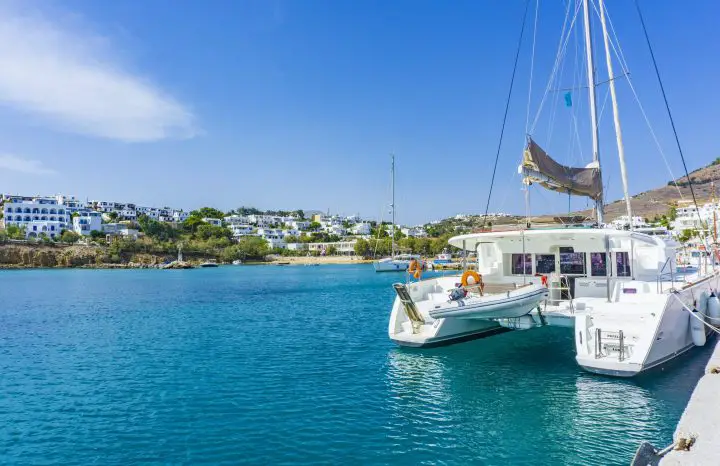
Catamarans have more space in general and certainly have more storage space. The additional deck space catamaran designs offer lends to easy storage for larger items, such as paddleboards and kayaks. Catamarans can often hoist and store larger dinghies than monohulls can. Large compartments make storage easy.
However, many catamaran owners are very cautious about storing too much. Additional weight can slow down a catamaran’s performance speeds. With so much space to put things in, it’s remarkably easy to overload a cruising catamaran. Many owners complain about the performance of smaller cats, when in reality they are often just badly overloaded.
Monohulls have less space and less storage. Finding space for big items like water toys can be challenging. But monohullers worry less about weight and freely carry around their cast iron skillet collections—because weight doesn’t impact performance on a monohull nearly as much.
This is a consideration when cruisers consider adding additional equipment. For example, a catamaran owner will have to consider the added weight of a generator and its detriment to sailing speed. In contrast, a monohull owner will have to consider finding space for the new generator.
Some prefer the motion of a monohull while sailing. Monohulls heel over but are steady, and sailors usually get used to the heeling motion. On a catamaran, if conditions are good, the boat won’t heel and will provide a comfortable ride.
When sailing upwind, some catamarans experience bridge deck slamming. Waves get caught between the two hulls and create a slamming motion and sound. It’s hard to predict the timing and strength of each slamming motion, so some catamaran sailors can find it tiresome.
The amount of bridge deck slam varies from boat to boat. Catamarans with higher bridge decks will experience less slamming, while boats with bridge decks closer to the water experience more.
Beyond that often-discussed issue, there is also the issue of the boat’s motion. It’s very difficult to imagine how different the motions are when compared to one another. The monohulls slice through the waves, usually with a predictable rhythm. A catamaran, built lightly to sail fast, feels more like it bounces over the tops of waves. The crew will feel each impact as each hull hits each wave. The result is a choppy, unpredictable motion—but it’s generally flat and level.
Monohulls have been around for ages. Therefore, sailors just starting out can find inexpensive, older monohulls. If you have a tight budget, you’ll probably start looking for a monohull.
Catamarans are newer to the market. Therefore, the initial purchase price of a catamaran is likely to be higher. Monohull buyers can often find a used, well-equipped, comfortable monohull for less than $100,000. Catamaran buyers usually spend upwards of $250,000 for a used cruising catamaran.
Because monohulls have been produced for so long, there is much more supply. The catamaran’s more modern pedigree means that there are always fewer catamarans on the market than monohulls. As more and more customers are drawn to the attractive living space and stable sailing offered by catamarans, demand keeps going up, while supply remains low.
Besides the higher up-front costs, catamarans are more expensive to keep and maintain. A monohull usually just has one engine. A monohull might have one head (bathroom) and will generally have less equipment. Monohulls have less space and storage, after all. Catamarans have twin engines, multiple heads, more hatches—more everything.
With more equipment, catamarans have higher maintenance costs. When a monohull owner services their engine, they have just one engine. A catamaran owner will need to service twin engines. Furthermore, each hull on a catamaran usually has separate and independent systems like bilge pumps, plumbing, fuel, water tanks, holding tanks…the list goes on.
A monohull owner will paint one hull bottom and wax only one hull. A catamaran owner will do everything twice. Therefore, the effort and cost of maintenance are often doubled on a catamaran.
Not only does it cost more money, it can also be harder to accomplish maintenance on a catamaran. You see, catamaran owners have fewer options to haul out. Most older boatyards have travel lifts that only accommodate boats up to 18 or 20 feet wide. Therefore, catamarans need to find a boatyard that has a large enough travel lift or a trailer to haul them. Because there is less supply and more demand for these larger travel lifts, the cost of hauling out a catamaran is often higher.
While some monohulls have lifting or swing keels and can reduce their draft, most catamarans have a shallow draft. This allows them greater flexibility while choosing anchorages. Even if a catamaran and monohull boat choose the same anchorage, the catamaran can get closer to shore and get better wind protection.
One final big difference between these two types of vessels is their ability to maneuver in tight spaces. Monohull sailboats are notoriously difficult to maneuver around docks and marinas. They often have poor visibility from the helm and difficult handling, especially in reverse. The single-engine design often requires a bow thruster, even on smaller boats.
The contrast that catamarans offer is pretty stunning. Even though they appear massive and ungainly in comparison, their twin engines mounted far outboard enable them to spin in their own length. Catamarans can be maneuvered in pretty much any direction using only differential thrust from the engines–all without a bow thruster.
Safety Considerations — Are Cruising Catamarans Safe?
Since most people have only limited experience with these vessels, many people wonder are catamarans safe. Even though they have been making large cruising cats for decades now, most of us have only really played on Hobie cats at the beach. And if there’s one thing we know about Hobie cats, it’s that they’re a lot of fun until you flip it over!
Here’s a look at a few safety considerations and how catamarans stack up against monohulls.
- Catamaran stability — capsize potential
- Hull breaches and sinking risk
- Rigging failures
- Designing for speed
- Redundancy on board
So, can you capsize a cruising catamaran? The answer is yes, no matter what the fanboys and girls say. It is technically possible but highly unlikely. Cruising cats are massive, and in all likelihood, you’re more likely to break the rigging than flip the boat. But in rough seas and extreme conditions, it does happen even on modern catamarans.
If a monohull encounters strong winds and rough weather, it will heel and roll significantly—but it will keep righting itself. In dire conditions, the vessel could suffer a knockdown. But a monohull will always right itself after a roll—it has tens of thousands of pounds of heavy keel to ensure that it does. Of course, the rig and anything on deck will sustain serious damage in the process, but the boat will be upright in the end.
In the same scenario, while unlikely, a catamaran can capsize. And the catamaran will then remain capsized, with no possibility of righting itself.
One of the scariest risks at sea is that of a serious hull breach, one that a bilge pump couldn’t keep up with. For example, a boat could be holed by an errant floating object or suffer a stuffing box or through-hull failure.
If a monohull sailboat is holed, it could sink straight to the bottom of the ocean. The crew would be left with only a liferaft and whatever they were able to recover before the sinking.
But a catamaran is filled with foam and is (more or less) unsinkable. If a catamaran experienced a hull breach or capsizes, it would take on water and may become less habitable. However, it will still float. In many cases, not much of the boat is left above the water—but it’s still at the top of the water.
Boaters may be able to perform emergency repairs and get the boat to port themselves. Or, they may have to stay with their vessel until help arrives. In either scenario, the crew maintains access to supplies and can stay with a much larger vessel, increasing the likelihood of being found and rescued.
Some catamaran sailors are so certain of their vessels floating in all scenarios that they don’t even carry a liferaft aboard. This is fool-hearty, to say the least, given the crazy and unpredictable things that can happen to any boat on the ocean. But one scenario is equally scary for the monohull or the catamaran sailor and should convince everyone that any offshore vessel should have a liferaft—the possibility of an uncontrollable fire.
Rigging Safety
When wind speed increases, a monohull will heel over. This heeling motion sheds the excess power of the wind. Monohull boaters should pay attention to the weather and reduce sail to ensure they aren’t overpowering the boat. This is why knowing how to reef a sail is so important for all sailors.
However, on a catamaran, the sails and rigging take the increased load when wind speed increases. Catamarans don’t heel, and therefore, don’t shed excess power. If the weather becomes gusty and a catamaran has too much sail up, all that extra power is transferred to the sails and rigging.
This can cause a dangerous situation. For example, there have been reports of catamarans being de-masted in sudden gusts of wind. In a worst-case scenario, a catamaran could capsize if they are over-canvassed when experiencing extreme wind conditions.
Most monohulls have strong standing rigging. The forestay is connected to a solid structure, the hull. This means that the forestay has a strong, stable platform and gives a monohull better upwind performance. Monohulls also usually have backstays, which provide rigging redundancy.
On a catamaran, the forestay is attached to a crossbeam. Because the platform is not as rigid as a monohull’s hull, the forestay is not as strong. In addition, catamarans usually don’t have backstays, and therefore have less rigging redundancy.
The configuration of the rigging is another rigging consideration. On a monohull, the spreaders and shrouds are perpendicular to the mast. Most catamarans come with fractional rigs that don’t have backstays, and their shrouds are set far back. Because of this configuration, catamaran sailors can’t let their mainsails out all the way on a downwind run because the shrouds are in the way. This leads to less efficient sail shapes when sailing downwind.
However, catamaran sailors can rig their sails to sail wing-on-wing. While monohull sailors can also use this configuration with the help of a whisker pole, catamaran sailors have a nice, wide, stable platform to fly large downwind sails.
There’s no doubt about it–catamarans sail faster. Most articles and comparisons state that catamarans are about 20% faster than a similarly sized monohull. Catamarans have a lower wetted surface area and less drag than monohulls. They’re especially nice to sail in light winds, conditions that heavy cruising monohulls tend to not do well in.
While most cruising cats can’t sail upwind as high as monohulls can, they still win the race. However, if a catamaran has daggerboards and a good sail inventory, it can point as well as a monohull.
Many boat owners believe that speed equals safety, as you might be able to outrun an impending storm. That’s a debatable strategy since weather systems often move faster than any cruising boat can move. It has a lot more to do with planning and the decisions made by the skipper, in the end.
Furthermore, more speed means a rougher ride. A heavy, full-keeled monohull might not move very fast, but the sea-kindly and forgiving ride means a more comfortable and better-rested crew. This only goes to illustrate that the “more speed” argument is far more of a personal preference than many sailors admit—especially when it comes to long-distance cruising.
A faster boat provides a skipper with more options, but it does not ultimately equal inherent safety. That will always come down to the skipper and the crew, and the choices they make. A slow boat in the hands of an experienced and careful crew will always be safer than a fast racer under the command of an inexperienced and green crew. In other words, there is no replacement for seamanship and careful planning.
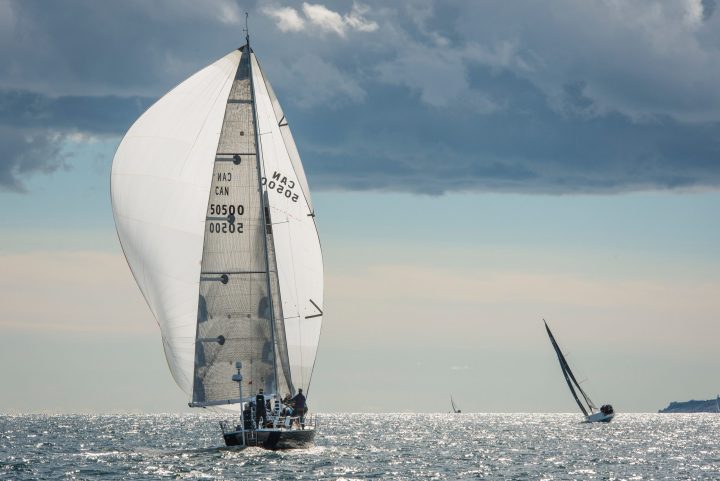
Catamarans have two of everything. While this does equal double the cost and maintenance, it also provides redundancy. If a monohull’s single engine dies and there is no wind, they may have to call for a tow or wait for wind. If a catamaran’s left engine dies, sailors can just continue on the right engine.
Twenty years ago, the majority of boats completing circumnavigations were classic bluewater monohulls. Monohulls are considered safe and capable circumnavigators.
But today, catamarans are establishing themselves as the more desirable choice for many circumnavigators. Catamarans are fast, stable, and capable of crossing oceans. In addition, catamarans can carry significant supplies and offer redundancies. Plus, the extra space that catamarans provide also means that the crew will enjoy watersports like diving, paddle boarding, and surfing.
Since nearly all traditional routes are downwind “milk runs,” catamarans naturally excel along the way. If you take a look at the competing boats for the World ARC rally for the last few years, a definite trend is growing. More catamarans compete every year. Common entrants include Lagoon 450s and Antares 44s.
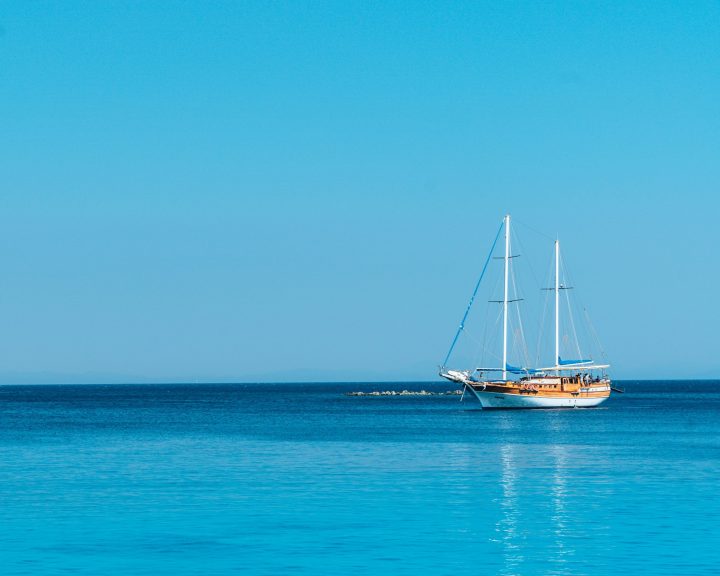
One of the most significant decision points when thinking about catamarans versus monohulls is your budget. If your budget is under $100,000, a monohull will be your best bet. If your budget is between $100,000 and $250,000, you can consider a smaller, older catamaran. Catamarans such as PDQs, Prouts, and Geminis will be in your budget. If you have a budget of over $250,000 and can afford higher dockage and maintenance costs, you can consider a catamaran.
Next, consider your comfort level. To try it out, you might want to charter both a monohull and a catamaran. Check out a sailing vacation in the BVI or with a company like Cruise Abaco. Taking classes at our local sailing school might also be helpful. https://cruiseabaco.com
Many folks are attracted to the larger, more comfortable spaces of a catamaran. However, some people feel more seasick on a catamaran and can’t get used to the motion. So a lot of your decision will come down to personal preference.
If you can’t imagine squeezing into a darker, smaller cabin in a monohull, then a catamaran might be calling your name. On the other hand, if you are a traditionalist who loves heeling and boats with a lot of teak, a monohull might be your dream boat. It’s just impossible to know how a boat will make you feel until you’ve experienced both.
Boaters often discuss the compromises involved in boat choices. Whether you choose a monohull or a catamaran, there will be some compromises involved. However, no matter which boat you choose, you can enjoy smooth sailing, beautiful anchorages, and some adventure along the way.
Worried about getting caught in severe storm conditions in your boat ? Visit our guide!
Which is better monohull or catamaran?
Both monohulls and catamarans are popular choices for cruising sailors. Which one is better depends entirely on your personal preferences and which boat is more comfortable and appealing to you. If you are on a tight budget, a monohull is your best choice. On the other hand, if you love large open living spaces, a catamaran will be the better option.
Which is safer catamaran or monohull?
When wondering are catamarans safe, always remember that the primary determinant of the safety of a vessel is its captain, not the vessel itself. Both monohull sailboats and cruising cats have important limitations that their skippers must know and abide by.
Some consider catamarans safer because they are virtually unsinkable. If it has a hull breach or capsizes, it will still float.
Others see the sea-kindly monohull to be the safer bet, as they are better designed to protect their crews from the elements in severe weather. They also cannot capsize, as their ballast provides a righting moment in all conditions. But on the other hand, if a monohull experiences a hull breach, it can sink.
Can catamarans handle rough seas?
Modern cruising catamarans are built strong enough to cross oceans and survive in all kinds of conditions. It might be an uncomfortable ride, but not an unsafe ride. In the end, it is the skipper of the boat who ensures its safety at sea. Good seamanship makes a far bigger difference in how a boat handles rough seas than the design of the boat does.
In extreme conditions, such as hurricanes or sudden gusty winds, catamarans can capsize. Once a catamaran has capsized, it won’t right itself. However, it will still float, although upside down. Heavy seas are more likely to cause maintenance and chafing issues on both catamarans and monohulls.
Matt has been boating around Florida for over 25 years in everything from small powerboats to large cruising catamarans. He currently lives aboard a 38-foot Cabo Rico sailboat with his wife Lucy and adventure dog Chelsea. Together, they cruise between winters in The Bahamas and summers in the Chesapeake Bay.

- Virtess 420
- Sorrento 32 Hard Top
- Sorrento 36 Hard Top
- Southerly 420
- Southerly 480
- Southerly Swing Keel
- View Available Inventory
- Yacht Search
- Featured Sail
- Featured Power
- Southerly Yachts
- Island Packet
- Bavaria Yachts
- Buyer Representation
- Sell Your Boat
- Variable Draft Specialists
- Testimonials
- Meet the Team
- Our History
POWER CATAMARAN vs MONOHULL
Introduction.
The benefits and compromises of owning a power catamaran are usually obvious for different consumers, depending on their circumstances, boating ambitions, and level of experience. However, a rapidly growing number of seasoned boaters are learning the joys of owning a catamaran and end up becoming firm catamaran supporters.
We have witnessed amazing changes to how families go boating together on a catamaran. For many families, the catamaran yacht has enabled their kids to join and bring their friends without overcrowding the boat. Guests do not have to be seasoned yachties to enjoy the day in the stable and protected cockpit. While entertaining can be done with style and without stress.
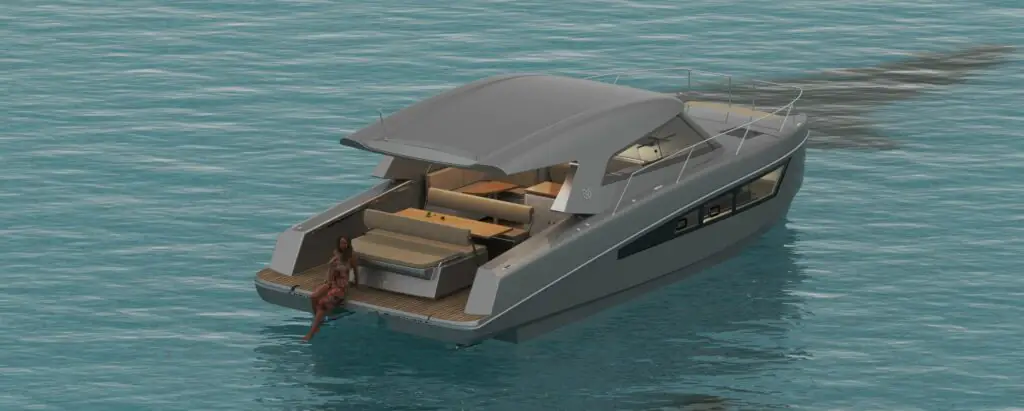
The most compelling argument of all must be this: seasoned monohull boaters are converting to catamarans by the truckload. Many converted former motor yacht owners are now passionate advocates of power catamarans. For experienced yachties demanding performance, the advantages are simply too great to ignore. It is rare to hear of any catamaran owners ever going back to a monohull. Once you become a catamaran owner, you are hooked for life.
“Why should I buy a power catamaran instead of a similar sized motor yacht?”
We are regularly asked by buyers “why should I buy a power catamaran instead of a similar-sized motor yacht”. Like everything, there are benefits and compromises to the power catamaran. Despite ourselves being firm Catamaran converts and lifetime believers, below we offer a balanced comparison of the pros and cons.
Advantages of Monohulls
A monohull, as the name implies, has just one hull. This is the most common type of hull design, but why? To produce a well-balanced comparison let’s start by investigating the benefits of monohulls:
Slow roll period
- Many brands and builders to choose from
More usable space below the waterline
Familiar handling.
While monohulls roll back and forth far more than a catamaran, monohull fans will argue that the slow roll period of a monohull has a comforting effect.
There any many brands and builders to choose from as most builders still only produce monohulls. Whilst this trend is changing, 50+ years of composite boat building has been heavily monohull focused. This does mean that there is a far greater selection of vessels, designers and brands, and builders to select from.
Whilst the monohull comparably has less interior space, the wide waterline beam (width) allows for greater use of the internal hull height. This either enables builders to mount tanks and storage below cabin floors or to actually expand the cabin below the waterline. As a catamaran gains performance via its light displacement and narrow waterline beam, this is often not practical on a catamaran.
Jumping from one boat to another will feel extremely familiar as the differences in handling between brands is minimal, with the exception of planning hull vs displacement hull. Focusing on planning hulls, however, you will quickly feel familiar jumping from one boat to another. On the contrary, the differences in handling from a monohull to a power catamaran are immediately apparent.
Disadvantages of Monohulls
Now that we have seen the advantages of a monohull, let’s analyze some disadvantages one might encounter while boating on a typical V-bottomed or deep-V motoryacht.
Low stability
Bow steering, rolling at anchor, significant bow rise.
Due to the wide flat hull shape required to get the monohull more quickly into planning mode, it can produce a rather bumpy ride when motoring through waves. Performance through waves can be significantly improved or diminished depending on the hull shape. For instance, a deep V hull will be more comfortable through waves than a shallow V. However, both are significantly outperformed by even the worst power catamaran designs.
A monohull’s heel angle is directly affected by weight placement. Moving too much weight to port or to stbd will cause the vessel to heel. This is significantly noticeable when at anchor however even underway an incorrectly loaded monohull can dangerously heel. This can be overcome underway by the use of trim tabs. However, is best overcome by conscious weight placement and management.
Bow steering usually occurs when motoring at speed in a following sea or when passing another vessel’s wake. If you are inexperienced and do not know what is happening it can be quite frightening. Basically, the boat will suddenly and often expectantly turn hard in one direction while rolling hard in the opposite direction, despite your efforts to steer straight. Bow steering can be prevented with the installation of trim tabs. They can enable you to raise the bow up and out of the water when in a following sea. Trim tabs are not needed on a catamaran due to the natural separation of hulls’ bow steering.
At times you will undoubtedly come across anchorages that aren’t completely flat. When this happens, monohulls, that rely on the weight of their COG (center of gravity) to be aligned below their COB (center of buoyancy) to keep them upright, will start to rock from side to side. Things roll around inside, plates go flying. It’s uncomfortable or sometimes impossible to cook, and only the hardiest of yachties will be getting any sleep.
While all of this is going on, at the next mooring ball, the power catamaran owners are sitting in their cockpits sipping sun-downers, barely noticing the movement, quietly getting tipsy before a long night’s sleep.
The degree of bow rise varies with monohull designs. However, for those of you unfamiliar with this term, bow rise is the tendency of a boat to point its bows up in the air before it gets into planning mode and then settles somewhat. This puts passengers through an uncomfortable, and sometimes unnerving experience whilst also exposing the vessel to a decreased level of stability and safety.
POWER CATAMARAN
Advantages of power catamarans.
Whilst individual designs can vary by design and their usage, the benefits below are typically universal for most catamarans. In comparison to the equivalent length monohull a catamaran shall deliver the following advantages:
Superior ride comfort
Enhanced stability at anchor and underway, up-scaled cabins and interiors, larger single-level cockpit and saloon, significantly improved fuel consumption.
- Drastically improved close-quarter maneuvering
Catamarans experience slower deceleration through wave impact. This significantly reduces slamming through waves. This has been measured with accelerometers in like-for-like tests to have a 25% reduction in G forces when riding over waves.
Due largely to their wider beam, catamarans have a remarkably higher righting moment compared to monohulls. This prevents them from rolling side-to-side when at anchor, and keeps them sitting level both underway and at rest. This is regardless of the placement of people or luggage, this also eliminates the need for catamarans to use trim tabs.
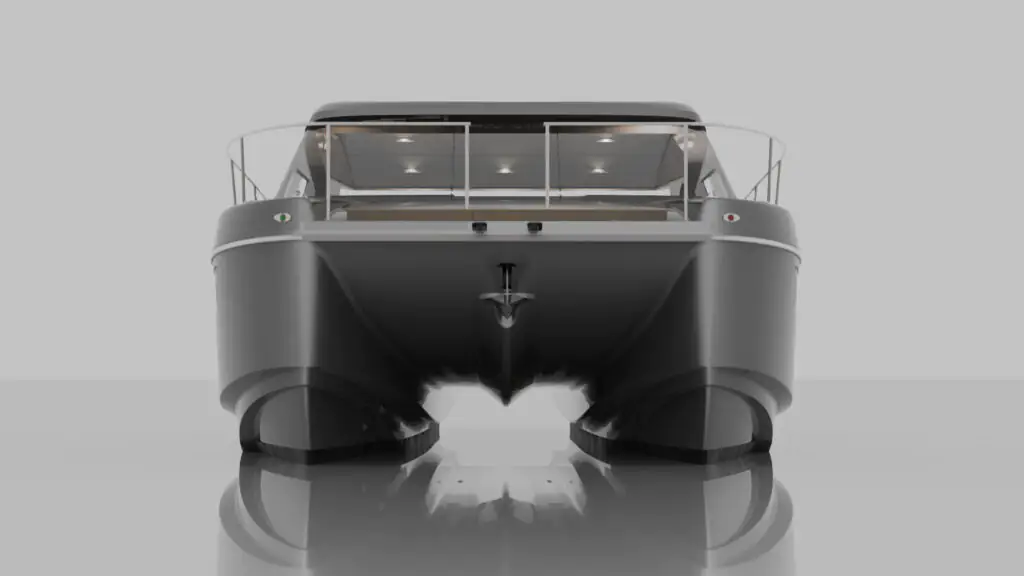
More interior volume, especially in power catamarans that carry their beam all the way forward. Even applicable in the smallest cats that usually have stand-up headroom in each cabin, unlike smaller monohulls. As a result of this increased volume, a power catamaran will always feel oversized – more fairly compared to a monohull 15-20% longer in length. A 35ft power catamaran for instance is more fairly matched against a 43ft motor yacht.
Catamarans generally provide far more living space in the main salon and cockpit in comparison to similarly priced monohulls. The galley, main salon, and cockpit are also all on one level, above the water line…making life aboard, as well as your view much more enjoyable.
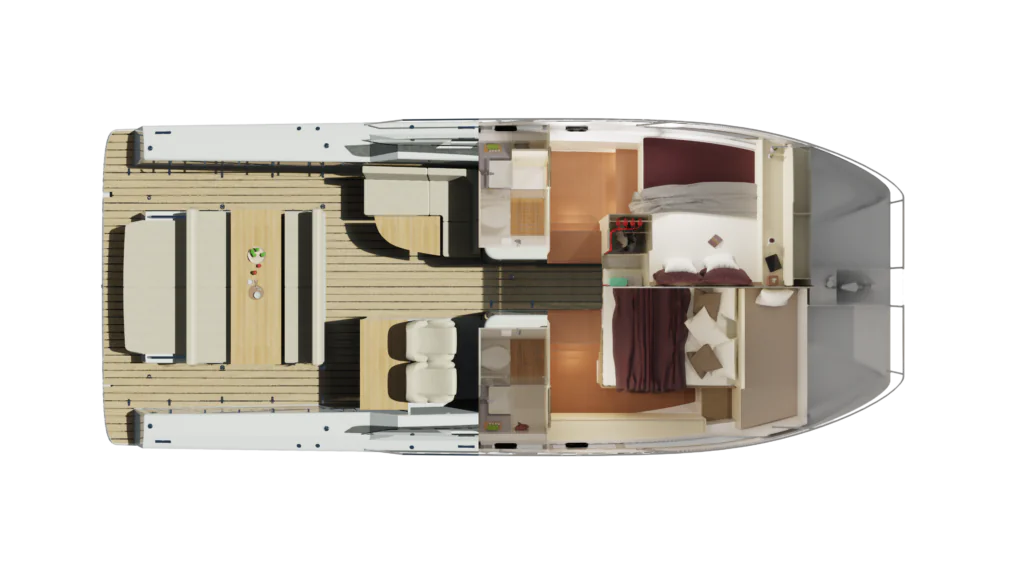
Due to their reduced displacement and wetted surface area power catamarans are impressively efficient. The wider monohull bows create a large bow wake and greater resistance, which require more HP to get onto a plane. Not only does this burn more fuel, but also enables a catamaran to get onto a plane under just one motor. This is a significant safety advantage, enabling a boat with only one working engine to return to shore before dark rather than limping home at below planing speeds. The ability to plane at lower RPMs enables cruisers not wanting to travel at groundbreaking speeds to achieve highly efficient low-speed planning. Vastly expanding their cruising ground while not breaking the bank nor taking all day to get to the next anchorage. Learn more about power catamaran fuel consumption HERE>>
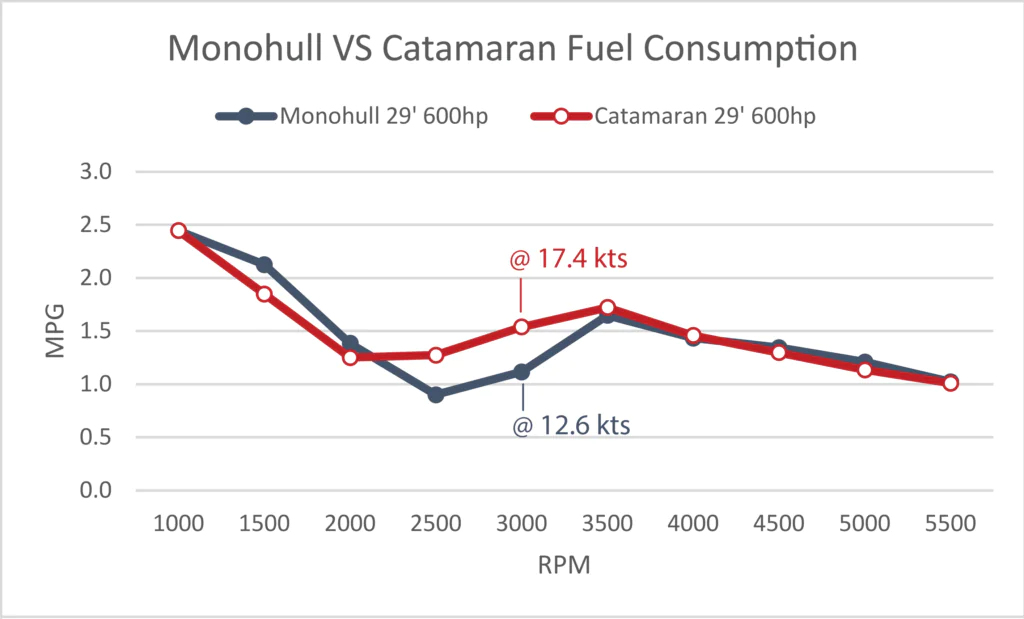
Drastically improved close-quarter maneuvering: A large separation between the port and starboard engine drastically improves close-quarters maneuvering. This enables a power catamaran to literally rotate within its own waterline length by simply putting one engine in reverse, and one in forward. Add a joystick control and you’re in command of one of the easiest boats that you will ever dock.
Disadvantages of Power Catamarans
Despite the significant benefits gained by the power catamaran, there are also a few unusual traits associated with powercats:
Outward banking
Snaking at anchor, tunnel-slap, unusual appearance.
When making sharp turns a monohull will bank (roll) into the turn. A catamaran, on the other hand, due to its increased stability and righting moment will actually bank slightly outward. If coming from a monohull background, initially this sensation will feel unusual. However, If you have no prior expectations regarding the outward bank offers, no benefits or disadvantages over the inward bank.
Due to the power catamaran’s wide beam and asymmetry, when at anchor a shifting breeze will cause the vessel to turn to port and starboard in a snakelike movement. If the wind has some strength and continues to shift, this movement can become uncomfortable. We, therefore, recommend attaching an anchor bridle whenever anchoring which completely eradicates this effect.
In certain conditions, catamarans can experience tunnel slap. This is where a wave passing under the tunnel rises up and slaps the wingdeck surface causing a thud or slapping sound. This effects different catamaran designs in various ways depending on whether they are of displacement or planning type. A displacement catamaran requires a high wingdeck to overcome the wave crest heights in order to ride over the top of the waves. Planning catamarans, on the other hand, should have narrower and shallower tunnels. This forces a compressed air mixture through the tunnel, creating a cushioning and lifting effect lifting the catamaran above the surface of the water with intensity increasing as speed increases.
When asked, many monohull owners claim they do not like the unusual appearance of a power catamaran. Whilst styling preference is subjective, at Makai we have worked hard to design a power catamaran that delivers all of the benefits of a catamaran. Whilst doing so with attractive and unmistakable styling.
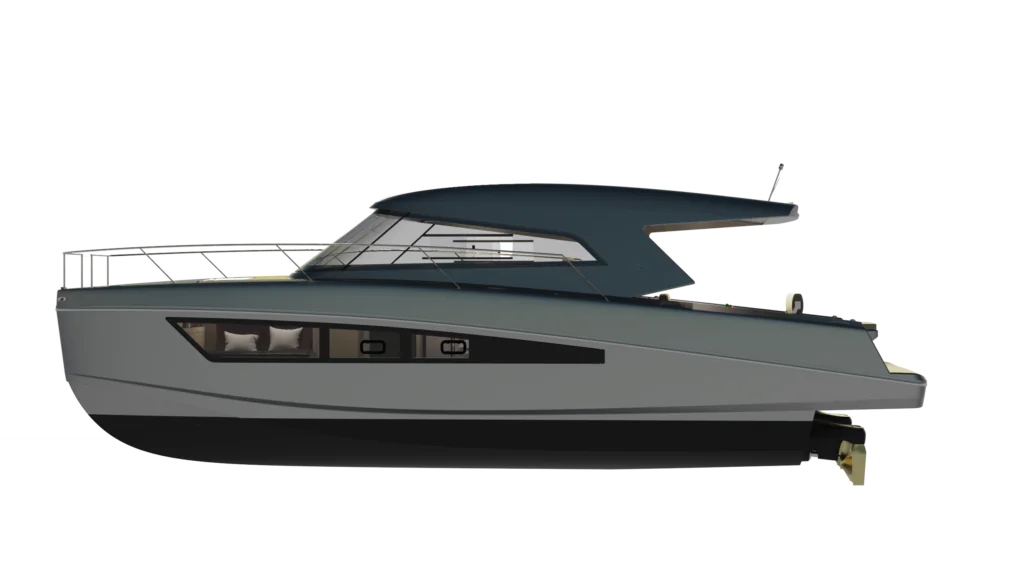
CONCLUSION : Power Catamaran or Monohull?
Whilst each have their own advantages and disadvantages the final choice is completely down to personal preference. Clearly, we are die hard catamaran believers, but we also believe that what is most important above all else is just getting outside and on the water, having fun and being safe. So, when you find the boat that does all of the right things for you, go for it!
Related posts


FUEL EFFICIENCY : Power Catamaran VS Monohull
Thanks to their fine hulls and narrow bow entry a power catamaran hull creates very little bow wake and experiences minimal resistance to get onto plane. The net result of these highly efficient hulls provide powercat owners with lower planning speeds and greater top end performance. This enhanced efficiency results in increased cruising range and significantly greater fuel economy. In comparison to traditional motor yachts, catamarans have a smoother rise in speed and steady fuel burn. In addition powercats experience minimal spikes in fuel consumption throughout the power band. As an added bonus, power catamarans require less throttle to achieve equivalent speeds. This pust less strain on engines, significantly increasing their working life and reducing maintenance requirements and potential failures.

” The power catamaran delivered 36% better fuel efficiency at 3000 rpm “
Thanks to tests performed by Yamaha outboards, the above chart demonstrates the outcome of a like for like test of a 29’ power catamaran vs a 29’ monohull. Both vessels supporting 2x 300hp Yamaha petrol outboards. This chart demonstrates the miles per gallon (MPG) fuel burn at equivalent rpms. What is not immediately obvious in this chart however is that at any given rpm the power catamaran is typically running at a higher speed, we have therefore noted the speeds achieved at 3000 rpm to demonstrate the difference. Across the speed range the power catamaran achieves a similar speed to the monohull at around 500 rpm less.
Why should I care about fuel efficiency?
So what does this really mean? Well let’s consider this data in real life scenario: Miami, Fl to Bimini in the Bahamas is about 50 Nautical Miles. Assuming you were wanting to make the trip and not break the bank you are motoring at 3000 rpm. You would make this trip in 4 hrs in a monohull burning 45 gallons of fuel, at $3.30/gallon that trip will cost you $148.50. In comparison you’ll do the same trip in a powercat in just under 3 hours using 33 gallons for $110. Or, if you are happy spending the $150, you’ll do the trip in just over 1 hour.
Learn more about the MAKAI M37 HERE>>
- Get Newsletter
- Privacy Policy
https://calendly.com/makaiyachts/makai-m37-boat-tour?month=2024-08
Contact ACY
844.567.3087

Power Catamarans vs Sail Catamarans, What’s the Right Choice For You?
- January 13, 2015
Sail and power catamarans are both great boats with distinct advantages. To choose what is best for you, think about how you will be using the boat. The good news is they both work with the Business Yacht Ownership approach.
Sail Catamarans

- Sailboats are better if you want to follow the sun or do longer range cruising.
- With the right prop and engine, sailboats can do 9-10 knots and are very sea-worthy. They provide comfort at sea. If you just feel like laying back and relaxing, you can almost forget the mast is there. But, when the conditions are ideal, you will be able to sail. New designs and technological advancements make sail handling easier than ever.
- Sailboats are quiet and promote socialization. Generally, they can handle more guests at a time, whether they are socializing or sleeping.
- Sailboats cost less per cubic ft. of volume. The Helia 44 has as much or more room/volume than the Cumberland 47.
Power Catamarans

- They have low clearance. If your cruising plans involve a bridge with height restrictions, a power boat may be the better option.
- A properly, dedicated purpose catamaran powerboat gives significantly better speed and range than a comparable monohull powerboat.
- The Fountaine Pajot Motor Yacht offers the exceptional characterics of the catamaran platform, giving you a very comfortable ride and virtually eliminating rolling at anchor.
- The Fountaine Pajot Power cat is less expensive to run than a monohull and can compete with the economy of a trawler. The power cat also offers the efficiency of the hull, which allows you to go faster when you need to (up to 22 knots or so). This is not possible under normal conditions with a trawler or sailing cat.
Learn more about power catamarans
Senior Sales Consultant, Partner [email protected] 410-703-5655 More from Eric >> Boat Business Webinars, Videos, Blogs, Learning center and more.
Disclaimer : The information, views , opinions , and conclusions expressed in any article , blog, video, or other form of media posted or linked herein are those of the authors and do not necessarily reflect the views of Atlantic Cruising Yachts, LLC. Nothing contained herein has been approved or otherwise endorsed by Atlantic Cruising Yachts, LLC and such company shall have no liability for any content.
ESE, LLC is totally responsible for the content of this article. We are not tax advisers. You should obtain tax advice from a professional tax adviser for any matters relating to setting up a business, or tax implications .

About The Author
Related posts.

Your Ultimate Guide: Top 12 Things to Know Before Buying a Catamaran

ACY Yachts to Bring Fountaine Pajot Catamarans to the West Coast

Spring Specials Like You’ve Never Seen Before
ACY Annapolis 312 Third Street, Suite 102 Annapolis, MD 21403
ACY Fort Lauderdale 1800 E Las Olas Boulevard Fort Lauderdale, FL 33301
ACY St. Petersburg 200 Beach Drive, NE, Suite 11 St. Petersburg, FL 33701
ACY Texas 555 Bradford Avenue Kemah, TX 77565
ACY Great Lakes & Ohio 225 West Water Street Sandusky, OH 44870
ACY California 2819 Canon Street San Diego, CA 92106
ACY Toronto 475 Unwin Ave Toronto, ON M4M 3M2
ACY Caribbean 3562 Honduras #4, Frenchtown Marina St. Thomas, VI 00802
Quick Links
All the images are the property of Yacht Sales Management, LLC d/b/a Atlantic Cruising Yachts (ACY) and/or used with permission. Yacht Sales Management, LLC (“YSM”) maintains this website to provide general information about ACY and its Boat as a Business® and Business Yacht Ownership® approaches, and Waypoints® charter management. The materials on this website are for informational purposes only and do not constitute accounting or tax advice. Persons receiving information through this website should not act or rely upon this information without consulting their own accountants or tax advisors. YSM neither accepts requests for accounting advice or services nor offers accounting advice or services through this website. Communication with YSM through this website, by email or otherwise, does not create an accountant-client relationship. YSM makes no representations or warranties of any kind, express or implied, as to the operation or content of this site. YSM expressly disclaims all other guarantees, warranties, conditions and representations of any kind, either express or implied, whether arising under any statute, law, commercial use or otherwise, including implied warranties of merchantability, fitness for a particular purpose, title and non-infringement. In no event shall YSM or any of its members, officers, employees or affiliates be liable, directly or indirectly, under any theory of law (contract, tort, negligence or otherwise) to you or anyone else, for any claims, losses or damages, direct, indirect, special, incidental, punitive or consequential, resulting from or occasioned by the creation, use of or reliance on this website (including information and other content) or any third-party websites or the information, resources or material accessed through any such websites. The materials on this website are provided only as general information which may or may not reflect the most current legislative or regulatory requirements or the requirements of specific industries or of states. Readers should not act upon this information without consulting their own accounting advisor.
© Atlantic Cruising Yachts, LLC. All Rights Reserved.

IMAGES
VIDEO
COMMENTS
Power Cat Con: Some power catamarans "sneeze," when compressed air in the hulls blows a mist back out of the tunnel. This can make for an overly-moist ride. Monohull Con: Many monohulls take more spray over the bow. This depends quite a bit upon the conditions and direction of the wind and waves, but generally speaking, monohulls are going ...
Attach one line to each of the forward cleats and bring the loose ends to the center. Pick up the mooring with a boathook. String one line through the eye and bring it back to the same cleat. Repeat on the other side, keeping the lines the same length so the cat is centered.
This has been objectively measured (with accelerometers) in a Glacier Bay 26 powercat versus a Regulator 26 monohull—both boats known for providing an excellent ride—to the tune of a .287-second deceleration versus a 0.081 second deceleration, and a three-G force impact versus a four-G force impact when hitting an identical wave head-on.
Recreation In a Monohull vs. a Catamaran. Most sailors agree that sailing a monohull boat is much more exhilarating than sailing a catamaran. Traditional sailboats heel, and sailors get instant feedback while they're sailing. For the most part, catamarans stay stable, and you don't get the same feeling with the movement of the wind and the ...
The most compelling argument of all must be this: seasoned monohull boaters are converting to catamarans by the truckload. Many converted former motor yacht owners are now passionate advocates of power catamarans. For experienced yachties demanding performance, the advantages are simply too great to ignore. It is rare to hear of any catamaran ...
Upwind sailing performance: While catamarans have the edge at straight-line speed, monohulls sail closer to the wind. When you're racing or you have to sail upwind to get to the next island, this can get you there faster. Sailing feel and responsiveness: The "feel" of sailing a monohull is much better.With a single hull, you'll feel wind pressure and trim adjustments immediately for a ...
Compared square-foot-for-square-foot, catamarans are much lighter than monohulls, which means they also slow down a lot quicker. For the most part, catamarans are easier to dock than monohulls, as they have two motors and two rudders which simplify things a lot. This also does away with the need for a bow thruster.
7. Shallow Draft Equals Better Anchorages. Catamarans have significantly shallower drafts than monohulls, allowing for safer anchorages closer to shore. Most catamarans in the 40-ft to 50-ft range draw between 3-ft to 4.5-ft, so they can anchor in places that a monohulls can not even consider.
Monohull sailboats have their own groove. This motion is predictable and distinguishable by pro sailors. Cats, on the other hand, depend on the body of water's condition state. Also, cats pound when going upwind into big seas if their bridge deck is pummeled by waves, while monohulls tend to slice through the waves.
A catamaran is also much more fuel efficient on average than a monohull, due to the decreased amount of drag on it's much slimmer hulls. However, monohull yachts are capable of handling larger, more powerful engines, and thus usually have a considerably higher top and cruising speed than catamarans. As for living space, it depends on which ...
We help you determine if a catamaran suits your boating style better than a deep-V monohull. Ever since the Polynesians started crossing oceans on catamarans when much of the "civilized" world was still afraid of the sea, the idea of the twin hull has ebbed and flowed in popularity. For centuries in the Western world, the monohull ruled the ...
DP: Due to their lower wetted surface area, catamarans are certainly faster, but you pay the price with a slapping and uncomfortable ride. Monohull designs work harmoniously with the elements instead of trying to fight them. Sailing catamarans are inefficient upwind and tack very slowly. 3. FUEL.
Additionally, the popularity and demand for catamarans can also impact their pricing. Maintenance costs can be higher for catamarans compared to monohulls. Catamarans typically have more deck space, more systems and equipment, and two hulls to maintain, which can result in increased maintenance and repair expenses.
World Cat Powered Catamarans vs Monohull. Because you get a smoother ride. The wider footprint of a World Cat helps negate the effect of a rolling. Take a Se...
Catamaran vs Monohull Safety. The mono gives lots of feedback about being overpowered long before it becomes a problem: heel angle and weather helm are the loudest. The cat is much more subtle: mast and boom groans, light windward pontoon, lack of steerability. Experiment with the main traveller position and reefing on a schedule per the owners ...
Speed. In the catamaran vs monohull speed debate, it might be more of a draw. Catamarans are typically 25-30% faster than a comparable monohull, but some argue that it comes at a price. When catamarans are sailing full speed you might experience a lot of slapping from the waves. Monohulls are designed to cut through the water.
One of the most significant decision points when thinking about catamarans versus monohulls is your budget. If your budget is under $100,000, a monohull will be your best bet. If your budget is between $100,000 and $250,000, you can consider a smaller, older catamaran. Catamarans such as PDQs, Prouts, and Geminis will be in your budget.
While monohulls roll back and forth far more than a catamaran, monohull fans will argue that the slow roll period of a monohull has a comforting effect. There any many brands and builders to choose from as most builders still only produce monohulls. Whilst this trend is changing, 50+ years of composite boat building has been heavily monohull ...
" The power catamaran delivered 36% better fuel efficiency at 3000 rpm " Thanks to tests performed by Yamaha outboards, the above chart demonstrates the outcome of a like for like test of a 29' power catamaran vs a 29' monohull. Both vessels supporting 2x 300hp Yamaha petrol outboards.
Sail catamarans have many benefits that make them wonderful boats. Sailboats are better if you want to follow the sun or do longer range cruising. With the right prop and engine, sailboats can do 9-10 knots and are very sea-worthy. They provide comfort at sea. If you just feel like laying back and relaxing, you can almost forget the mast is there.
Comparing Power and Performance. One of the biggest differences between cats and monohulls is the requirement for at least two engines on a catamaran. For smaller deep-vee boats up to 26 feet or so, you could use a single 300 or 350 hp outboard. A cat of the same size might be powered by twin 150 or 200 hp engines.
Part 2 right here: https://youtu.be/05E-Qv6BVfgA debate as old as time itself! Which is better, a catamaran or a monohull? I'll give away the answer here: l...
If you buy new, you're looking at a starting price of about $250,000. For a brand new 40ft cat, you're looking at a starting price of about $400,000. Of course, you can buy a used, older catamaran, too. There's the Prout Snowgoose 37, the Lagoon 380, and the PDQ 36. Any of these can be purchased for under $90,000.